MASON, GEORGE (1830-1862). Private, 6th New Jersey Infantry, Company C. A native of New Jersey, he enlisted on August 9, 1861, and mustered into the 6th New Jersey on August 24. Wounded at the Battle of Second Bull Run, Virginia, on August 29, 1862, he died at College Hospital in Georgetown, D.C., on September 11. The cause of death as indicated in hospital records was “vulnus sclopet” or gunshot wound. Although some records incorrectly indicate that he is buried at the Military Asylum Cemetery in Washington, D.C., he was interred at Green-Wood on October 3, 1862. His obituary in The New York Times on October 3, 1862, which confirmed his death at Manassas, Virginia, notes that he was a Freemason with membership in two lodges and was a member of Manhattan Engine Company #13; comrades were invited to attend his funeral at the John Street M. E. Church. Section 1, lot 7751.
Civil War Bio Search
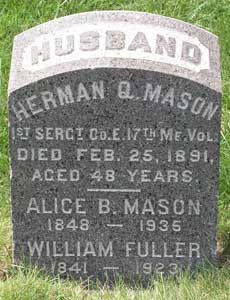
MASON, HERMAN Q. (1842-1891). First sergeant, 17th Maine Infantry, Company E. Mason was born in Yarmouth, Maine. A resident of Portland, Maine, and a printer by trade, he enlisted as a sergeant and mustered immediately into the 17th Maine on August 18, 1862. According to his muster roll, he had hazel eyes, black hair and a dark complexion. He was detailed in 1863, promoted to first sergeant sometime that year, and discharged on December 31, 1863. Mason apparently re-enlisted because the United States Army’s Record of Enlistments indicates that he was discharged at Washington, D.C., on October 5, 1865.
The 1870 census and the 1884 New York City Directory report that Mason was a printer. The Veterans Census of 1890 confirms his Civil War service. As per his obituary in the New York Herald, he was a member of Typographical Union No. 6 and the Knights of Honor, a fraternal and secret society known for its benefits; members of both organizations were invited to attend his funeral. He last lived at 450 West 50th Street in Manhattan. Alice Mason, who is interred with him, applied for and received a widow’s pension in 1891, certificate 333,293. Section 206, lot 21347.
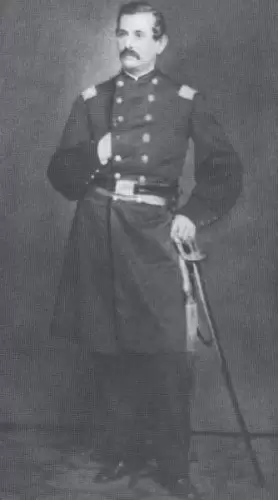
MASON, JOEL W. (1821-1894). Colonel, 6th Regiment, New York State National Guard. A native of Princeton, Massachusetts, Mason moved to New York City in 1843 where he established a furniture manufacturing business that bore his name and was located at 375 Pearl Street in New York City. (See letterhead below.) The 1860 census lists him as a chair manufacturer. At the beginning of the Civil War, he was commissioned as a first lieutenant and adjutant in the Field and Staff of the 6th Regiment on May 24, 1861, and mustered out on July 31. He returned to the 6th Regiment as its colonel on May 22, 1863, and mustered out on July 22, 1863. The regiment, although federalized, saw no fighting. As per his obituary in The New York Times, which confirms his Civil War service, he remained its colonel until 1875.
Mason’s passport application of 1867 reports that he was 5′ 8½” tall with a long neck, hazel eyes, black hair, dark complexion, round chin and oval face. According to the 1870 census, he was living in Chautauqua, New York, where he was a furniture manufacturer. Active in Republican politics, he was president of the Seventeenth District Republican Association for twelve years and was chairman of the County Committee for several years. In addition, he was a school trustee of the Twentieth Ward for twelve years and member of the Board of Education. Mayor Edward Cooper appointed Mason as New York City Police Commissioner in May 1880, a position that he held for more than four years and which he indicated on the 1880 census. He was also president of the 17th District Republican Association for 12 years. Mason last lived in the Catskill Mountains region of New York and died of heart failure in Hunter, New York. In 2014, the Horse Soldier, an antique store in Gettysburg, Pennsylvania, specializing in military antiques, offered for sale Mason’s brown cloth book, “1861 Army Regulations,” a 457 page volume with an appendix and inscribed with his name in ink on the inside front cover. Section 26, lot 5675.
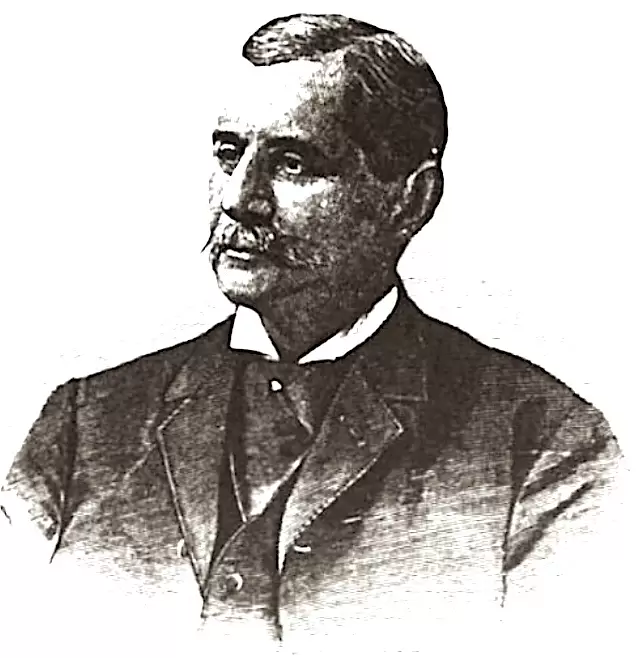
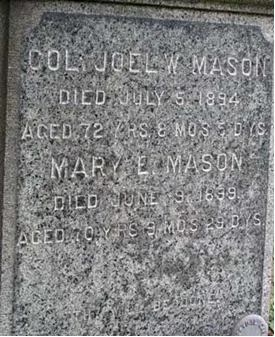

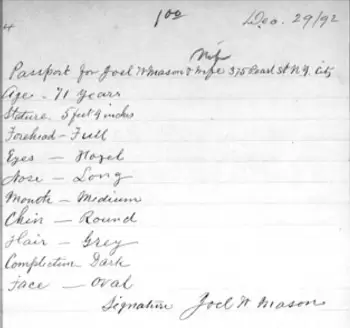
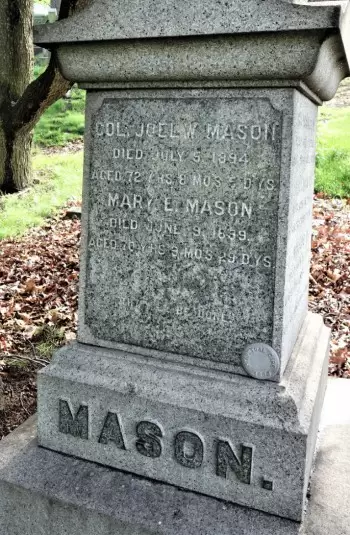
MASON, JOHN J. (1843-1917). Private, 15th New Jersey Infantry, Company C; 2nd New Jersey Infantry, Company D. A Brooklyn native, Mason enlisted as a private on October 10, 1864, and mustered that day into the 15th New Jersey Infantry. On June 21, 1865, he transferred into the 2nd New Jersey Infantry from which he mustered out on July 11, 1865, at Hall’s Hill, Virginia. A longtime resident of Newark, New Jersey, he was a member of that city’s Volunteer Fire Department. In civilian life, he was a confectionery manufacturer whose business was located on Norman Avenue in Morristown, New Jersey. In 1902, his application for an invalid pension was approved, certificate 1,048,112. At the end of his life, he was a resident at the Soldiers’ Home in Kearny, New Jersey. His last residence was 200 North Henry Street in Morristown, New Jersey; he died at a hospital in that town. Mason’s funeral was held at the Union Baptist Church in his hometown. Section 20, lot 5424.
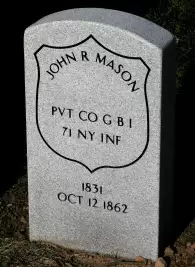
MASON, JOHN R. (1831-1862). Private, 71st New York Infantry, Companies I, B, and G. Mason enlisted as a private at Great Valley, New York, on May 1, 1861, and mustered into Company I of the 71st New York on June 27. He also served in Companies G and B of the regiment. His death on July 11, 1862, was due to chronic pneumonia. The muster roll notes that he was hospitalized in both Philadelphia and New York City. Section 115, lot 13536 (Soldiers’ Lot), grave 41.
MASON, JR., NEHEMIAH (1835-1862). Private, 84th New York (14th Brooklyn), Infantry, Companies D and E. Born in Brooklyn, Mason enlisted there on August 28, 1862, mustered into Company D of the 14th Brooklyn the next day, and transferred into Company E on November 14, 1862. According to his muster roll, he had gray eyes, brown hair, and was 5′ 8 1/2 inches tall. On December 18, 1862, he died from “exhaustion” in camp at Falmouth, Virginia, and was buried at Green-Wood on December 28. Information about his death is inscribed on his tombstone. Section 81, lot 1204.
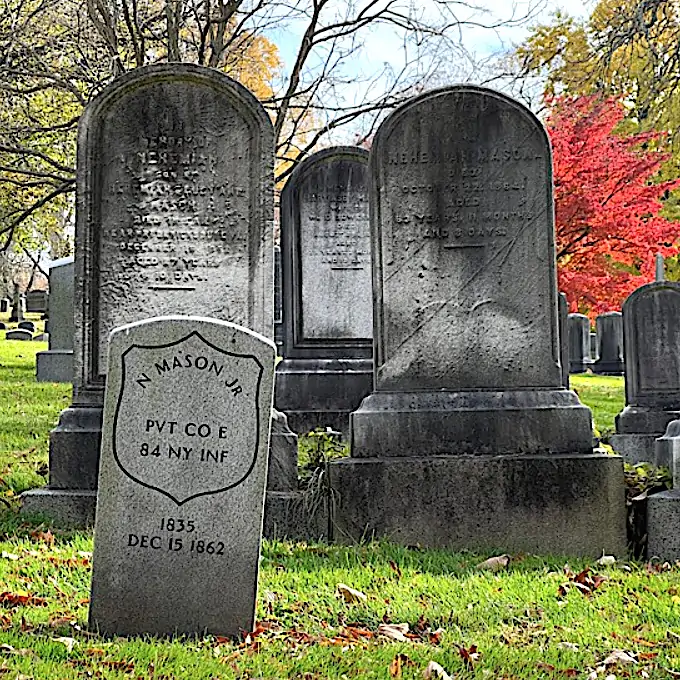
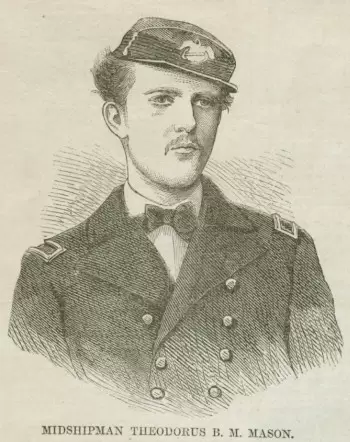
MASON, THEODORUS BAILEY MYERS (1848-1899). Midshipman, United States Navy. Born in New York at 132 Fifth Avenue near 18th Street, his father, Theodorus Bailey Myers (see), was a lawyer who served during the Civil War and his uncle, Rear Admiral Theodorus Bailey, served under Admiral David Farragut at New Orleans. Mason was given his surname out of respect for his maternal grandfather, Samuel Mason, who had lost his only son. The young Theodorus was very close to his grandfather, who was very devoted to him. As per the family papers, Biographical Sketches of the Bailey-Myers-Mason Families, 1776 to 1905 (privately published in 1908), “young Theodore” (a nickname that distinguished him from his father) and his grandfather rode horses together with Theodore riding a small white pony brought from the West Indies. The Myers family had a summer home, Elm Spring, in Spuyten Duyvil, where Theodore learned swimming, rowing and sailing. Well educated, Theodore spoke French fluently, practicing with the family’s French nurse and French butler, and attended the Charlier Institute, a boys’ school in New York.
Upon deciding that a career in the Navy was the path that he wished to follow, Mason traveled alone to Washington, D. C., had new visiting cards commissioned when he realized that he had forgotten his, then met with Assistant Secretary of the Navy Department Gustavus Fox and asked for an appointment to the Naval Academy (then at Newport, Rhode Island) which he soon secured. The family papers report that this was a most auspicious time to be at the Naval Academy because the young officers returning from the Civil War were “flushed with the enthusiasm of victory and ready to bend all their energies to teaching the rising generation how to go and do likewise.” A midshipman as of September 20, 1864, enlisting at Rhode Island, he graduated from the Naval Academy in June 1868, number twenty in his class, and was detached to the South Atlantic Squadron aboard the flagship Guerriére. A friend said of Mason after his death, “The records of the Navy Department show that from this time forward he was in position of importance affording ample opportunity for the exercise of talents which qualified him for the highest usefulness.”
In 1868, Mason rescued two drowning seamen in the harbor off Rio de Janeiro, Brazil and was awarded the Order of the Rose from Dom Pedro, the Emperor of Brazil, an honor he was allowed to accept by a special Act of Congress. In addition, he received a gold medal from the New York Benevolent and Life Saving Institution for saving lives and for improvements in life saving apparatus. These were the first of twenty lives that he saved during his career. Subsequently, he joined the European fleet, became an ensign on April 19, 1869, then served on the USS Franklin. He rose to master on July 12, 1870, was attached to the Navy Department’s Hydrographic Office in 1871 and while on duty there, was detailed to accompany General Ulysses S. Grant to Boston in 1872. He was later a social aide to President Grant. He became a lieutenant on November 20, 1872. In 1875-1876, he was an instructor of French at the Naval Academy at Annapolis and then, an instructor of Ordnance and Gunnery.
During his tenure in the Navy, Mason’s special focus was intelligence, He travelled extensively in Europe and South America and determined that it was important to encourage research in naval science and technology to compete with Europe. He urged the creation of a unified intelligence system to gather information on foreign developments and to disseminate the data to the appropriate agencies. On March 23, 1882, Secretary of the Navy William H. Hunt issued General Order No. 292 establishing the Office of Naval Intelligence as part of the Bureau of Navigation and appointed Mason as the Chief Intelligence Officer as of June 1882. In spite of a rocky start, the different bureaus soon realized that the centralized system was an effective conduit for sharing information and getting expenditures for expansion and modernization. Mason remained in charge of the Department until 1885. He subsequently was detached to the Isthmus of Panama, where he was treated for malarial fevers, then travelled to the Far East and wrote a textbook on Ordnance and Artillery Tactics. Mason mustered into the G.A.R. on September 26, 1889. He resumed duty at the Navy Department from 1889-1891 and superintended the construction of the USS New York in 1893. His medical records from the Navy indicate that he suffered from hand paralysis as a result of exposure during the time he was detached to the USS New York; that condition was indicated on his death certificate as a contributing factor. Mason was promoted to lieutenant commander on January 23, 1894, then placed on the retired list as of December 8, 1894.
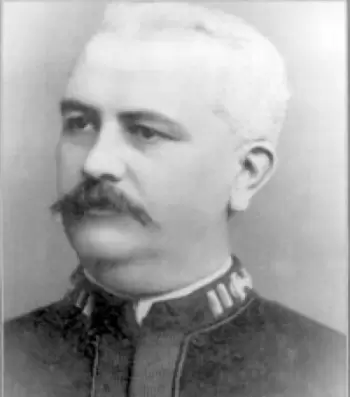
As per his obituary in the Elmira Daily Gazette and Free Press, Mason died from a hemorrhage after his tooth was extracted, although his death certificate indicates apoplexy. On the day of his funeral, the shops in Saugerties, New York, where he had a summer home, closed their doors, church bells rang and a number of officers from the USS New York, on which Mason had been the executive officer, and the USS Massachusetts, at anchor in the Hudson River, met the funeral cortege. A Naval escort led the procession to Green-Wood and the Mason family mausoleum. Mason’s draped casket was borne by sailors, three volleys were fired, and the bugler played “Taps” in tribute. A Naval friend said of him after his death, “Generous to a fault, always ready to help those in trouble, beloved by all who knew him well, had his health permitted and an opportunity offered in the war with Spain, no man would have brought more credit to his country’s flag and profession, than T. B. M. Mason.”
A friend said of him in his obituary in the New York Herald, “Lieutenant Commander Mason’s career, his work on Gunnery, and his acts of chivalrous heroism need no comment. It is because of such men as he that our country’s Navy has received so many tributes of unfeigned admiration and respect.” After his death, his military memorabilia and those of his father were donated to the United States National Museum. He last lived in Saugerties, New York. His widow, Edmonia Mason, applied for and received a pension from the Navy in 1899, certificate 13,541. On October 14, 1901, a memorial window commissioned by his widow was unveiled as an altar piece in the old brick church at the Naval Academy; when the church was demolished, the window was removed for placement at the new chapel. The window, in Tiffany glass, pictured Sir Galahad and the coat of arms of the Mason family. Section 47, lot 10334.
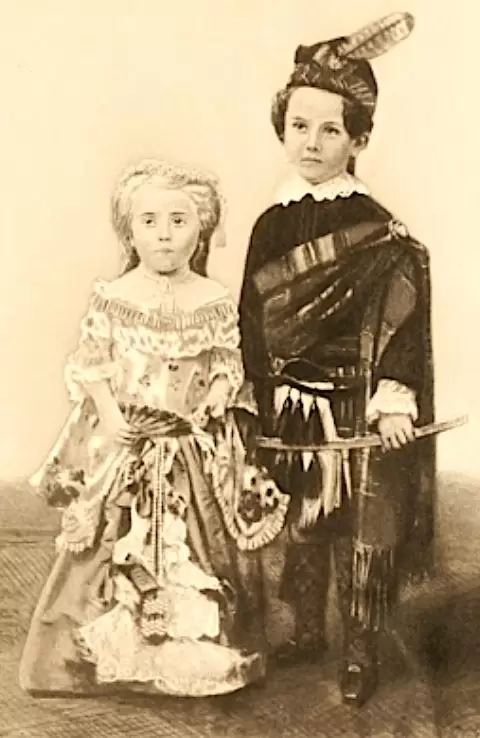
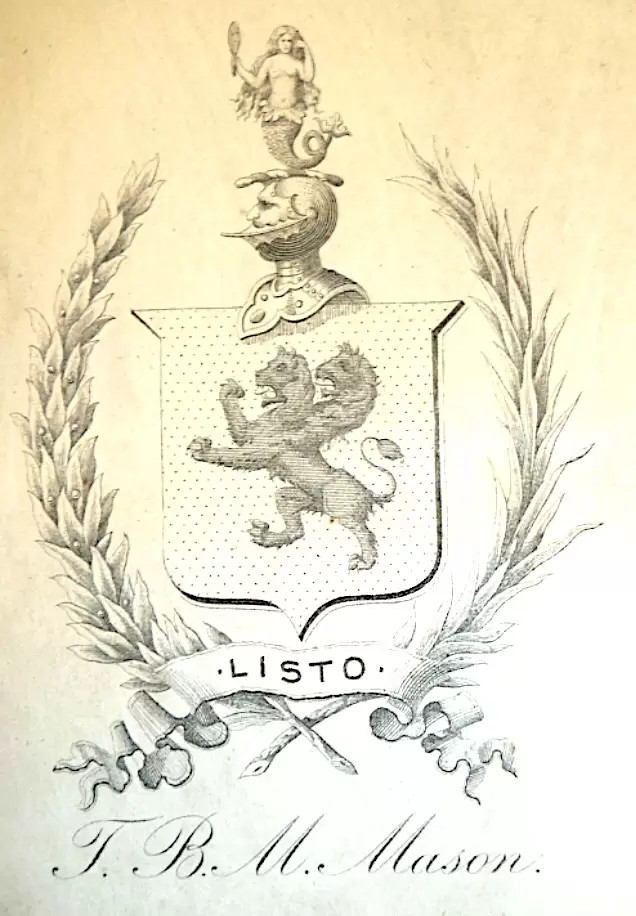
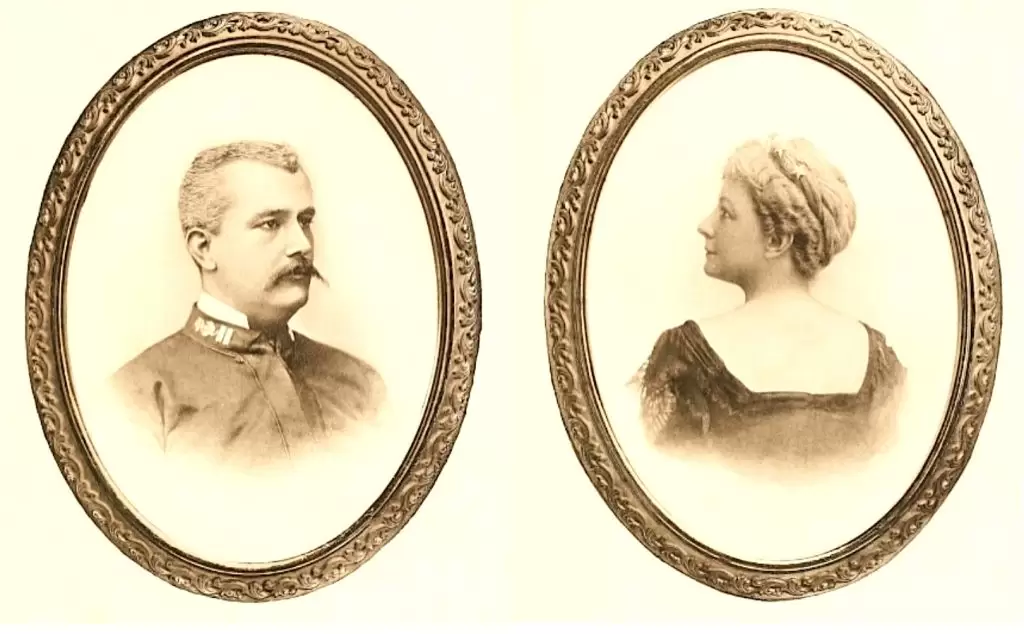
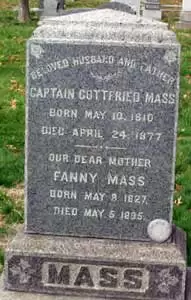
MASS, GOTTFRIED (1810-1877). Captain, United States Rifles, Company A; 58th New York Infantry, Company G. Mass was born in Poland and immigrated to New York City on August 17, 1848, at which time he listed his trade as engraver. The 1860 census lists him as an engraver with a personal worth of $300. After enlisting at New York City on September 10, 1861, he was commissioned into the United States Rifles three days later, and was transferred into the 58th New York on November 23, 1861. An article in The New York Times about the 58th Regiment published on November 9, 1861, which listed Mass as a captain, described the 900 men in the regiment, “All are fine, healthy-looking young fellows, and are armed with the Enfield rifle. Attached to the regiment is a fine band. The Fifty-eighth is composed of Italians, Germans, Poles, French, Danes and Russians.…” As per his muster roll, Mass was detached to New York City for recruiting duty on July 5, 1862. He resigned on April 4, 1863, and was discharged on April 8 at Stafford Court House, Virginia.
The 1870 census indicates that Mass was an engraver with a personal worth of $1,000. He last lived at 136 Colyer Street in Brooklyn. His death was attributed to rheumatism. Originally interred at Cypress Hills Cemetery, he was re-interred at Green-Wood on November 10, 1890, where his tombstone is inscribed with his rank. In 1890, Fanny Mass, who is interred with him, received a widow’s pension, certificate 320,222. Section 166, lot 27346.
MASSETT, BENJAMIN W. CAREY (1817-1863). Major, United States Volunteers Paymaster’s Department. Originally from Middlesex, England, he is listed on the Non-Conformist and Non-Parochial Registers, 1567-1936, of England and Wales. He immigrated from London to New York City aboard the ship Vibilia in 1837; on the ship’s manifest, he is recorded as a cabin passenger and a “gentleman.” Benjamin (identified as “of the Alexander Classical School”) and his wife, née Harriet Hart, were married in Batavia, New York, on February 17, 1838, as per 10,000 Vital Records of Western New York, 1809-1850. They had their only child, William (see), the next year. Benjamin became a naturalized citizen on October 26, 1844.
In 1851, Benjamin co-founded the Massett and Villeplait School; he was listed as a professor on the 1850 census and a linguist on the 1855 New York States census. The 1860 census indicates that he was a teacher of languages. In 1859, an advertisement for this “Classical, English, and French school” at 1057 Broadway, between 29th and 30th Streets, touted it as “for the instruction personally by them of twenty-five boys, in the Latin, Greek, and French Languages, Mathematics, English and English Literature, with special reference to college or commerce . . . . Their instruction was described as “individual, thorough, complete, systematic, disciplinarian and philosophical.”
His only child, William (see), was killed in battle on June 1, 1862. The Buffalo Commercial reported that “The death of his brave son, so far from disheartening Massett, only served to fire his heart with greater enthusiasm and increased loyalty.” According to the Commercial, Benjamin dedicated himself to “declaring his desire to take an active personal share in the great struggle.” So, though 45 years old, relatively old for military service, he enlisted on November 26, 1862, as a major, and was commissioned that day into the United States Volunteers Paymaster’s Department as a major and additional paymaster. Sadly, he died from dysentery in Memphis, Tennessee, on July 15, 1863, at the officer’s hospital. One report of his death stated that he had typhoid fever. A report described “the faithful performance of his duties” and noted that he “died, as he had lived, true, faithful, loyal.”
Harriet, having lost her husband and her only child to the war, remained at the West 20th Street house. In 1862, apparently alone there, she advertised “a furnished back parlor on the first floor to let to a gentleman and wife or to a single lady, with privilege of cooking in the basement.”
Originally interred in lot 3890, Benjamin’s remains were re-interred at their present location on July 15, 1864. His widow, Harriett Massett, who would ultimately be interred with him, applied for a pension after losing her husband a year after the death of William, her only child. She received a widow’s pension in June 1864 for $25 a month, certificate 24,939. Harriet died in 1898 at the age of 79; her “late residence” was listed as 456 West 34th Street in Manhattan. Her cause of death was noted in cemetery records as “age.” Section 162, lot 15062.
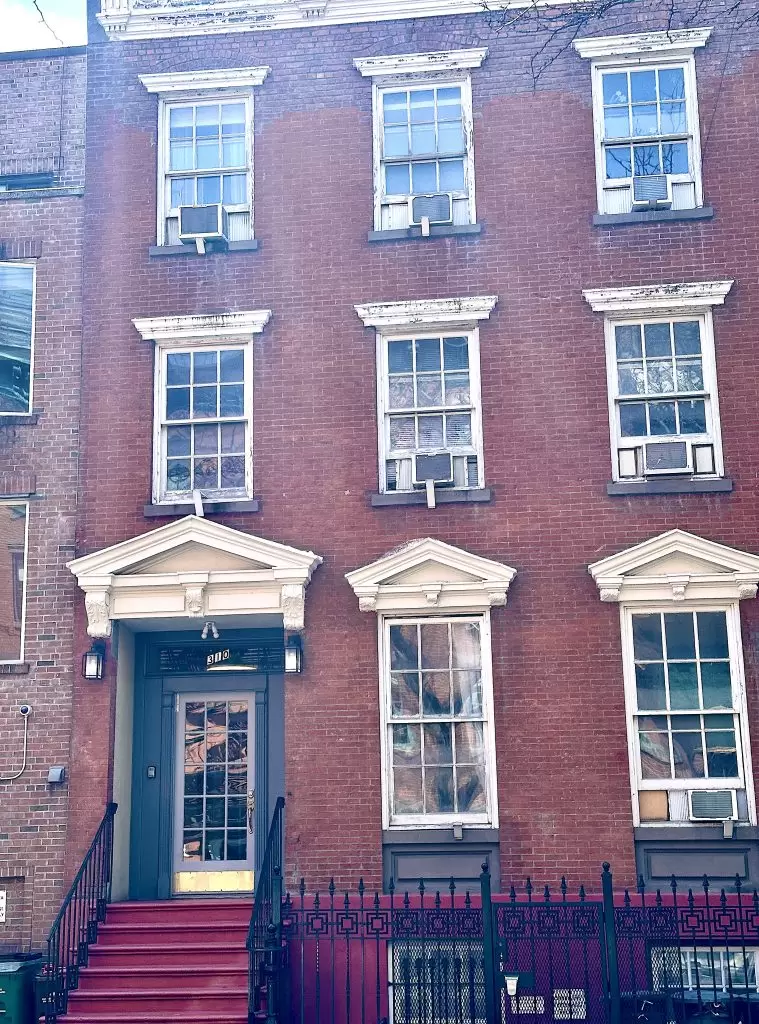
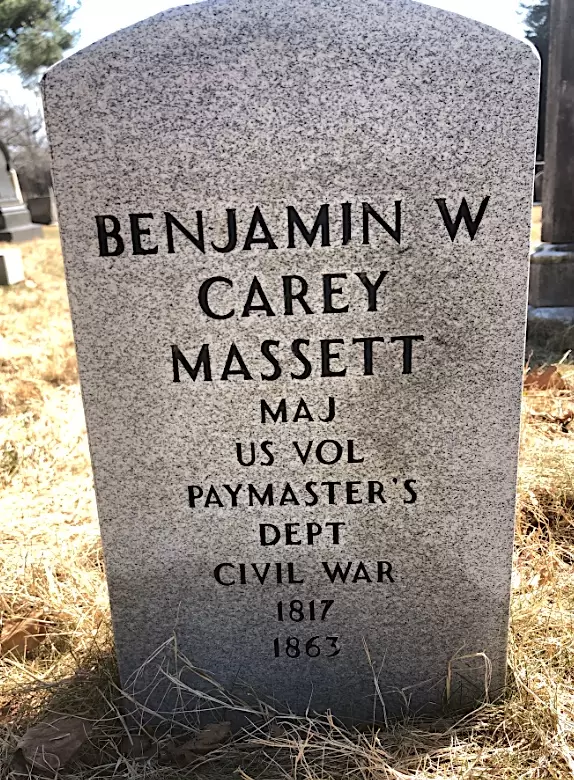
MASSETT, WILLIAM CAREY (1839-1862). Lieutenant colonel, 61st New York Infantry, Company B. A New York City native, Massett was a gifted young man who is listed in the 1855 yearbook of Columbia College as a sophomore living at 109 West 20th Street in Manhattan. He graduated with highest honors from Columbia College in 1857. His obituary in Frank Leslie’s Illustrated Newspaper on July 12, 1862, noted that he was admired for “singular excellencies of heart and head.” His academic interests were far-reaching. “Few youths possessed the social characteristics of the deceased. A superior classical scholar, and no mean mathematician, he had few superiors as a French, German, and Spanish scholar. He had also a rare taste for music, and as a pianist had achieved a remarkable proficiency.” The Buffalo Commercial described him as “a noble youth . . . of high scholarly acquirements.”
In 1858 through 1859, William was in China under the auspices of the trading house of Russell & Co., a leading firm, where he pursued a career in commerce. At the onset of the Civil War, he rushed home from China and formed a company of the Clinton Guard, the familiar name of the 61st Regiment. A resident of Rhinebeck, New York, Massett enlisted as a captain on July 29, 1861, at New York City, and was commissioned into the 61st New York on September 19. As per his muster roll, he was a clerk who was 5′ 10″ tall with blue eyes, brown hair and a light complexion. He was rapidly promoted, rising to major on November 9, 1861, transferred to the Field and Staff on that day, and rose to lieutenant colonel—second in command of the regiment–on May 13, 1862. On June 1, 1862, he led the 61st into action at the Battle of Fair Oaks, in Virginia; just 23 years old, he was killed there.
As The New-York Herald reported on June 16, 1862,
His conduct at Fair Oaks has been mentioned very highly. For three whole hours he handled his regiment with such excellent skill as to hold at bay three rebel regiments. He was struck in the forehead by a rifle shot, while in communication with the commander of the Sixty-fourth New York regiment on business connected with the battle.
The report of his death in Frank Leslie’s Illustrated Newspaper noted that after two balls flew past him as the battle raged, he ironically remarked, “They must aim better than that” and was struck by a rifle ball, dying instantly. His remains, as per the Bodies in Transit records, arrived back in New York City on June 14, 1862; his funeral was held, and he was interred at Green-Wood on June 15. The New York Evening Press reported on his funeral:
MILITARY FUNERALS.-These solemn pageants have become common with us, but their frequency cannot fail to impress the spectator deeply now, as every cortége moves on to the grave with some brave man of that host of the nation’s defenders, in whom every family in the city is interested from ties of consanguinity or friendship. There were several such processions in this city yesterday. The most imposing of these funerals was that of Lieutenant Colonel William Carey Masset (sic), Sixty-first regiment New York Volunteers. The deceased was well known in the mercantile circles of this city, being the son of B. W. C. Massett, and having been engaged in the China trade for a considerable period with one of the most extensive firms in this city. He was a graduate of Columbia College, and only a little over twenty-three years of age at the time of his death….
Originally interred in lot 1000, his remains were re-interred in their present location on July 15, 1864. Although his mother, Harriett Massett, applied for a pension on December 8, 1862, application 7,749, it was never certified. Section 162, lot 15062.
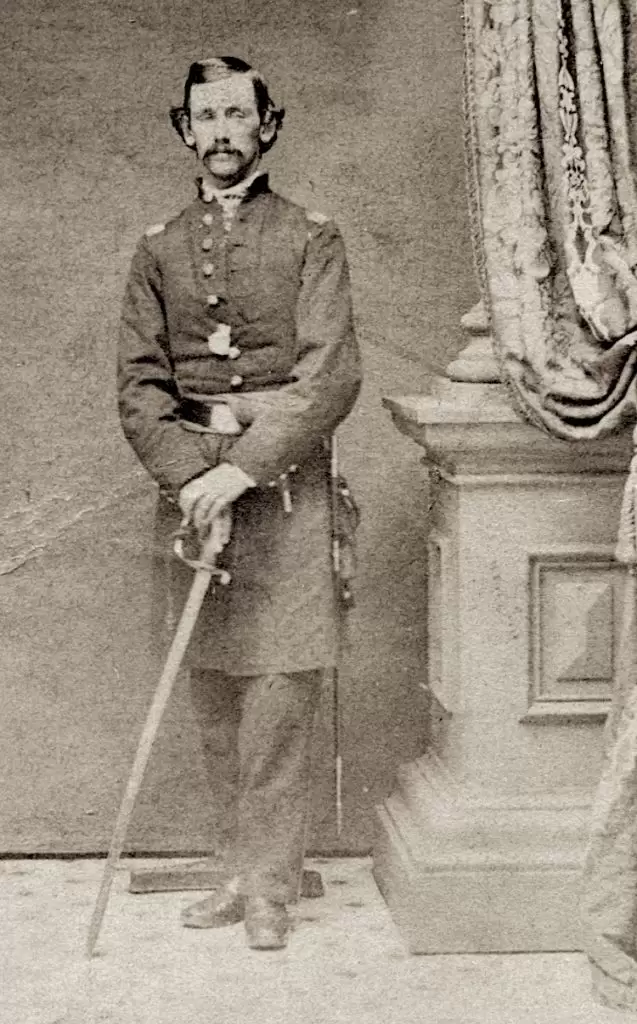
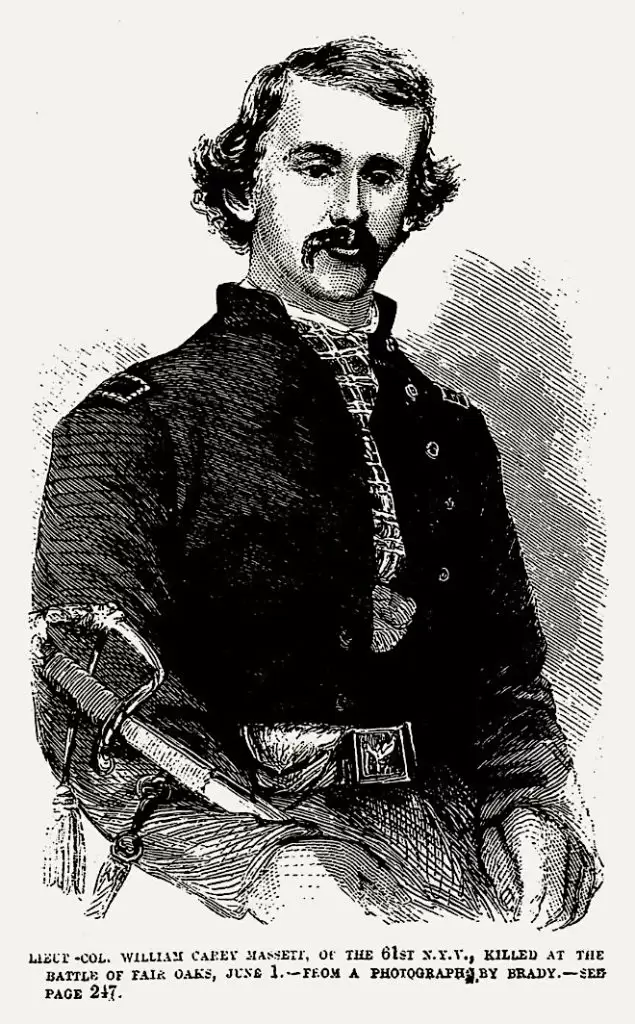
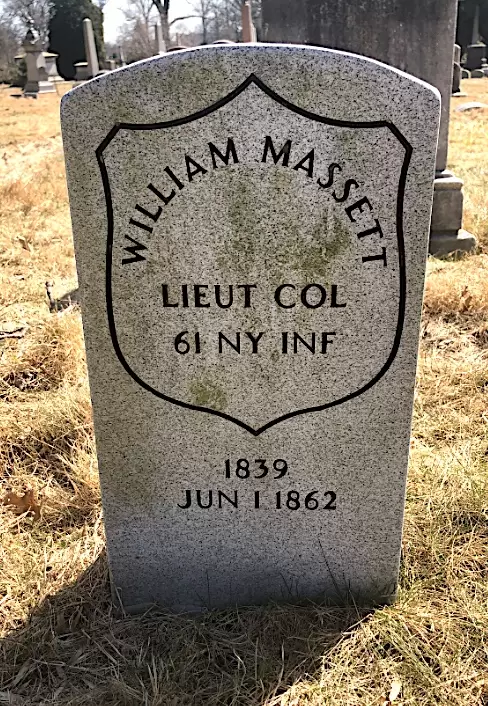
MATHER, DE WITT CLINTON (1831-1894). Sergeant, 7th Regiment, New York State National Guard, Company H. Born in New York City and listed as a student on the 1850 census, Mather was a graduate of Princeton, class of 1852. As per the Trenton State Gazette, he delivered the “Honorary Essay” at his commencement ceremony. In 1855, he was employed as a clerk in his father’s ink business.
During the Civil War, Mather enlisted in 1861 as a private and served for 30 days with 7th New York State Militia. In 1862, he returned as a sergeant to the 7th Regiment, now part of the National Guard, for three months, and served again in 1863 for 30 days as a corporal. After the War, he continued working in the family ink business, George Mathers & Sons. Mather applied for and was granted an invalid pension in 1890, certificate 729,691. He was living in Bound Brook, New Jersey, at the time of his death from acute meningitis. His home, “The Cedars,” was set on a hillside and offered a beautiful mountain view, a fine library and furnishings, and land for sporting activities. In his later years, Mather was in poor health and the “country life” was prescribed for him. His widow, Margaret H. Mather, applied for a pension in 1896, application 628,197, but no certificate number is noted. Section 170, lot 13517, grave 7.
MATHESON, ALEXANDER ROSS (1844-1929). Private, 1st Michigan Engineers, Company H. A Michigan native. Matheson lived in Jackson County, Michigan, when he enlisted as a private on October 16, 1861, at Sandstone, Michigan. On October 29, he mustered into the 1st Michigan Engineers from which he was discharged for disability on May 3, 1862, at Nashville, Tennessee. A physician, he was educated at the University of Michigan before he relocated to Brooklyn. He was a member of the Montauk Club in Brooklyn, Medical Society of the State of New York, Gynecologists’ Society, and the University of Michigan’s Alumni Association. In addition, he belonged to the G.A.R. In 1907, his pension application was granted, certificate 1,140,926. His last address was 37 Seventh Avenue, Brooklyn. His death was caused by senility. Section 76, lot 6163.
MATHEW, ANDREW (1827-1865). Artificer, 15th New York Engineers, Company C. Mathew, a native New Yorker, enlisted as a private at Brooklyn on April 1, 1861, and mustered into his company the same day. He re-enlisted on March 1, 1864, was promoted to corporal on March 10, 1864, but reduced in rank to private on April 1. Mathew was promoted to artificer on October 1, 1864, and mustered out on June 13, 1865, at Fort Barry, Virginia. Section 168, lot 15919.
MATHEWS, EDWARD (1838-1897). Seaman, United States Navy. According to the inscription on his government-issued gravestone, Mathews served in the Navy during the Civil War. Further details are not known. His last residence was 250 Bedford Avenue in Brooklyn. Section 134, lot 29725, grave 371.
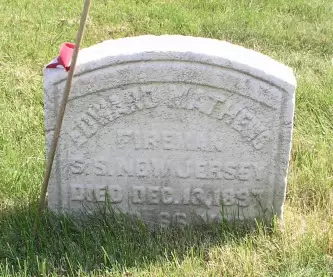
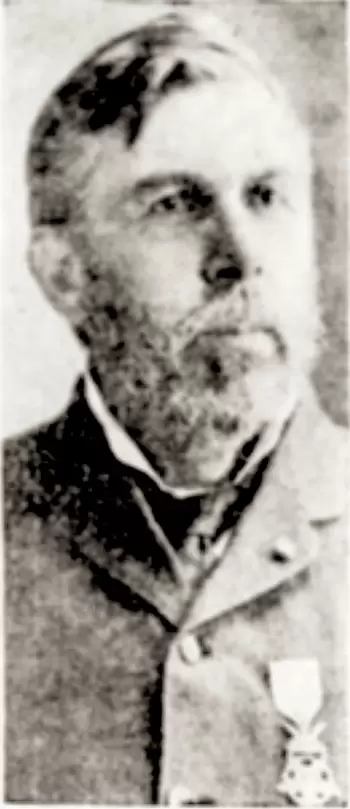
MATHEWS, WILLIAM HENRY (enlisted as SIVEL, HENRY) (1844-1928). Medal of Honor recipient; sergeant, 2nd Maryland Veteran Infantry, Companies E and I. Born in Devizes in Wiltshire, England, he immigrated to the United States in 1852. Mathews enlisted as a private on July 23, 1861, at Baltimore, Maryland, as Henry Sivel, and mustered into Company E of the 2nd Maryland on that day. He was wounded three times during the Civil War, the first at the Battle of Second Bull Run on August 29, 1862. One tribute to him, NCO Essay: Amid Chaos and Calamity, Soldier Earns Honor by Staff Sgt. Kenneth K. Kersey (published December 8, 2009, one of a series of essays in the designated “year of the NCO (non-commissioned officer),” notes that Mathews was promoted to first sergeant after the Battle of Antietam, Maryland, in September 1862. He was also wounded at Petersburg, Virginia, on June 17, 1864, and then again at the Battle of the Crater at Petersburg on July 30, 1864. According to the Brooklyn Daily Eagle, he was struck by three bullets and lost his hearing at Petersburg.
The name Henry Sivel appeared on his original Medal of Honor until a corrected copy was issued in 1900. The medal citation notes that on July 30, 1864, while serving with his regiment, he found himself among a squad of Confederates. He fired into them, killing one, and although wounded, succeeded in capturing a sergeant and two men of the 17th South Carolina Regiment. Kersey’s account reports that Mathews’s accomplishment, under fire into the Crater where Union troops suffered numerous casualties, was one of the few high points for Union forces in that battle and one that continues to inspire soldiers to show their mettle during times of adversity. Mathews’s soldier history indicates that he was promoted to corporal, sergeant, second lieutenant, first lieutenant, and captain but does not indicate when these promotions occurred; his pension record shows his rank as sergeant and states that he also served in Company I.
After the Civil War, Mathews studied for the ministry and then headed parishes in upstate New York and Kansas. In 1871, he applied for and was granted an invalid pension, certificate 147,979. Mathews later took charge of a boys’ lodging house in Manhattan for the Children’s Aid Society before retiring and moving to Brooklyn. He also contributed to the Forum page of the Brooklyn Daily Eagle for almost forty years. An article about his funeral in the Brooklyn Daily Eagle, which confirmed his Civil War service, also noted that he was commissioned as a captain and was awarded the Medal of Honor. That article reports that he was a member of the Army and Navy Medal of Honor Legion and was that organization’s chaplain for many years. In 1928, Emma Mathews applied for and received a widow’s pension, certificate a-6-25-28. Section 185, lot 23377.
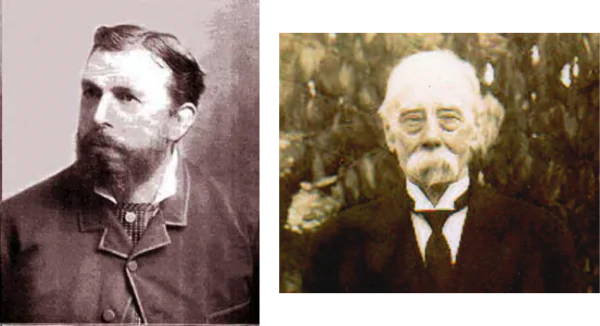

MATIER (or MATEER), ALEXANDER (1816-1877). Artificer, 1st New York Engineers, Company E. A native of Ireland, he enlisted as a private at New York City on September 13, 1861, and mustered into the 1st New York Engineers that same day. As per his muster roll, he was a carpenter who was 5′ 7½” tall with blue eyes, brown hair and a light complexion. He was promoted to artificer on May 17, 1864, and was discharged on September 27, 1864, at Bermuda Hundred, Virginia. The 1870 census reports that he was a carpenter. His last residence was 141 West 27th Street in Manhattan. Section 59, lot 1289, grave 5.
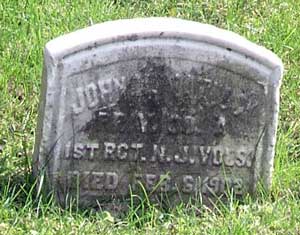
MATLOCK, JOHN N. (1838-1902). Private, 1st New Jersey Infantry, Company A; acting third assistant engineer, United States Navy. A native of Washington, D.C., Matlock moved to New York where he studied mechanical engineering. After he enlisted as a private on April 30, 1861, at Newark, New Jersey, he immediately mustered into the 1st New Jersey, a regiment that was activated for three months, and mustered out on July 31 at Newark. As per his obituary in the Brooklyn Daily Eagle, he then served for five years in the United States Navy as an acting chief engineer on many gunboats and cruisers. However, that rank appears to be incorrect; his Navy record indicates that he was appointed acting third assistant engineer on October 6, 1864, and ordered to the USS Fort Morgan. On June 22, 1865, he was ordered detached from the USS Honeysuckle and granted one month’s leave of absence. As of July 19, 1865, he was ordered to report to the USS Bermuda in Pensacola, Florida, for duty in the Gulf Squadron. Matlock was granted another month’s leave of absence on September 21, 1865, prior to his honorable discharge on October 30, 1865.
In civilian life, Matlock was a consulting engineer for the Griffing Iron Company of Newark. According to his obituary in the New York Herald, which confirms his Civil War service, he was a Freemason, a member of the Clinton Commandery of the Knights Templar, and a past commander of the Ulysses S. Grant Post #327 of the G.A.R.; members of those organizations were invited to his funeral. In addition, Matlock was a member of the New York Volunteer Fire Department. He last lived at 1 Middagh Street in Brooklyn. His obituary in the Brooklyn Daily Eagle notes that he died from typhoid pneumonia. His funeral took place at the Sands Street Memorial Church. His wife and one son survived him. In 1902, Lizzie Rogers Matlock applied for a widow’s pension from the Army, application 781,813, but it was not certified; she did receive a widow’s pension from the Navy as of April 1902 for $8 per month, certificate 10,740. Section 83, lot 2445.
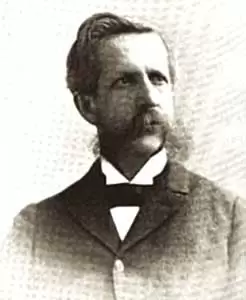
MATSON, NATHANIEL (1837-1916). Assistant surgeon, 1st Connecticut Heavy Artillery. Born in Schodack Landing, in Rensselaer County, New York, his ancestors on his father’s side include John Matson, a gunsmith on the ship that brought John Winthrop, the first governor of Massachusetts, to Boston. He was educated at the Schodack Academy, Kinderbrook Academy and Williston Seminary in Massachusetts. Matson graduated from New York Medical College in 1864, enlisted as an assistant surgeon on July 23, 1864, and was commissioned as an officer in the 1st Connecticut Heavy Artillery. That regiment took part in the James River Campaign at Bermuda Hundred, Virginia. He mustered out at Washington, D.C., on September 25, 1865 (although one biography notes that he mustered out at Hartford, Connecticut).
In 1866, Matson began practicing medicine in Brooklyn in association with Bushwick Hospital. Active in medical associations, he was a member of the Brooklyn Medical Society, the Kings County Medical Society, the Kings County Medical Association, and the New York State Medical Association. In addition, he belonged to the Rankin Post #10 of the G.A.R., the Freemasons, the Veteran Masons’ Association, and the Invincible Club. In 1905, his pension application was approved, certificate 1,118,944. He last lived at 415 Greene Street in Brooklyn. Anna Matson applied for and received a widow’s pension shortly after his death from apoplexy in 1916, certificate 835,149. Section 141, lot 23664.
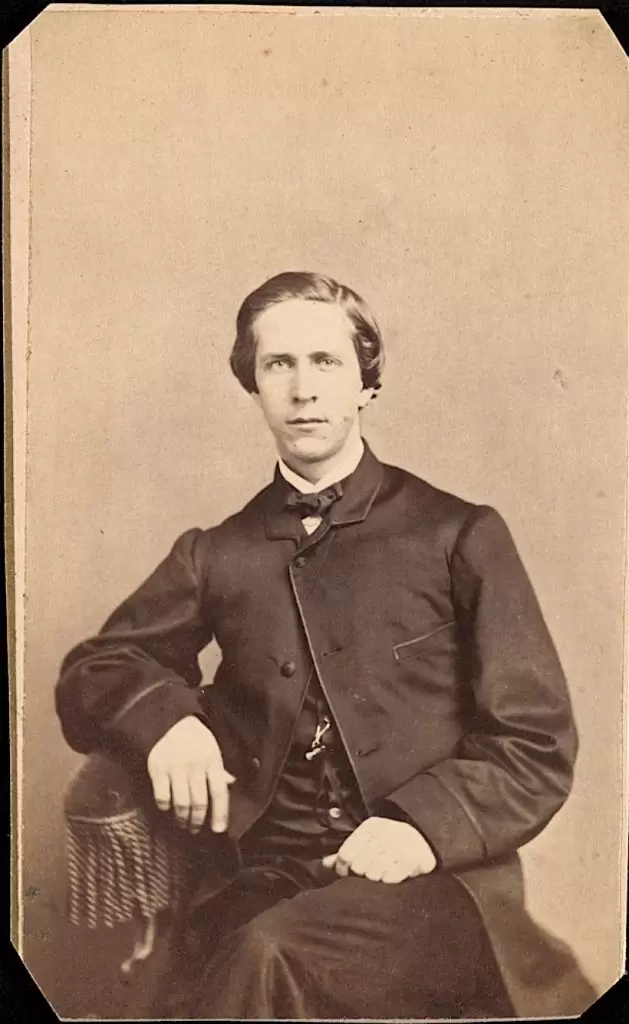
MATTHAEI, JAMES H. (1840-1886). Private, 178th New York Infantry, Company A. Although the census states that he was born in New York, Matthaei’s parents were from the West Indies and his muster roll indicates that he was born in St. Thomas in the Danish West Indies. After he enlisted as a private on December 13, 1862, at New York City, he mustered into the 178th New York on June 18, 1863. As per his muster roll, he was a clerk who was 5′ 5″ tall with blue eyes, light hair and a light complexion. His regiment was engaged in the Mississippi Marine Brigade. Although the muster roll reported that he deserted in October 1862, that was an error; he had been hospitalized on the hospital boat Woodford. The muster roll also indicates that he deserted at Eastport, Mississippi, on December 11, 1863, and returned 10 days later. Matthaei was later on detached duty on the Woodford from April through June 1864. He was discharged on December 31, 1864. According to the 1877 and 1883 New York City Directories and the 1880 census, he was a lawyer. He last lived at 10 Lafayette Place in Manhattan. He succumbed to Bright’s disease. Section 17, lot 17245, grave 979.
MATTHEWS (or MATHEWS), GALBRAITH GILBERT (1827-1870). First sergeant, 5th New York Infantry, Company C; private, 2nd New York Cavalry, Company I. Matthews was born in Ireland. During the Civil War, he enlisted as a first sergeant on April 25, 1861, and mustered into Company C of the 5th New York on May 9. His muster roll, which spells his surname “Mathews,” notes that he was paid $11.02 by New York State from April 25 through May 14, 1861. At the Battle of Big Bethel, Virginia, on June 10, 1861, a musket was shot out of his hands. Although his request for a transfer was not approved by Major General John A. Dix, he was transferred nonetheless to the 2nd New York Cavalry, also known as Harris’s Light Cavalry, on September 13, 1861, and mustered in five days later. Matthews deserted on December 17, 1861, at Camp Palmer, Virginia.
In 1866, Matthews married Eliza Piper in New York City. He last lived in Fort Hamilton, Brooklyn; his death was attributed to nephritis. Section 189, lot 18573.
MATTHEWS, HENRY (1844-1902). Vermont Heavy Artillery, Company A. A resident of Granby, Vermont, Matthews enlisted as a private on August 23, 1864, mustered into Company A of the 1st Vermont Heavy Artillery, also known as the 11th Vermont Infantry, and mustered out on June 24, 1865. In 1903, Mary F. Matthews applied for and received a widow’s pension, certificate 685,259. Section 194, lot 31302.
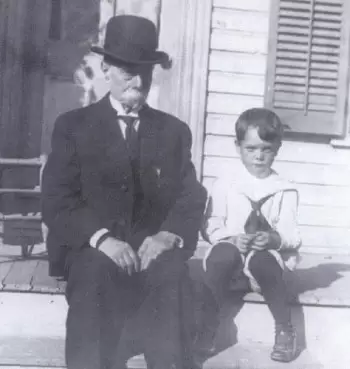
MATTHEWS, WILLIAM (1840-1921). Private, 127th New York Infantry, Company C. Matthews was born in England. During the Civil War, he enlisted at New York City on August 21, 1862, and mustered into the 127th New York on September 8. He was wounded in the side on December 6, 1864, at Deveaux’s Neck, South Carolina, and mustered out with his company on June 30, 1865.
Matthews was supposedly the brother of John Matthews, “The Soda Fountain King.” According to a descendant, William was a stone-carver who worked on Bow Bridge in Central Park, the lions in front of the main branch of the New York Public Library, and many New York City churches. In 1882, he applied for and received an invalid pension, certificate 241,389. The 1890 Veterans Schedule and his obituary in The New York Times confirm his Civil War service. He last lived at 448 East 144th Street. He died of lobar pneumonia. Section 162, lot 14612, grave 6.
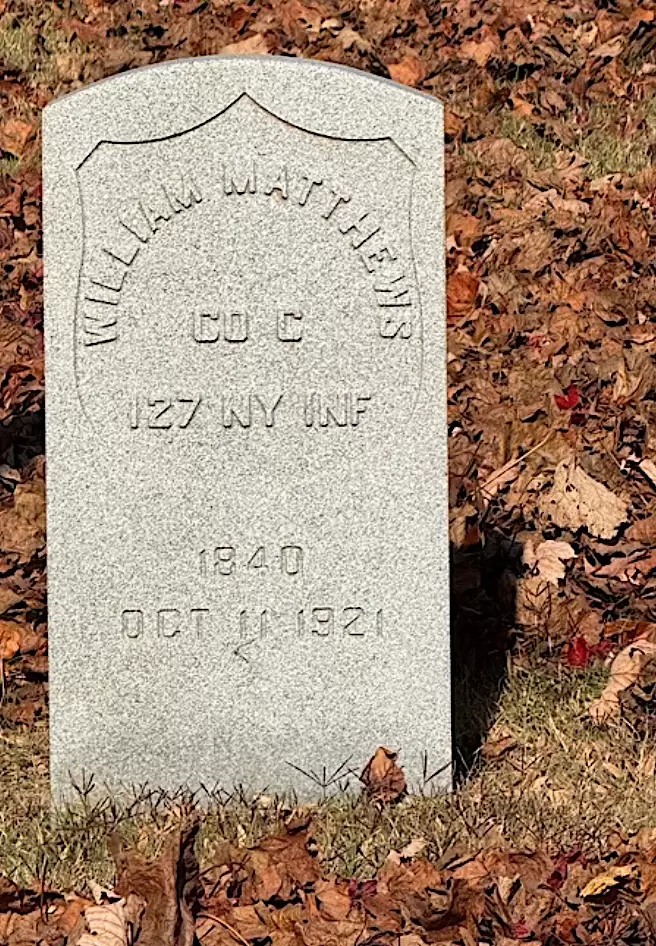
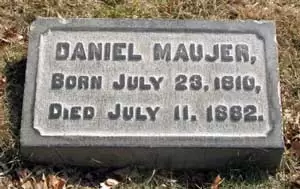
MAUJER, DANIEL (1810-1882). Supporter of Lincoln and recruiter. Although too old to serve in the Civil War, Maujer was a prominent supporter of President Lincoln and was instrumental in sending many young men to service and in contributing to the Union cause. Born on the island of Guernsey, Maujer came to this country in 1838, opened a paint store in Williamsburgh (now spelled Williamsburg), Brooklyn, on the corner of 4th and Grand Streets, and through his business acumen, honesty and good nature, built himself up financially and earned the affection of his neighbors. His store became a meeting place for many businessmen of the ‘Burgh’ and a base from which he advised neighbors and extended substantial relief to many friends who were experiencing difficult times.
Maujer resided for 41 years in the house where he died, at 524 Grand Street, and during his long residence in the Eastern District did much to build up that portion of the city. He was a member of the Board of Trustees of the village of Williamsburgh. Public School No. 18 (P.S. 18) was first opened in a building that he owned at the corner of Remsen Street and Graham Avenue in 1842. In 1858, he represented the Fifteenth Ward in the Board of Aldermen and took an active role in promoting the introduction of Ridgewood water into the city. A Civil War newspaper clipping of a July 4th ceremony in Fort Greene, Brooklyn, reported unparalleled enthusiasm, unity and patriotism by the more than 50,000 people in attendance and he was recognized officially by then Mayor Powell during the event. For almost 18 years (1864-1881) he was a member of the Board of Education and for most of that time was chairman of one of its most important committees, the Committee on Schoolhouses. He was one of the founders of the Williamsburgh City Bank (afterwards the First National Bank), a director of the Williamsburgh City Fire Insurance Company; chairman of the Grand Street Railroad Company; and a trustee of the Williamsburgh Savings Bank, the Brooklyn Life Insurance Company, the Plate Glass Insurance Company of New York and the Eastern District Dispensary and Hospital. On April 30, 1937, a street in his old neighborhood which runs from South 1st Street to Morgan Avenue was named in his honor. Section 184, lot 23544.
MAURY, MATTHEW FONTAINE (1811-1887). Cotton merchant and smuggler. The brother of Rutson Maury (see), he was the third son of James Maury, who was a close friend of Thomas Jefferson and the first consul appointed by President George Washington. James Maury’s consulate for 39 years was in Liverpool, England, where he also established the first American importing house in 1788, originally dealing in tobacco and then in cotton. Matthew Maury, who was born in England, came to the United States as a teen-ager for health reasons, returned to Liverpool where he became a partner in his father’s business, then returned to the United States after 10 or 12 years abroad. Matthew Maury was among the first to have an interest in the cotton trade before its commercial value was recognized and remained a dealer in that commodity for 45 years. His family had extensive commercial holdings in New York, Louisiana, and Texas at the onset of the Civil War.
In 1861, Maury and his brother Rutson were involved in a smuggling scheme that was traced to a Washington, D.C., banker, William T. Smithson, who was known for devising cunning methods of concealing contraband such as hollowing out canes or wads of tobacco, hiding items in linings of dresses, etc. On November 7, 1861, Matthew Maury was arrested by the U.S. marshal in Cleveland, Ohio, and charged with smuggling hundreds of letters addressed to parties in the Confederate states. Maury told the authorities that he, a British subject, voluntarily carried letters between New York and New Orleans, Louisiana, where he was currently living. He indicated that he carried 700 letters from New Orleans and was now carrying letters back to that destination. He was then sent to Fort Lafayette in New York Harbor, where his brother was also sent after his arrest later that week. Matthew Maury’s name was included in a letter written by William L. Burt to Boston’s Superintendent of Police on November 11, 1861, noting that the brothers were most likely employed by the “rebels” and used their status as British subjects as a cover for their illegal activities. Matthew Maury was transferred to Fort Warren in Boston Harbor from which he was discharged in February 1862, after taking an oath promising not to “enter or correspond with any insurrectionary State or to do anything hostile to the United States during the present insurrection.”
Despite the wartime controversy, Maury’s contributions to business were lauded by his colleagues. According to an article in The New York Times on September 20, 1887, members of the Cotton Exchange, of which Maury was not a member, eulogized his life. He was remembered by William T. Miller as his commercial and financial father, having worked with him for close to 40 years. Other members of the exchange praised his honesty, intelligence, character and worldwide renown. His tombstone is inscribed, “Died at New York in his 77th year. A merchant in that city for nearly 50 years, his stainless character commanded the respect of all his associates and worthily upheld the honoured name bequeathed to him by his much honoured father.” His death was attributed to a “carbuncle.” Section 150, l0t 13917.
MAURY, RUTSON (?-1882). Cotton merchant and secessionist. Rutson Maury, the brother of Matthew (see), was the youngest son of James Maury, a close friend of Thomas Jefferson. James Maury was the first consul appointed by President George Washington and served for 39 years in Liverpool, England, where he established the first American importing house in 1788, originally dealing in tobacco and then in cotton. Rutson Maury was born in Liverpool and educated at the Charterhouse School in London. His first enterprise was in Liverpool, but he was in business in Galveston, Texas, during the Civil War as a principal in the firm, Maury and Wilder. His family had extensive commercial holdings in New York, Louisiana, and Texas at that time.
A secessionist and British subject, Rutson Maury was charged with smuggling letters bearing communication from the rebel South addressed to parties in the Northern states, Europe, and other foreign ports. The spy ring that both he and his brother, Matthew, participated in was connected to a prominent D.C. banker, William T. Smithson, an expert in ingenious ways to conceal contraband. About 1,000 letters, protected by the British Consular seal in New Orleans, Louisiana, were delivered to Boston via New York on October 10, 1861, by Rutson Maury. In early November, he returned to the South via Cleveland, Ohio, and Louisville, Kentucky, carrying several hundred letters addressed to people in the secessionist states. On November 4, his baggage was seized in Cleveland and Maury traveled to Washington, D.C., to secure his belongings. According to an article in the Cleveland Herald on November 5, headlined, Discovery of Treasonable Correspondence, U.S. Inspector Ives seized 79 letters addressed to foreign parties hidden in clothing and in a pocket of Rutson Maury’s trunk. Maury seemed anxious to get the trunk back and the expense of a journey to and from Washington, D.C., aroused the suspicion of the marshal. Upon more careful inspection with a pen-knife, about 215 additional letters were found secreted in a hidden lining. A memo, addressed to James Maury, found among the hidden letters, said that “M. F. Maury will be in New Orleans on November 8th and will leave on November 11th. You understand.” Matthew F. Maury’s arrest on smuggling charges that same week in Cleveland was noted in the same article. The piece concluded, “The seizure of the letters carried by these two men are of great importance. It is to be hoped that the traitors will be arrested.”
When Rutson Maury reached his destination of Washington, D.C., he was arrested on or about November 9 and confined to Fort Lafayette. According to a letter to John A. Kennedy, the superintendent of the Boston Police Department, dated November 12, 1861, written by William L. Burt, the letters carried by Maury contained both information related to secession and to commerce. Burt also wrote that he believed that Rutson and Matthew Maury were employed “by the rebels” and used their British citizenship as “protection.” The New York Times reprinted the Cleveland article on November 10, 1861, and on November 16, included an article from Liverpool, England, highlighting that members of the Liverpool Exchange were being carefully monitored. Maury remained in custody at Fort Lafayette in New York Harbor until February 15, 1862, when his case was transferred to the War Department. Both brothers were released in February 1862, when they promised under oath not to aid the Confederacy or correspond with anyone residing there. As per his obituary in The New York Times, he was a well-known cotton merchant who was deaf for many years before his death, caused by gangrene. He last lived at 17 East 14th Street in Manhattan, a house owned by his family for over 50 years. Section 150, lot 13917.
MAXWELL, GEORGE H. (1845-1864). Private, 83rd New York Infantry, Company E; 97th New York Infantry, Company I. Of Irish birth, Maxwell enlisted as a private at New York City on September 11, 1861, and mustered into the 83rd New York six days later. He was transferred into the 97th New York on June 7, 1864. Just a few days later, on June 18, he was wounded in battle at Petersburg, Virginia, and succumbed to those wounds on August 9 at Washington, D.C. Interment at Green-Wood was on October 9, 1864. In 1890, his mother, Ellen Maxwell, applied for a survivor’s pension, application 484,333, but it was never certified. Section 182, lot 12092.
MAXWELL, THOMAS L. (1824-1897). Private, 71st Regiment, New York State Militia, Company G. Born in New York, Maxwell served for three months with the 71st Regiment from April 20 through July 30, 1861. The New York City Directories for 1877, 1880 and 1892 state that he was employed as a printer. Maxwell mustered into the Horace Greeley Post #577 of the G.A.R. on December 16, 1886. The 1890 Veterans Schedule confirms his Civil War service. In 1897, his application for an invalid pension was approved, certificate 959,177. He last lived at 1987 Third Avenue in Manhattan. Shortly after his death from cancer, Elizabeth Maxwell applied for and received a widow’s pension in 1897, certificate 461,927, as did a minor in 1903, certificate 682,715. Section 17, lot 17245.
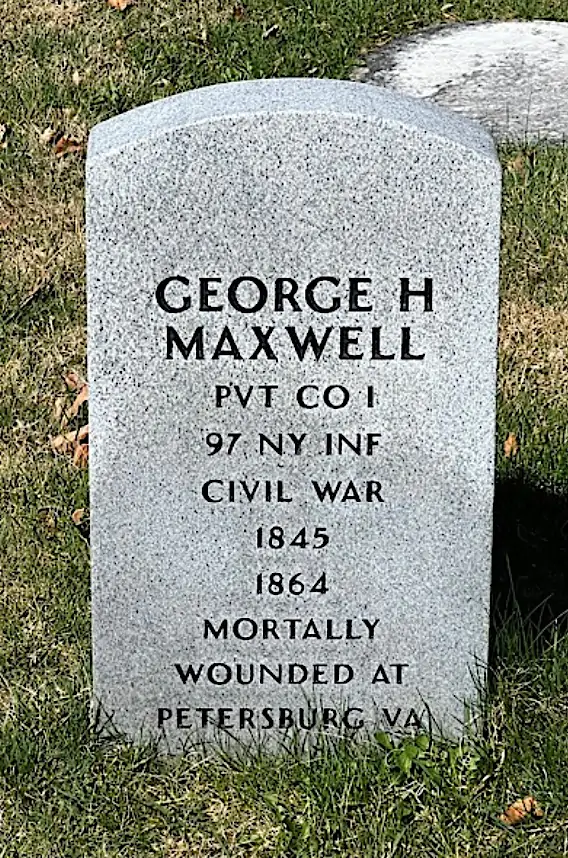
MAXWELL, WILLIAM H. (1840-1883). Private, 84th New York (14th Brooklyn) Infantry, Company H. A native of Glasgow, Scotland, Maxwell enlisted at Brooklyn on April 18, 1861, and mustered into the 14th Brooklyn on May 23, 1861. He was wounded in action at the Battle of Second Bull Run, Virginia, on August 29, 1862, and was discharged for disability on January 13, 1863, at New York City.
In civilian life, Maxwell was a carpenter as per the census of 1870 and the Brooklyn Directory of 1872. He was listed as a builder on the 1880 census and the 1882 Brooklyn Directory. According to articles in the New York Herald on June 28, 1883, and his obituary in the Brooklyn Daily Eagle on July 15, 1883, Maxwell, who was a foreman in the City Works Department and was active in the Republican Party, shot himself in the head in the washroom of his home. His skull was fractured and he was in critical condition; the revolver was turned over to the police. However, the Herald reported that the family refused to allow the ambulance surgeon into the house and gave no information to the investigators. It could not be determined if his death, which occurred two weeks after the shooting, was an accident or a suicide. He last resided at 591 Carroll Street in Brooklyn. Section 85, lot 11732, grave 43.

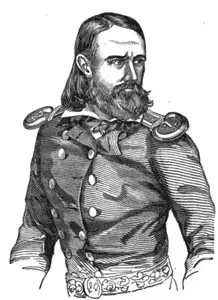
MAY, CHARLES AUGUSTUS (1818-1864). Colonel and lieutenant colonel by brevet; major, United States Army. Born in Washington, D.C., May was the son of a prominent Baltimore physician. May’s distinguished military career began with his enrollment as a second lieutenant in the United States Army, Second Regiment of Dragoons, on June 8, 1836, and subsequent promotions to first lieutenant on December 15, 1837, and to captain on February 2, 1841. During the Second Seminole War, May was responsible for the capture of King Philip, the Seminole nation’s main chieftain. May then achieved fame in the Mexican War. He was brevetted major on May 8, 1846, “for gallant and distinguished service in the Battle of Palo Alto, Texas.” His service in the Mexican War also merited brevets to lieutenant colonel on May 9, 1846, “for gallant and distinguished conduct at the Battle of Resaca de la Palma, Texas,” and to colonel on February 23, 1847, “for gallant and meritorious conduct in the Battle of Buena Vista, Mexico.”
Concomitant with his bravery in battle, he was known for his dashing appearance. A Baltimore journalist gave this description of May: “He is over six feet high; wears his hair long, so that it nearly reached his hips; his beard falls below his sword belt, and his mustache is unshorn.” Reportedly, May refused to allow a barber to trim his hair after his heart was broken by his sweetheart years earlier. His exploits in battle were exaggerated by the press and over time, he was compared to legendary knights. James Longstreet, later a very prominent Confederate general, said of him, “As a dragoon and soldier, May was splendid. He was amiable of disposition, lovable and genial in character.” On March 3, 1855, he rose to the rank of major.
May married into wealth on February 8, 1853, when he wed Josephine Law, the 19-year-old daughter of George Law, a steamboat proprietor and Know-Nothing Party presidential candidate. They married at the Old South Dutch Reformed Church on Fifth Avenue at 21st Street where the bride wore a white satin dress with lace embroidery that reportedly cost $1,500. The lavish reception at Law’s mansion was attended by 400 guests who dined on the finest wines and delicacies.
Although he married into wealth, May continued his military career. He took charge of the Cavalry School for Practice at Jefferson Barracks, Missouri, which later moved to Carlisle, Pennsylvania. He was visited by Second Lieutenant William Averell after Averell graduated from West Point. Averell recalled that May loved being a dragoon, had a wild streak and was a crack pistol shot and duelist.
May resigned from the United States Army on April 20, 1861, in the first days of the Civil War. Thanks to Francis Jastrzembski for his wonderful blog post, “Exchanging a Saber for a Cane-The Case of Colonel Charles Augustus May,” which appeared in Emerging Civil War on May 9, 2022, new information is presented about his resignation. Jastrzembski points out that nineteen Army officers (May was the third highest ranked; only Robert E. Lee and Joseph Johnston, who resigned and served as Confederate generals, outranked him) resigned their commissions at the outset of the war. After resigning, May took a job with as superintendent of the Eighth Avenue Railroad Company in New York City, a business owned by his father-in-law. Jastrzembski’s post describes this move as exchanging his saber for a cane, the latter representing the accessory to a suit and frock coat worn by a businessman. Jastrzembski posits that May had an affinity for the South. His brother, Henry May, a U. S. representative from Maryland, was arrested for disloyalty in Baltimore in September 1861 and another brother, Dr. John Frederick May, identified John Wilkes Booth’s body by a scar that he had made on Booth’s neck after removing a tumor there. Dabney H. Maury, who served with May in the United States Army and would rise to major general as a Confederate general, believed that May favored the Southern cause but could not go against his wife’s family (which was pro-Union) because he was so devoted to her.
May was mentioned in an article in the New York Herald on May 18, 1864, when drivers of the Eight Avenue Railroad Company gathered at the corner of Ninth Avenue and 50th Street where they “Unanimously resolved that we do return our sincere and earnest thanks” to Superintendent Charles A. May and Deputy Superintendent Herman B. Wilson “for the prompt and generous compliance with our recent request for the reduction of the number of our working hours from fourteen and one-half to twelve hours per day.” In addition, May removed racial barriers for African Americans traveling in the railroad’s cars. As per the Alexandria Gazette on July 2, 1864, “Col. Charles A. May, superintendent of the Eighth Avenue Railroad, in New York, notifies the public that “hereafter colored people will be allowed to ride in the cars of the company, both great and small ‘-there being no longer ‘colored cars.’” This latter decision might reveal May’s views toward slavery and his decision not to embrace the Southern cause. He died suddenly of heart disease on December 24, 1864, and was eulogized in both Southern and Northern newspapers. Delaware’s Wilmington Journal said of him, “the fame of May neither South nor North can claim. His last address was 721 Broadway in Manhattan. Section 169, lot 15659.


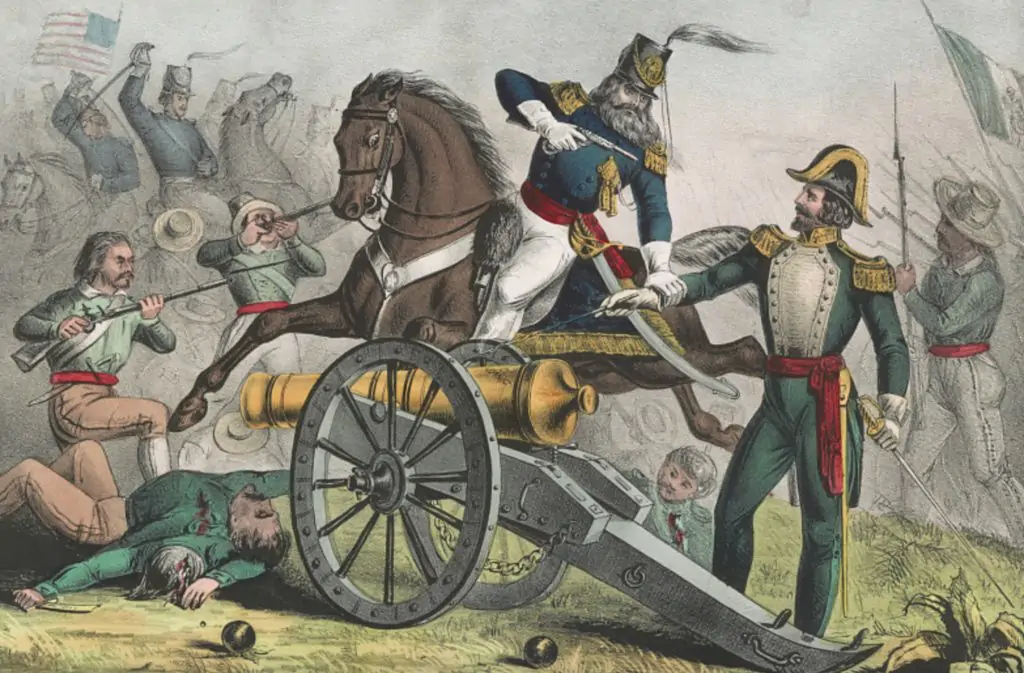
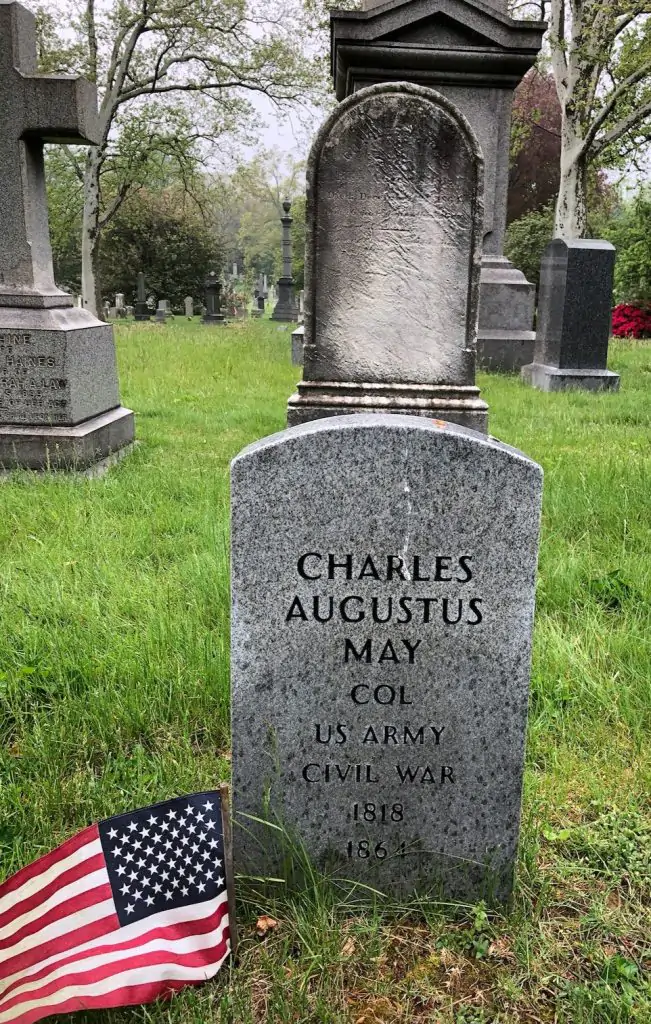
MAY, JOHN A. (1834-1876). Second lieutenant by brevet; sergeant, 82nd New York Infantry, Company H. A New York native, May enlisted and mustered into the 82nd New York as a private at New York City on May 21, 1861. He rose through the ranks to sergeant on June 1, 1861, and was brevetted to second lieutenant when he was discharged on August 15, 1861. The 1870 census states that he was a banker. The Los Angeles Herald reported that he was a circus clown who at one point was connected with Barnum’s Hippodrome.
At age 42, May succumbed to a gunshot wound in San Francisco, California. The Daily Alta California reported that he had been a bank cashier from New York who had resided in California for the six months preceding his death. According to articles in the Los Angeles Herald and the Daily Alta California on January 26, 1876, he shot himself in the head, two inches above the right ear, in an apparent suicide attempt. He died the next day. As per the Coroner’s Report of Decedents’ Property, May had in his possession five dollars and twenty-five cents coin, watch and chain, sleeve buttons, studs, collar button, clothing and personal effects. Section 26, lot 11290.
MAY, WILLIAM B. (1840-1879). Private, 42nd New York Infantry, Company C. May, who was born in New York State, enlisted as a private at New York City on June 22, 1861, the same day that he mustered into Company C of the 42nd New York. He was discharged on June 19, 1864, at New York City. A boatman, he died from chronic endocarditis. His last residence was on 28th Street in New York City. Section 181, lot 9851.
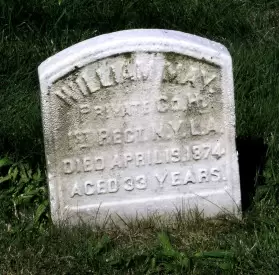
MAY, WILLIAM J. (1841-1874). Private, 83rd New York Infantry, Company G; 1st New York Light Artillery, Battery H. May was born in the duchy of Sachsen-Meiningen in Germany. After he enlisted on May 27, 1861, May mustered into the 83rd New York Infantry that same day. His muster roll indicates that he was detailed to Thompson’s Battery on April 10, 1863, and returned on October 15, 1863. Subsequently, he was transferred into Battery H of the 1st Light Artillery in December 1863, and mustered out on June 8, 1864. His pension records also indicates service in Company G of the 9th New York Infantry.
The 1870 census indicates that May worked as a laborer. His funeral was held at the home of his brother-in-law at 354 South 1st Street in Brooklyn. In 1891, Mary May applied for and received a widow’s pension under certificate 335,461. Section 121, lot 7639, grave 144.
MAYAN (or MAYSON), JOSEPH (1839-1885). First sergeant, 55th New York Infantry, Company A; sergeant, 38th New York Infantry, Companies K, I and G; private, 40th New York Infantry, Company E; Veteran Reserve Corps. A New York City native, Mayan enlisted as a first sergeant at Staten Island, New York, on August 1, 1861, and mustered into Company A of the 55th New York on August 28. He was transferred to Company K of the 38th New York on October 1, 1862, then transferred intra-regimentally to Company I on December 23, 1862; his soldier history also shows service in Company G of that regiment but no dates are listed. At some point during his service in the 38th New York, he was reduced to ranks but was promoted to sergeant on January 1, 1863. On June 3, 1863, he was transferred as a private into Company E of the 40th New York Infantry, and subsequently transferred to the Veteran Reserve Corps on August 15, 1863.
Mayan applied for and received an invalid pension in 1874, certificate 128,324. (His pension index card cites 1882 as the year of his death; that is incorrect, he died in 1885.) In 1878, he was a member of the Adam Goss Post #330 of the G.A.R.; he listed his occupation as a jeweler at 16 Maiden Lane in Manhattan with a home residence in Union, New Jersey. Mayan’s entry in the G.A.R. Descriptive Book notes that he last served as a private in Company A of the 55th New York as of September 1, 1864. As per the census of 1880, he was single and lived with his mother at 55 Blum Street in Union, New Jersey, and worked as a watch case maker. His name, listed as Joseph Mayson, appeared on the 1883 list of Civil War pensioners living in New Jersey. He last lived at the Blum Street address in Union, New Jersey. His death was attributed to phthisis. On October 30, 1896, an application was made for a government-issued headstone from W. H. Gross in Lee, Massachusetts. As per cemetery records, Joseph and his mother, who died in 1887, were buried in Green-Wood in lot 2857, grave 87, and were removed from the cemetery on February 13, 1903.
MAYNARD, EDWIN H. (1843-1902). Private, 186th New York Infantry, Company A. Born in New York City, Maynard served with the 186th New York. Further details of his service are unknown. The 168th mustered into service in September 1864 for one year. The regiment was engaged in Virginia at Hatcher’s Run, Virginia, in October 1864, the Battle of Fort Stedman in March 1865, had a major part in the storming of Petersburg on April 2, 1865, and was highly praised for its gallant charge at Fort Mahone. The 168th mustered out on June 2, 1865, at Alexandria, Virginia.
A traveling hat salesman in the Hudson River towns, Maynard formed a partnership and began his career with the wholesale firm of Topping, Maynard & Hobron on February 1, 1868. The firm had a factory in South Norwalk, Connecticut, and a showroom and store at 677 Broadway that specialized in felt and straw hats. Maynard was known for his experience, integrity, close attention to all departments, and customer service. The stock included all grades of stiff and soft felt and wool hats for men, boys and children. The business was well-known throughout the United States, Canada, Mexico and the West Indies for its well-priced and well-made merchandise. The original firm dissolved in 1895 when Hobron retired but Maynard and Topping continued the business for twelve years. He was listed as working in hats in the 1899 Brooklyn Directory; the 1900 census notes that he was a capitalist. As per his obituary in The New York Times, Maynard was a member of the Ulysses S. Grant Post #327 of the G.A.R., the Union League Club of Brooklyn and the Chamber of Commerce. He last lived at 851 St. Mark’s Avenue, Brooklyn. His death was attributed to Bright’s disease. Section 135, lot 29327, grave 8.
MAYNARD, OTIS G. (1824-1884). Private, 4th New York Cavalry, Company L; 9th New York Cavalry, Company L. Originally from Connecticut, he was a named partner in the furniture company of Maynard & Kerrigan which was dissolved on February 7, 1857, as per an advertisement in the New York Daily Tribune on February 14, 1857. During the Civil War, Maynard enlisted as a private at Stuyvesant, New York, on November 8, 1862, and mustered into the 4th New York Cavalry on December 18. On February 27, 1865, he transferred into the 9th New York Cavalry from which he was discharged for disability at a hospital in Baltimore, Maryland, on May 16, 1865. The 1870 census and the 1880 New York City Directory report that he was employed as a clerk; the 1878 New York City Directory indicates he worked in “fancy goods.” His last residence was 12 Harrison Street in Manhattan. He suffered from heart disease which caused his death. Section 14, lot 4969, grave 369.
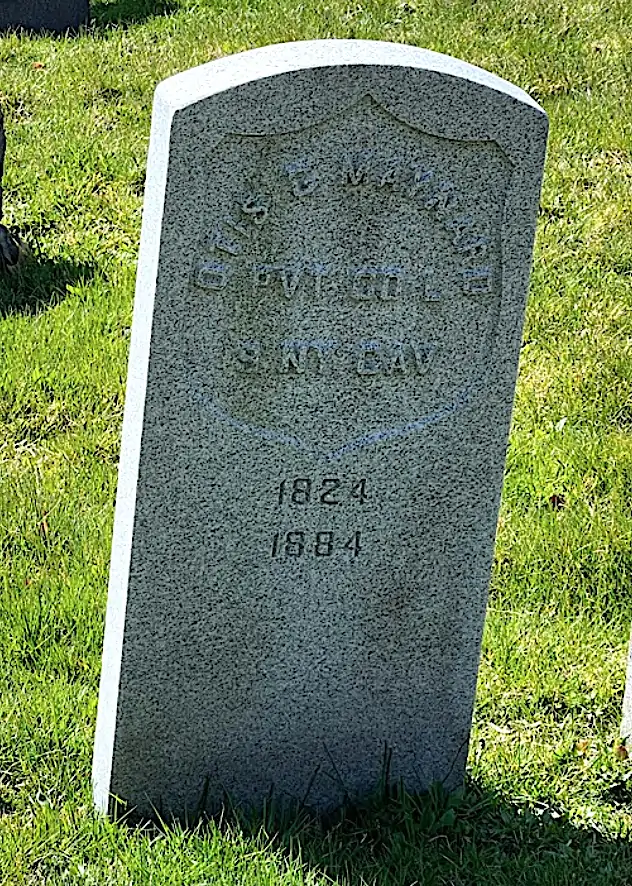
MAYNARD, SAMUEL H. (1817-1868). First lieutenant, 71st Regiment, New York State Militia, Company C. After he enlisted at New York City as a first lieutenant on April 19, 1861, he was commissioned into the 71st Regiment the next month on May 3, and mustered out on July 31 of that year at New York City. At the time of his death, he lived in Flatbush, Brooklyn. Section 74, lot 117.
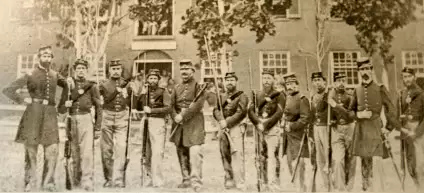
Co C 71st Regt. NYSM at Washington D.C. Navy Yard 1861. Maynard is 5th from left.
MAYO, HENRY O. (1819-1892). Surgeon, United States Navy. Born in New York, Mayo began his career in the Navy as an assistant surgeon on February 24, 1846, and was attached to the frigate United States in the Mediterranean Squadron from 1846-48. He was subsequently assigned to the Albany in the Home Squadron from 1850-52, and then the hospital ship New York from 1854-55. Assigned to the Potomac in the Home Squadron in 1856, he was part of the Coast Survey from 1857-58 and was on the Fulton in the Brazil Squadron in 1859, the year that he rose to the rank of surgeon on January 24.
During the Civil War, Mayo was on the Savannah, a sloop, in 1861, and then the Powhatan in the South Atlantic Squadron from 1862-63. During 1864-65, he was in the West India Squadron and was assigned to the New York from 1866-68. Mayo became a medical inspector on March 3, 1871, and a medical director on December 28, 1872. He retired on February 2, 1875. His last address was 247 Fifth Avenue in Manhattan. He died of pneumonia. Section 33, lot 6182.
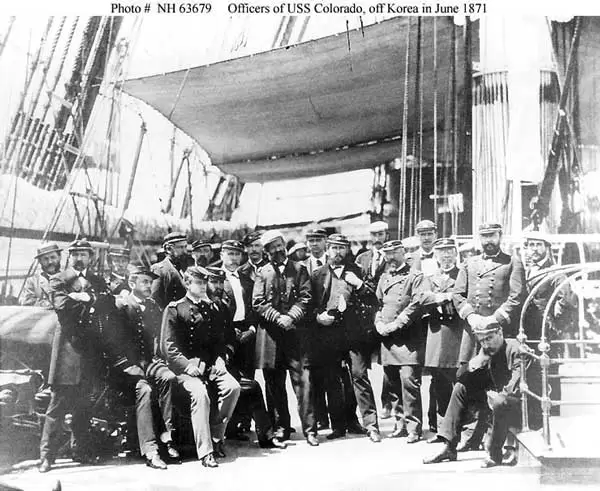
MAYO, HENRY PERCY (1834-1870). Second lieutenant, 158th New York Infantry, Company H. After enlisting at Brooklyn on September 3, 1862, Mayo was commissioned into the 158th that day. At some point he was an aide to Brigadier General Francis Spinola (see) and was later a provost marshal in New Berne, North Carolina. He was discharged on November 22, 1864, and returned to Brooklyn. A clerk for the Water Department until his death, he had an interest in the arts and entertainment. In addition to writing sketches of artists and overseeing the publication of a song-book, he had a wide acquaintance with actors and agents. He was the half-brother of William T. Collins (see). He last lived at 43 Willoughby Street in Brooklyn. His death was attributed to apoplexy. In 1890, his widow, Mary Mayo, applied for and received a pension, certificate 359,525. Section 186, lot 19583.
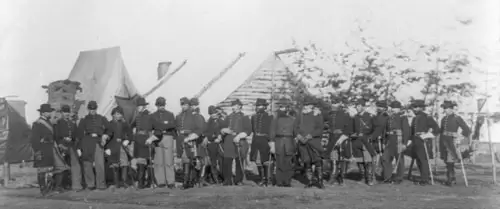
MAZE, WALTER H. (1841-1875). Captain, 61st New York Infantry, Company A. A New York native, Maze enlisted at New York City as a second lieutenant on September 1, 1861, and was commissioned into Company A of the 61st New York on October 16, 1861. On January 8, 1862, he was promoted to first lieutenant and on May 21, to captain. Maze was wounded at the Battle of Fair Oaks, Virginia, on June 1, 1862. In Colonel Francis C. Barlow’s Official Report of September 20, 1862, from the Battle of Antietam, Maryland, Barlow wrote, “Of the officers in my own regiment I commend to special notice, for bravery, coolness, and every soldierly quality in action, Captain Walter H. Maze, Company A….” Maze was discharged on March 5, 1863, when his resignation took effect.
In 1874, Maze applied for and received an invalid pension, certificate 131,023. As per the 1870 census and the 1872 Jersey City Directory, he was living in Jersey City, New Jersey, and was working as a commercial merchant. He last lived at 163 Waverly Street, Trenton, New Jersey. He succumbed to paralysis. Mary Jane Maze, who is interred with him, applied for and received a widow’s pension in 1879, certificate 194,865. Section 192, lot 23794.
McADAMS, JOHN (1820-1900). Wagoner, 4th New York Cavalry, Company B. Born in Quebec, Canada, McAdams was a bookbinder living in Boston as per the 1850 census. He was a machinist living in New York as per the 1860 census. During the Civil War, he enlisted as a private at New York City on August 29, 1861, and mustered into the 4th New York Cavalry at 40 years of age that same day. He received a promotion to wagoner around September 30, 1861, and served exactly three years until his mustering out on August 29, 1864, at Harpers Ferry, West Virginia.
The 1863 Draft Registration in New York and the 1864 Brooklyn Directory indicate that McAdams worked as a paper ruler. The 1865 New York census states that he worked with patent machines; the 1880 census lists him as a page ruler while the 1875 and 1892 Brooklyn censuses report that he was an inventor. On June 27, 1893, the Brooklyn Daily Eagle reported on the machines of McAdams & Sons that were exhibited at the Chicago Columbian Exposition. That article noted that McAdams was the inventor and introducer of paging machines, ruling by steam, four-way ruling at one feeding, circular ruling and other inventions for the paper and book trades. At the fair, McAdams introduced his roll disk machine which rules paper from a roll at the rate of seventy miles a day making it the fastest device for ruling paper in the world. The disk process created a better line on all grades of paper. Visitors to the exhibition were also impressed by his machines for paging blank books.
As per his obituary in the Brooklyn Daily Eagle, McAdams had lived in Brooklyn for thirty-eight years and was the senior partner in the firm of John McAdams & Sons, manufacturers of blank books. The business was located at 978 Kent Avenue in Brooklyn. His son, William, who was a member of the firm, invented McAdamite, a metal used in the making of strong aluminum castings. That product strengthened aluminum for commercial use. John McAdams last lived in South Boston, Massachusetts, where his death was attributed to myocarditis and senility. Section 195, lot 30465, grave 2.
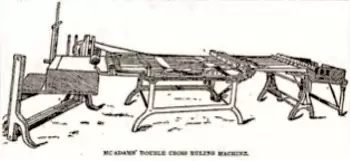
McAULIFFE (or McAULIFF), WILLIAM (1835-1896). Corporal 5th New York Infantry, Company A. McAuliffe was born in Cork, Ireland, and was baptized there on October 18, 1835. His death certificate states that he lived in the United States for 40 years, suggesting that he immigrated in the mid 1850s.
On May 2, 1861, McAuliffe enlisted as a private and mustered into Company A of the 5th New York on May 9. His muster roll, which spells his surname “McAuliff,” notes that he was paid $4.32 by New York State from May 2 through May 9. In June 1861, he was detailed as a company cook. He took sick at Harrison’s Landing, Virginia, on August 7, 1862, and was hospitalized at York General Hospital in Pennsylvania. He then returned to his regiment, was promoted to corporal on November 14, 1862, and detailed to the Color Guard. He was listed as sick with a cough from March 29 through April 2, 1863, and was present on the rolls on April 12 and May 14 of 1863. He mustered out at New York City with his company on May 14, 1863.
Records from New York’s Emigrant Savings Bank show that McAuliffe opened an account in 1866, lived at 223 Delancey Street in Manhattan, and was an umbrella maker. The 1870 census reports that he lived in Brooklyn with his wife Jane and was an umbrella manufacturer; two teenage girls, with the surname of Glasser, relationship unknown, also lived in the household. The 1875 New York State census indicates the same family members, spelling the young women’s names as Glassie. The 1879 and 1882 Brooklyn Directories list McAuliffe as working in umbrellas (or parasols) at 277 Court Street. As per the 1887 Brooklyn Directory, he was in the umbrella business at 86 Beaver Street in Manhattan and lived at 297 Court Street in Brooklyn. It is possible that he may be the William J. McAuliffe who was a postal clerk who earned $1,000 in 1895. He last lived at 253 Harrison Street in Brooklyn. His death is attributed to phthisis and asthenia (weakness).
Although one document indicates that he is buried at St. Raymond’s Cemetery, that is incorrect; his death certificate indicates that he was a widower (his wife, Jane, died in 1894 and is interred with him) and is buried at Green-Wood Cemetery. In fact, a man named William McAuliffe was buried in Green-Wood the same month and year as this veteran. His will was evaluated in Kings County Probate Court in March 1896. As per that will, he left an estate of approximately $10,000. Section 58, lot 4741.
McBRIDE, ALEXANDER (1846-1901). Quartermaster, United States Navy. Originally from England, he enlisted in the United States Navy during the Civil War, and was stationed on board the USS Harriet Lane. Originally part of the Revenue Service, the Harriet Lane returned to Navy control in 1861 and saw action at Fort Sumter, where she fired the first Naval shot in the battle, and then was deployed to the Gulf of Mexico in February 1862, where she participated in the capture of Galveston, Texas, in November of that year. The Harriet Lane was captured at Galveston on January 1, 1863, converted to a blockade runner by the Confederacy, renamed the Lavina, and sent to Havana, Cuba, in April 1864. McBride was discharged in 1865. His service on the Harriet Lane was inscribed on his gravestone. His last residence was 120 Hoyt Street in Brooklyn. Section 51, lot 11502, grave 4.
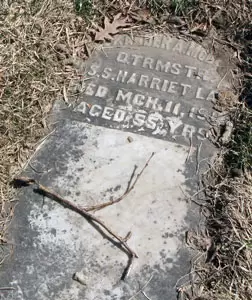
McBRIDE, ANDREW STEVENSON (1843-1916). Private, 8th Regiment, New York State National Guard, Company H. A native of New York City, McBride enlisted there as a private on May 29, 1862, and mustered immediately into the 8th Regiment. The regiment left New York en route to Washington, D.C., under the command of Colonel Joshua M. Varian, and re-entered the service of the United States for three months, serving principally at Yorktown, Virginia. After the regiment was discharged, McBride mustered out with his company on September 10, 1862, at New York City. His obituary in the Brooklyn Daily Times notes that he fought in many battles and was wounded several times.
He lived in Manhattan at the time of the census of 1900. In 1902, he applied for and received an invalid pension, certificate 1,060,950. The census of 1910 indicates that he had been married for thirty-eight years, lived on 151st Street in Manhattan, could read and write, and worked as a pattern-maker. His obituary notes that he was one of the organizers of the Theatrical Mechanics’ Association of New York and was employed on the stage of theaters in Manhattan, including Wallack’s, the Casino and the Metropolitan Opera House. In addition, he was a member of the Royal Arcanum, Foresters of America and the Homecrest Presbyterian Church, whose pastor officiated at his funeral services.
McBride last lived at 1954 East 9th Street in Brooklyn. His death was attributed to erysipelas (a bacterial skin infection). He was survived by his son, daughter and a sister. Section 13, lot 12910, grave 3.
McBRIDE, JAMES H. (1821-1880). Sergeant, 84th New York (14th Brooklyn) Infantry, Company H. Originally from Dublin, Ireland, McBride enlisted on April 18, 1861, as a private, and mustered into the regiment on May 23. He was promoted to sergeant on September 1, 1861. On July 16, 1862, he was discharged for disability at Alexandria, Virginia. He is listed as a painter on the 1870 and 1880 censuses and in the 1872, 1878 and the 1880 Brooklyn Directories. Although he applied for an invalid pension in 1879, application 272,787, he apparently died before it was certified. As per his obituary in the Brooklyn Daily Eagle, he was a member of the Fourteenth Regiment Veterans Association; comrades were invited to attend his funeral. McBride’s last residence was 117 Carlton Avenue in Brooklyn. A century-old Civil War marker is on his grave. He succumbed to Bright’s disease. Elizabeth McBride applied for and received a widow’s pension, certificate 398,609. Section 159, lot 13402.
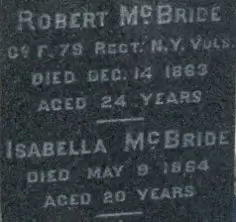
McBRIDE, ROBERT (1839-1863). Private, 79th New York Infantry, Companies F and H. McBride is not buried at Green-Wood; the inscription on his family’s granite monument at Green-Wood is a cenotaph that honors his service and sacrifice. It identifies him as a member of Co. F, 79th Reg. N.Y. Vols. He is buried at the Knoxville National Cemetery in Knoxville, Tennessee.
Originally from Scotland, McBride was a stone-cutter by trade. On August 30, 1862, he enlisted as a private at New York City and mustered into Company F of the 79th New York the same day. The 79th, known familiarly as the Highlanders, was composed of men who were mainly of Scottish descent. As per his muster roll, he was 5′ 10¾” tall with blue eyes, light brown hair and a fair complexion. On October 18, he was transferred to Company H. The 79th fought at Vicksburg and Jackson, Mississippi, before they were sent to Tennessee. He died on December 14, 1863, at Knoxville, Tennessee. Section 69, lot 11510.
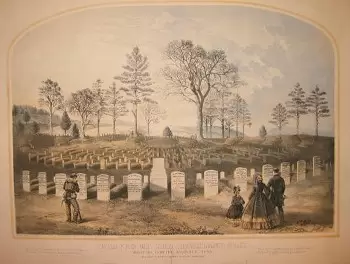
McBRIER, ROBERT (1834-1886). Private, 84th Regiment, New York State National Guard, Company A. Of Scottish origin (although the passenger list says Ireland), McBrier immigrated to the United States from Liverpool, England, aboard the Franconea, arriving in New York City on June 10, 1840. He applied at the New York City Court of Common Pleas for naturalization as a United States citizen on May 5, 1856; at that time, he resided at 195 West 21st Street in Manhattan. During the Civil War, he served with the 84th Regiment for 30 days when it was activated in 1863. That regiment was ordered to Harrisburg, Pennsylvania, on June 18, 1863, for service of thirty days; commanded by Colonel Frederick A. Conkling (see), it left the State on July 3, 1863, served in the defenses of Baltimore, Maryland., in the Middle Department, 8th Corps, and was mustered out of the United States service August 4, 1863 at New York City. The 1870 and the 1886 New York City Directories indicate that he was working in the fish business. He last lived at 2372 Fourth Avenue in Manhattan. McBrier died from nephritis. Section 82, lot 2037.
McBURNEY, SAMUEL HEZEKIAH (1842-1910). Private, 2nd New Jersey Infantry, Company H, paymaster’s clerk, United States Navy. McBurney was born in New York City. When he applied for a passport in 1859, he was 5′ 6″ tall with dark blue eyes, Roman nose, small mouth, dark brown hair, prominent chin, fair complexion and thin face. McBurney enlisted as a private on April 26, 1861, and mustered into the 2nd New Jersey on May 1, 1861. His obituary in the Jersey Journal confirms his Civil War service and reports that he was engaged in the Secret Service of the Union Army. The 2nd New Jersey, also known as the Communipaw Zouaves (named from their avenue where they trained), was sent to defend Washington, D.C. After spending time in Alexandria, Virginia, the zouaves were then the bodyguard to General Theodore Runyon at the Battle of First Bull Run, Virginia. McBurney mustered out on July 31, 1861, at Trenton, New Jersey. According to his pension record, he also served in the United States Navy as a paymaster’s clerk.
His first wife, Georgiana DeWitt McBurney, whom he married in 1867, died in 1870. The 1870 census reports that he was comptroller of Jersey City whose real estate was worth $10,000 and whose personal worth was valued at $2,000; the 1880 census and 1881 Jersey City Directory indicate that he was a stock broker. The 1880 census shows that he had remarried and had a one-year-old daughter. As per the 1900 census and the 1901 Jersey City Directory, he was secretary and treasurer of the Hudson River Ice Company. He was also a partner in managing the towboat business of William H. Gautier & Co. in New York Harbor. An article in the Evening Journal on August 7, 1890, described the problems that the ice supply companies faced during the warm months. Apparently, the companies were losing money because of ice melting on the trip from Maine to the Morgan Street Dock in Jersey City. The Hudson River Ice Company purchased 250 tons of ice in Maine but only 101 tons of that made it to New Jersey. McBurney, who charged $14 a ton to his customers, lost $700 in the transaction. He and others in the industry felt that the “shrinkage” of ice was too much and feared some “manipulation” by middlemen.
The Evening Journal reported on December 26, 1901, that McBurney and other living New Jersey veterans of the Civil War received a medal of honor from the Quartermaster General honoring their service. McBurney was a member of the Van Houten Post #3 of the G.A.R. in Jersey City, the Royal Arcanum, the Loyal Addition and numerous Masonic societies. In 1904, his request for an invalid pension was granted, certificate 1,087,125. His last residence was at 7 Kensington Avenue in Jersey City, New Jersey. Upon his death from pneumonia in 1910, Caroline Du Bois McBurney, his second wife, applied for and received a widow’s pension, certificate 717,950. Section 81, lot 2216.
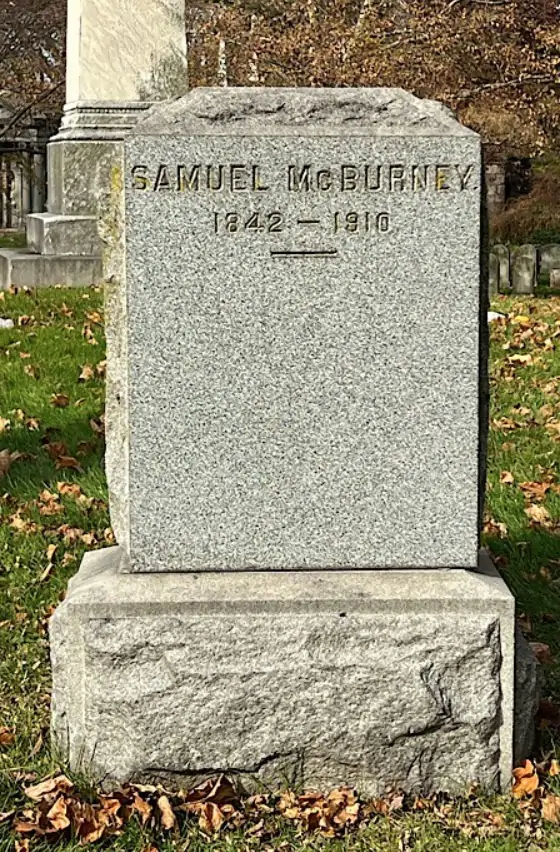
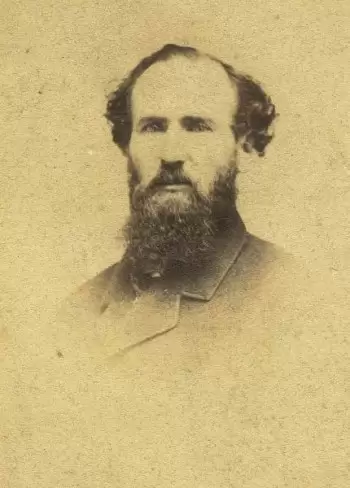
McCALL, WILLIAM PATTERSON (1833-1883). Private, 3rd Infantry Battalion, District of Columbia, Company A. Born in New York, he lived in Washington, New York, at the time of the 1855 census and was a clerk. The 1860 census reports that he was a merchant. He enlisted on April 21, 1861, as a private, for a term of three months. On April 29, he mustered into the 3rd Infantry Battalion, District of Columbia National Rifles, Company A (Captain Smead’s Company), formed for the defense of the capital. He mustered out on July 24, 1861, at Washington, D.C.
McCall was a clerk in Washington, D.C., when the Draft Registration took place in July 1863. Transferred after the Civil War to the Interior Department, he became secretary to the governor of Idaho Territory, Caleb Lyon (who is also buried at Green-Wood), where he had dealings with the Nez Perce Indians. He is listed on the 1870 census as living in Washington, New York; the 1880 census states that he worked in fancy goods in New York City. He returned to New York, last residing at 627 Hudson Street, Manhattan. His death was caused by cancer. Section 14, lot 4969, grave 282.
McCALLUM (or MCCALLUM), SAMUEL (1843-1924). Private, 22nd Regiment, New York State National Guard, Companies H and I. A native of New York City, McCallum enlisted as a private at New York City on May 28, 1862, and immediately mustered into Company H of the 22nd Regiment. He mustered out with his company at New York City on September 5, 1862. In 1879, he graduated from the University of the City of New York Medical School and then practiced medicine in New York City. In 1905, he applied for and received an invalid pension, certificate 1,119,204. His pension index card also indicates service in Company I of the 22nd Regiment and service in the Field and Staff of the 8th New York Infantry but information about that additional service is not specified.
The census of 1910 reports that McCallum was single, worked as a physician, was a boarder on West 127th Street, and was a survivor of the Union Army. In 1915, he mustered into Lloyd Aspinwall Post #600 of the G.A.R. citing his service in Company I of the 22nd Regiment; McCallum indicated in the sketchbook that he was a physician. According to the census of 1920, he was single, lived at 73 West 127th Street in Manhattan, and was retired. One record indicates that his death was attributed to senility; another states the cause of his death as pericarditis. Section L, lot 16928.
McCALVEY (or McCALAVEY), WILLIAM HENRY (1839 -1896). Sergeant, 48th New York Infantry, Company I. A Brooklynite by birth, McCalvey enlisted there on September 17, 1861, mustered in on October 15, and was promoted to sergeant during his service. McCalvey worked as a marble cutter at the time of the Draft Registration of 1863; he is listed as a marble cutter on the 1875 census, as a stone cutter on the 1880 census, and as a marble cutter in the 1885 and 1887 Brooklyn Directories. In 1891, his application for an invalid pension was approved, certificate 790,211. As per his obituary in the Brooklyn Daily Eagle, he was a member of the Forty-eighth Regiment, N. Y. Volunteer Veteran Association; members were invited to attend his funeral. He last lived at 475 Dean Street in Brooklyn. Marcella McCalvey applied for and received a widow’s pension in 1896, certificate 435,578. Section 40, lot 6806.
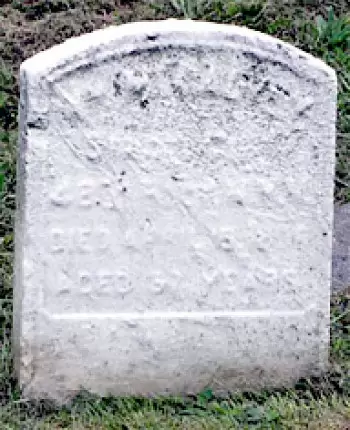
McCARTEN, JAMES W. (1843-1880). Private, 1st New York Infantry, Company C. McCarten, who was born in New York State, enlisted as a private at New York City on January 10, 1862, and mustered that day into the 1st New York. As per his muster roll, he was a laborer who was 5′ 6″ tall with blue eyes, dark hair, and a dark complexion. He was wounded in action at the Battle of the Peach Orchard, Virginia, on June 25, 1862, and was hospitalized. His muster roll notes that he was dropped from the rolls on April 10, 1863; no further military record was found for him.
McCarten is listed as an ostler, a person who looks after horses, in the 1877 New York City Directory; he was living at 105 East 13th Street in Manhattan at that time. An article in the New York Daily Tribune on December 25, 1877, reported that McCarten, driving a horse-drawn vehicle, knocked down Henry T. Vanderhoof, a coal merchant, on Fourth Avenue and East 13th Street, and was arrested near 14th Street after the collision. He is listed as a cartman in the 1879 New York City Directory and a driver in the 1880 New York City Directory; the 1880 census indicates that he was employed in the driving trade. As per his obituary in the New York Herald, he was a Freemason. McCarten died from phthisis (tuberculosis). His last residence was 105 East 13th Street in Manhattan. Section 117, lot 10975, grave 627.
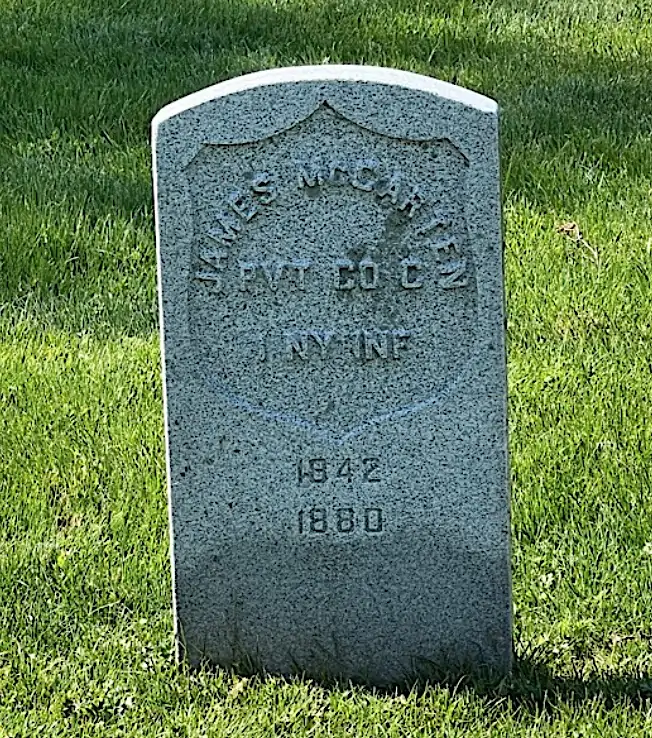
McCARTHY, FREDERICK (1836-1869). Private, 55th New York Infantry, Company E. A native of Ireland, McCarthy enlisted as a private at New York City on January 27, 1862, the same date that he mustered into the 55th New York. After he was wounded on May 31, 1862, at Fair Oaks, Virginia, he was discharged for disability on October 22 at Fort Lyon, Virginia. The New York City Directory for 1870 reports that he had been a carpenter. As per the Mortality Schedule, which confirms his occupation as a carpenter, he died from tuberculosis. He last lived at 278 Avenue A in Manhattan. Section 126, lot 5047, grave 734.
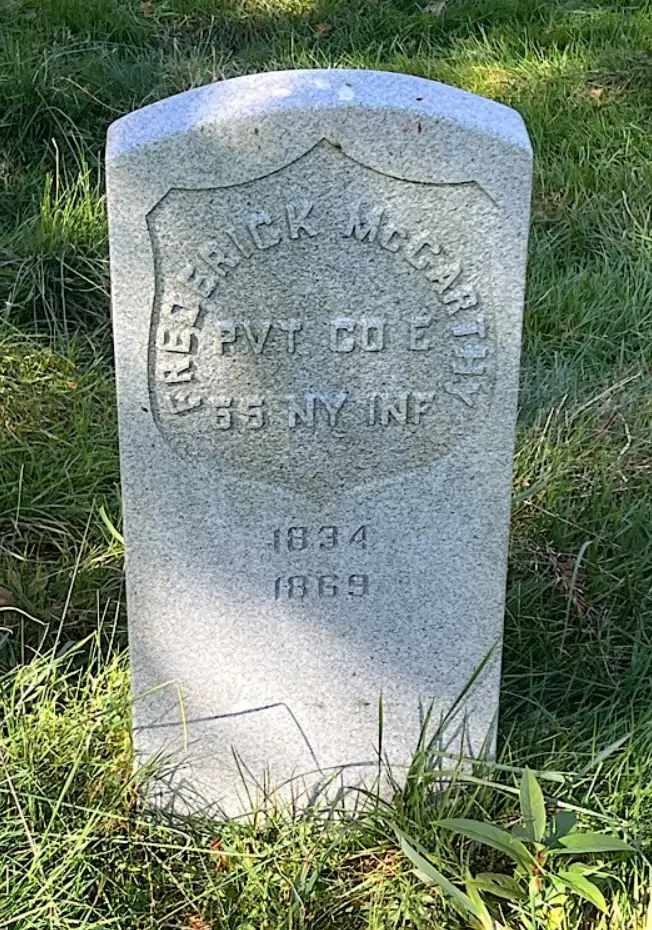
McCARTHY, TIMOTHY (1832-1897). Acting second assistant engineer, United States Navy. A Canadian by birth, McCarthy served as an acting second assistant engineer on the gunboat Commodore Jones as of April 18, 1863. He was discharged on December 15, 1865. In 1885, his application for an invalid pension was approved, certificate 9,744. As per his obituary in the Brooklyn Daily Eagle, he was a member of the Erastus T. Tefft Post #355 of the G.A.R. as of September 23, 1893, the Alpha Council of United Friends and the Freemasons; members of those organizations were invited to attend his funeral. He last lived at 38 1st Place in Brooklyn. McCarthy’s death was caused by gastritis. Helen McCarthy, who is interred with him, applied for and received a widow’s pension in 1894, certificate 822,487. Section B, lot 8575, grave 294.
McCARTNEY, WILLIAM H. (1846-1904). Landsman, United States Navy. McCartney was a native of Brooklyn. He enlisted in the Navy and served aboard the USS Agawam, a gunboat that was part of the Union blockade; the USS Iosco, a steam gunboat that was engaged at Fort Fisher; and the USS Miantonomoh, an ironclad. The 1888 Brooklyn Directory, the New York census of 1892, the 1900 census and the 1901 Brooklyn Directory report that he was employed as a conductor. Information from the Sons of Union Veterans confirms his service in the Navy. In 1892, he applied for and received a pension from the Navy, certificate 19,491. His last residence was 66 Pulaski Street, Brooklyn. In 1906, Mary McCartney, who is interred with him, applied for and received a widow’s pension, certificate 17,193. Section 122, lot 17806, grave 151.
McCAULEY (or McAULEY, MACAULEY), GEORGE W. (1840-1906). Private, 21st New Jersey Infantry, Company G. Borne on the rolls as George McCauley and a resident of New Jersey as per the 1860 census, he enlisted as a private on August 25, 1862, and mustered into the 21st New Jersey on September 15. The 21st New Jersey was part of the Army of the Potomac and engaged in the Battle of Antietam, Maryland, on September 17-19, 1862. According to his soldier history, he deserted on November 1, 1862, at Boonesboro, Maryland. The indication of desertion may be inaccurate because the Veterans Census of 1890, which identifies him as George W. McAuley, states that he mustered out on November 10, 1863; a descendant notes that in family lore, he was a prisoner somewhere in the South but that information has never been confirmed. According to the census of 1870, he was living in Jersey City and employed as a finisher. McCauley was living in Brooklyn in 1887. He last lived at 325 17th Street in Brooklyn. His death was attributed to pneumonia. A descendant reports that the family surname has been spelled in many variations; the current spelling is Macauley. Section 135, lot 30010, grave 391.
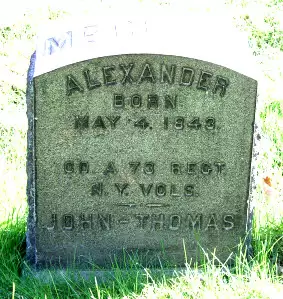
McCLANE (or McCLEAN), ALECK (or ALEXANDER) (1843-?). Private, 73rd New York Infantry, Companies G and A; Veteran Reserve Corps, 2nd Battalion, 7th Company; Veteran Reserve Corps, 22nd Infantry, Company B. He enlisted as a private on June 1, 1861, at New York City, mustered into Company G of the 73rd New York, and transferred into Company A on September 1 of that year. After he was wounded at the Battle of Gettysburg, Pennsylvania, on July 2, 1863, he transferred into the 7th Company, 2nd Battalion, Veteran Reserve Corps, on August 15, and on September 12, he transferred into Company B, 22nd Infantry, Veteran Reserve Corps. Section 6, lot 4071, grave 638.
McCLENACHAN (or McCLANAHAN), ROBERT G. (1824-1877). Private, 175th Pennsylvania Infantry, Company I. A native of Pennsylvania, McClenachan enlisted on November 6, 1862, and served as a private in Company I of the 175th Pennsylvania. The 175th entered service for nine months and moved via Washington, D.C., to Fortress Monroe, Virginia, and then was sent to New Berne, North Carolina. In June 1863, the 175th was sent to Harpers Ferry, West Virginia, and then Sandy Hook, Maryland. The regiment mustered out at Philadelphia, Pennsylvania, on August 7, 1863.
As per the 1865 New York State census, McClenachan was a bookkeeper. The 1867 Brooklyn Directory reports that he was a clerk; the 1870 census records that he was a bookkeeper with a personal estate valued at $500. He spent the last days of his life at Bellevue Hospital, New York City, where he died from consumption. Section 81, lot 2923.
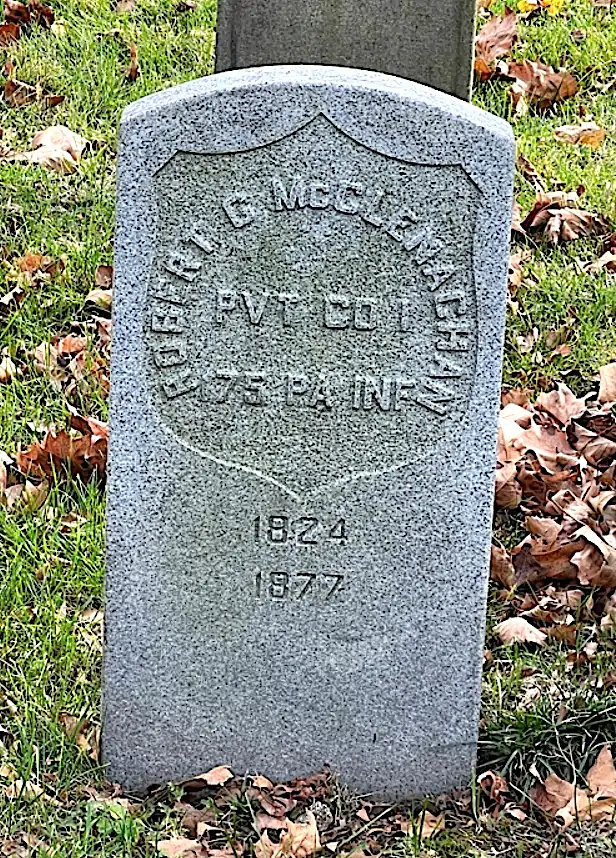
McCLOSKEY (or McCLUSKEY), JOHN (1826-1890). Musician, 123rd New York Infantry, Company F. Born in Ireland, although his muster roll mistakenly says Argyle, New York, he enlisted on July 31, 1862, at Argyle, New York, as a musician. On September 4, 1862, he mustered into Company F of the 123rd and was reduced in rank to private. As per his muster roll, he was a laborer who was 5′ 6″ tall with blue eyes, sandy hair and a light complexion. He served in many battles of the Civil War including Chancellorsville, Virginia; Gettysburg, Pennsylvania, and Sherman’s March to the Sea including Kenesaw Mountain, the Siege of Atlanta, Savannah and Bentonville. He mustered out on June 8, 1865, at Washington, D.C. His last residence was 758 7th Avenue in Manhattan. He succumbed to nephritis. Section 203, lot 26226.
McCLUNEY, WILLIAM J. (1796-1864). Commodore, United States Navy. Originally interred at Green-Wood, his remains were removed on May 31, 1892, and re-interred at Laurel Hill Cemetery in Philadelphia, Pennsylvania. McCluney was appointed midshipman in the United States Navy on January 1, 1812, and took part in the battle between the Wasp and the Frolic on October 18 of that year. He was commissioned lieutenant on April 1, 1818, and commander on December 9, 1839. He saw action in the Mexican War and was promoted to captain on October 13, 1851. In 1853, he was ordered to command the Powhatan and join Commodore Matthew C. Perry’s expedition to Japan. The Powhatan was Perry’s flagship when the treaty with Japan was signed on February 14, 1854. Upon return to the U.S. in February 1856, McCluney was ordered to New York as general supervisor of the construction of the Stevens Battery (an armored ship). In 1858, he was placed in charge of the Atlantic Squadron, an office he held until May 1860. In 1860, he served aboard the frigate Roanoke as flag officer and was commander-in-chief of the Home Squadron. He retired on December 21, 1861, and was commissioned commodore on July 16, 1862. He was buried at Green-Wood with military honors. Two rear-admirals were among the pallbearers and the officers of the USS Savannah, the Navy Yard Band, and 200 marines accompanied the cortege. He was remembered at his funeral as faithful and devoted to his country and the Navy. He last resided at 23 Smith Street, Brooklyn.
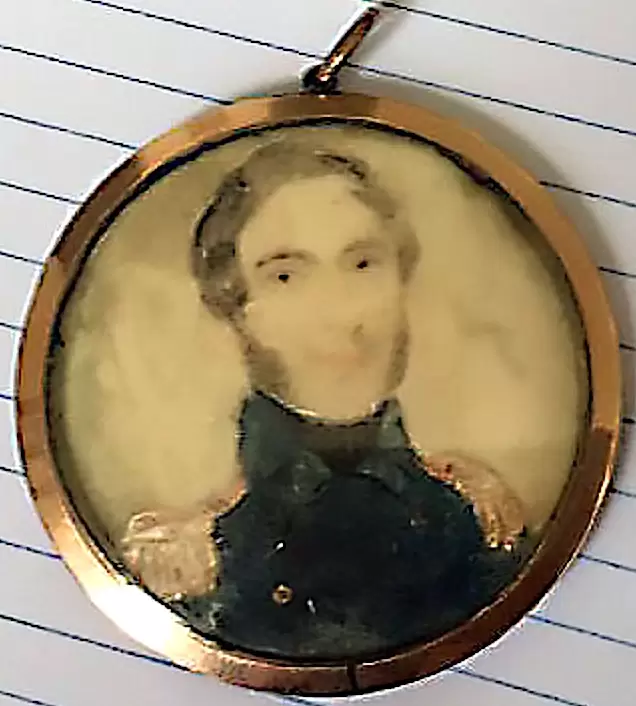
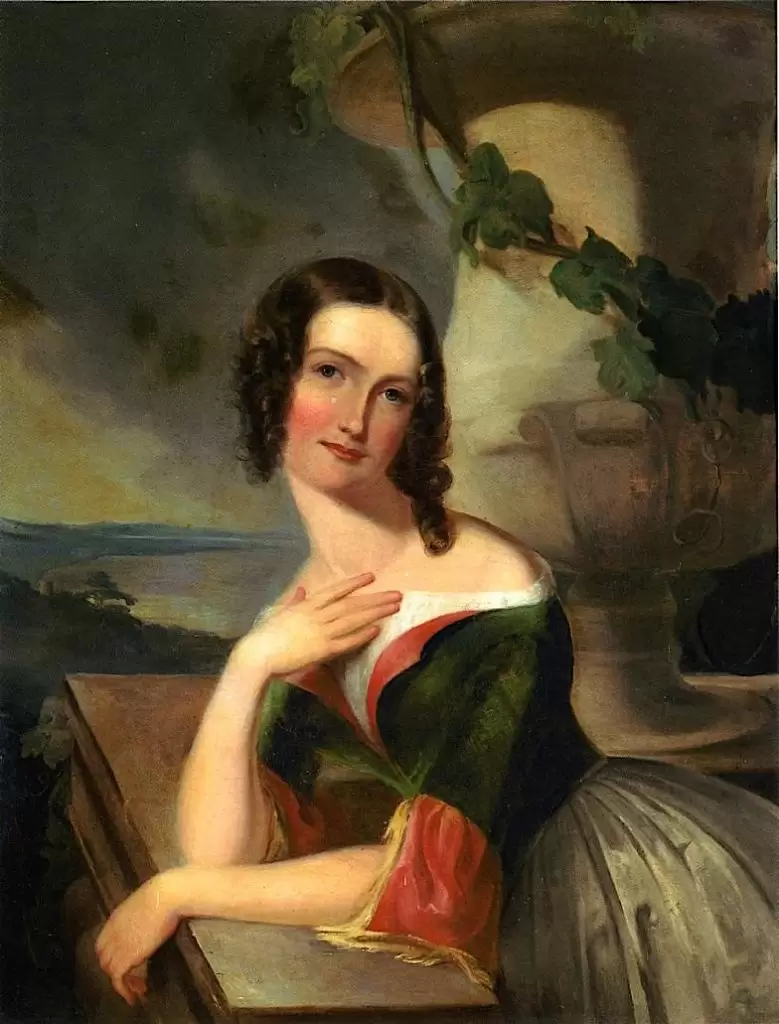
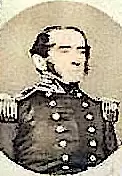
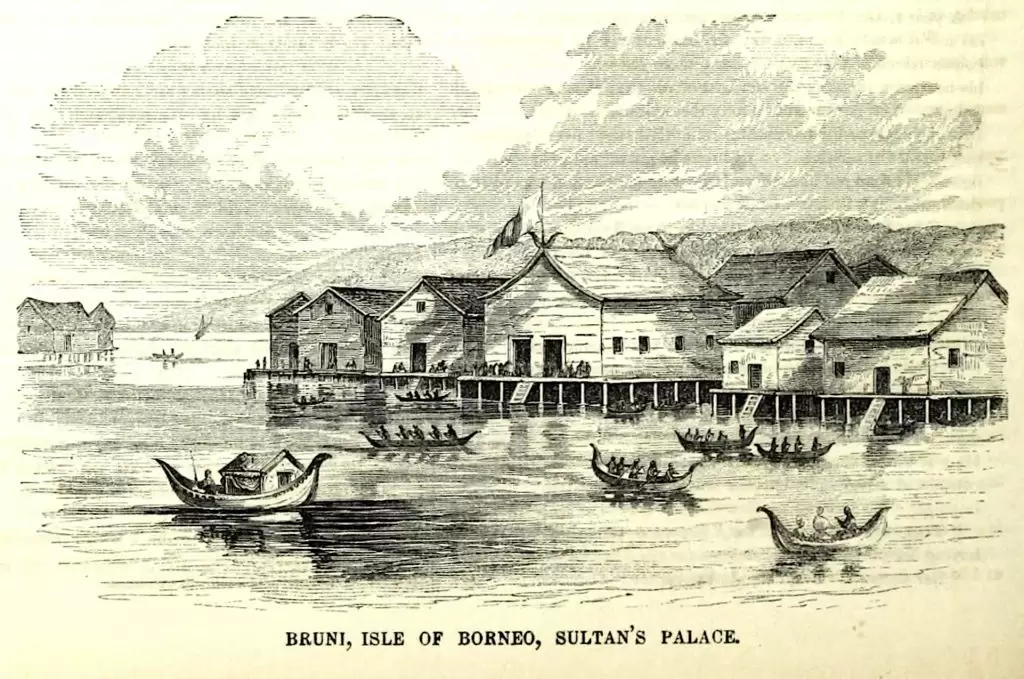
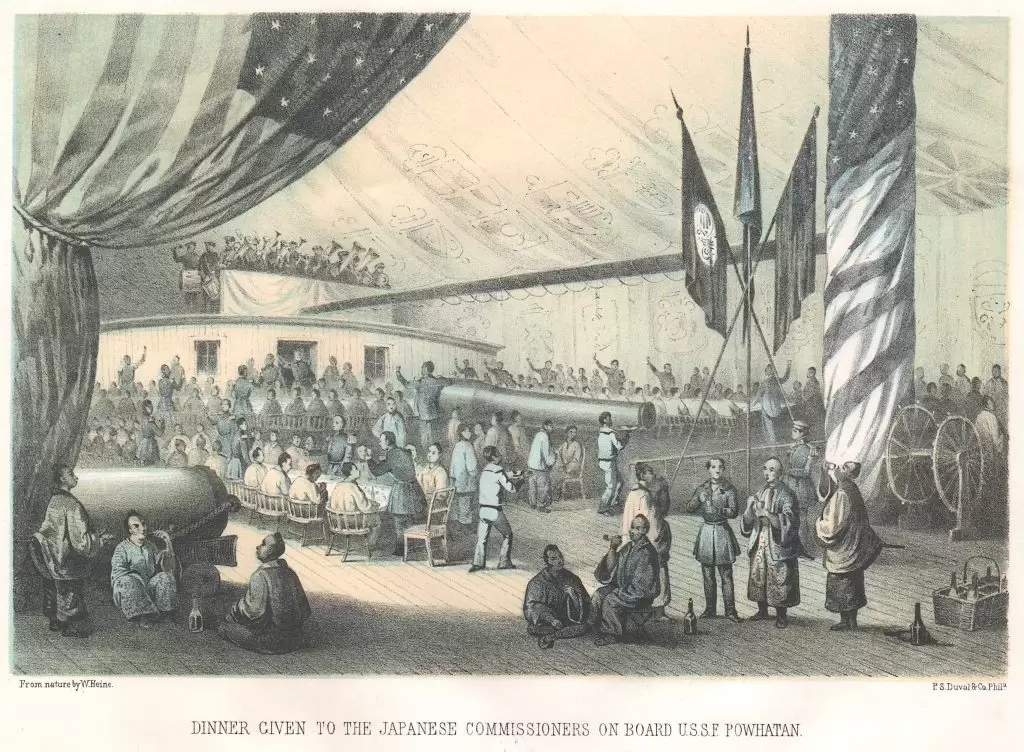
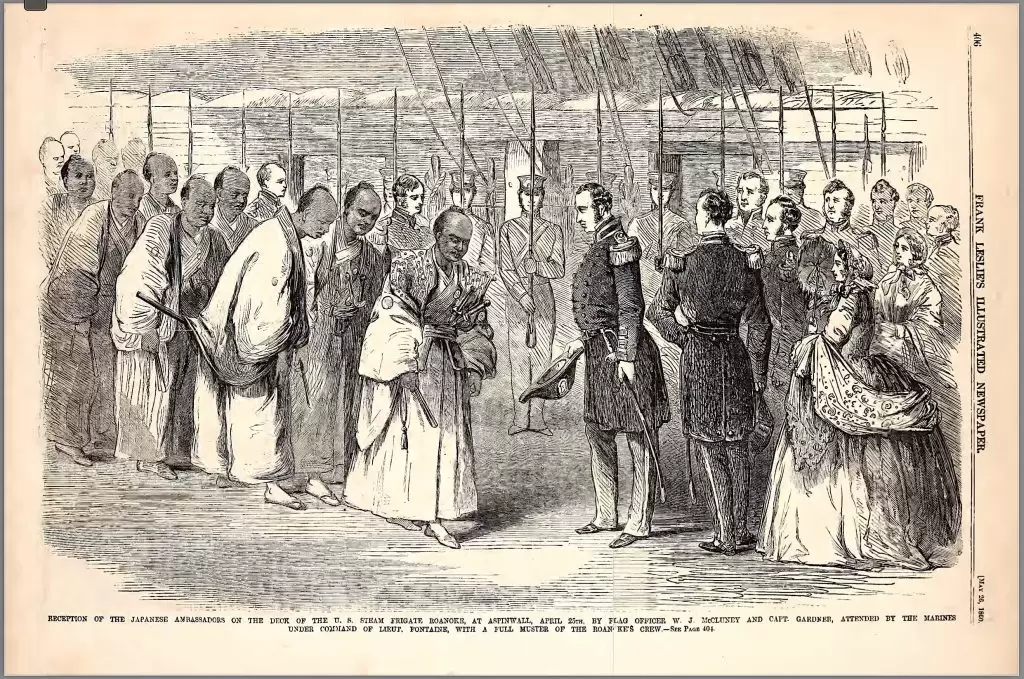
McCLURE, EDWARD (1827-1906). Private, 139th New York Infantry, Company K. Originally from Ireland, McClure was listed as a porter on the 1860 census with a personal estate valued at $100. During the Civil War, he enlisted as a private at Brooklyn on August 20, 1862, and mustered into the 139th New York on September 9. His muster roll notes that he was made a wagoner in April 1863. He was listed as a coachman on the Draft Registration of 1863. After suffering a grave injury on November 15, 1863, at an unstated place, his left arm was amputated. His records indicate he suffered two other wounds but give no further details. McClure was discharged for wounds on January 13, 1864. His application for an invalid pension on January 25, 1864, was approved under certificate 26,584.
On December 6, 1866, the Brooklyn Daily Eagle reported that McClure was the janitor at the new Kings County Court House and that his yearly salary would be increased to $1,200 from $1,000. On July 23, 1868, the Brooklyn Daily Eagle noted that McClure was reimbursed $150 for decorating the Court House on Independence Day. The 1870 census notes that he was a car starter; the 1875 New York State census and the 1876 Brooklyn Directory indicated that he was a janitor. As per an article in the Brooklyn Standard Union on August 7, 1906, he was among the twenty-three New Yorkers killed and thousands prostrated during a heat wave in New York City. McClure was overcome by the heat on Myrtle Avenue and taken to Brooklyn Hospital. The article, which confirmed that he was a Civil War veteran, noted that because of his advanced age, he was likely to succumb. He died on August 26, recorded in cemetery records as from epithelioma, a skin cancer. He last lived at 341 75th Street in Brooklyn. Section 168, lot 16620, grave 3.
McCLURE, STEPHEN CONOVER (1840-1873). Sergeant, 13th Regiment, New York State National Guard, Company F. Originally from Ohio, McClure enlisted at Brooklyn as a sergeant on May 26, 1862, mustered into the 13th Regiment that same day, and mustered out after three months on September 12 at Brooklyn. At the time of the 1863 Draft Registration, he was working as a clerk. The 1872 Brooklyn Directory reports that he was a clerk; the 1873 Brooklyn Directory states that he was a cashier. His last residence was 360 West 33rd Street in Manhattan. He died from phthisis. Section 159, lot 14374.
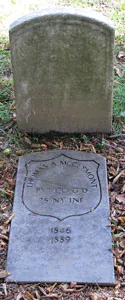
McCLYMONT, JAMES A. (enlisted as THOMAS, JOHN) (1846-1889). Private, 75th New York Infantry, Companies G and D. A native of Ireland, McClymont enlisted as a private at Tarrytown, New York, on September 26, 1864, and mustered into Company G of the 75th New York. He was borne on the rolls as John Thomas. His muster roll notes that he was a substitute for Marcus Risk of Cortlandt, New York. A blacksmith, he was 5′ 4½” tall with gray eyes, brown hair and a fair complexion. On October 19, 1864, he suffered a flesh wound to the leg at a skirmish at Cedar Creek, Virginia. On November 19, he was transferred into Company D, and was discharged at Savannah, Georgia, on June 28, 1865. A member of the Henry M. Lee Post #21 of the G.A.R., he served as its quartermaster sergeant. In 1890, Ida McClymont applied for and received a widow’s pension, certificate 347,092. Section 45, lot 4841.
McCONNACH (or McCONICH), LEWIS (1834-1877). Sergeant, 79th New York Infantry, Company D. Born in Scotland, he enlisted at New York City on May 13, 1861, as a sergeant. He mustered into the 79th New York on June 28 and was discharged on August 3 at Camp Ewen, D.C. His muster roll notes that he was borne on the rolls as “McConachie,” The 1868 Brooklyn Directory lists him as a soap manufacturer while the 1870 Brooklyn Directory reports that he was a tea salesman. He was a wholesale grocery salesman according to the 1875 New York State census. He last resided at 165 23rd Street, Brooklyn. His death was caused by pneumonia. In 1893, Mary McConnach applied for a widow’s pension, application 578,257, but it was never certified. Section 174, lot 21049.
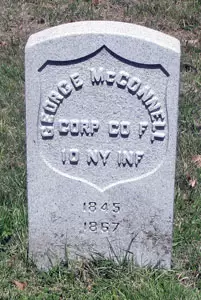
McCONNELL, GEORGE (1845-1867). Corporal, 10th New York Infantry, Companies E and F. McConnell, who was born in Ireland, enlisted as a private at New York City on April 19, 1864, and immediately mustered into Company E of the 10th New York. As per his muster roll, he was a plumber who was 5′ 5″ tall with gray eyes, sandy hair and a fair complexion. He was wounded at the Battle of Spotsylvania Court House, Virginia, on May 12, 1864. On October 10, 1864, he was promoted to corporal effective upon his intra-regimental transfer to Company F. On June 30, 1865, he mustered out of service at Munson’s Hill, Virginia. His last residence was in New York City. His death was caused by a hernia. Section 115, lot 11193, grave 316.
McCORD (or McCARD), JAMES (1838-1873). Sergeant, 82nd New York Infantry, Companies C and A; corporal, 2nd Regiment, New York State Militia, Company C. Although one record says that McCord was born in Ireland, his muster roll for the 2nd Regiment states that he was born in New York City. After enlisting as a private at New York City on June 14, 1861, he mustered into Company C of the 2nd Regiment, New York State Militia, that same day. According to his muster roll, he was a clerk who was 5′ 8″ tall with blue eyes and light hair. He was promoted to corporal on December 7, 1861, and reduced to ranks on December 28. His muster roll indicates that he was a 4th corporal in Company C of the 82nd New York Infantry in May and June of 1862; the date of the inter-regimental transfer is unknown but he is listed as a corporal on his muster roll as of July and August of 1862 and rose to 3rd sergeant on January 1, 1863, and to 2nd sergeant in March 1863.
As per his muster roll, McCord was on recruiting duty in New York with the rank of sergeant from July 1863 through April of 1864. A letter in his behalf from Tammany Hall, the Democratic political organization headed by William Magear “Boss” Tweed (see) dated March 5, 1864, asked that he remain on detailed service because he was faithful and a worker. McCord’s colonel noted, “He is of more service to his country in getting men than any non-commissioned officer in the city.” McCord transferred into Company A as a sergeant on May 22, 1864, upon consolidation of his unit. He mustered out on June 14, 1864. He last lived at 97 Charles Street in Manhattan. The cause of his death was pneumonia. Section 17, lot 17245, grave 1734.
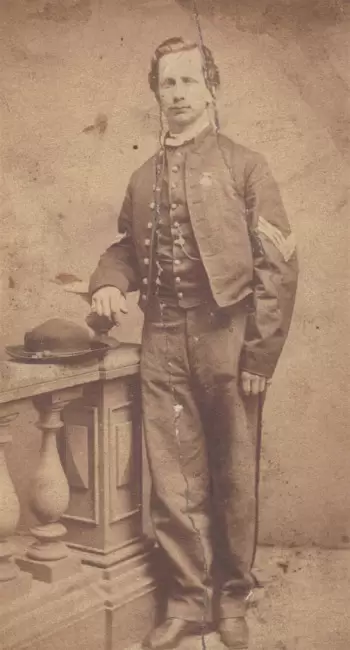
McCORD (or McCORT), SMITH (1833-1869). Private, 133rd New York Infantry, Company F. McCord, a native of New York City, was employed as a clerk according to the 1855 census. During the Civil War, he enlisted at New York City as a private on August 22, 1862, and mustered into the 133rd New York on September 24. As per his muster roll, he was a laborer who was 5′ 6″ tall with blue eyes, light hair and a light complexion. He was discharged from military service on May 6, 1865, at Washington, D.C. His death listed as a casualty, he last resided at 175 Taylor Street in Brooklyn. His remains were moved on October 26, 1875. Section 114, lot 8999, grave 9.
McCORKLE (or McCORCKLE), JOSEPH H. (1836-1862). Private, 82nd New York Infantry, Company C. A New Yorker by birth, he was a jeweler as per the 1855 New York State census and the 1860 census. A resident of 7 Essex Street in Manhattan, he enlisted at New York City on September 1, 1861, and mustered into the 82nd New York, also known as the Second Militia or the State Guards, that same day.He was killed in battle at Antietam, Maryland, on September 17, 1862. The 82nd suffered massive losses at Antietam; out of 339 men engaged, 128 were reported killed, wounded or missing. On September 28, 1862, The New York Times reported that the private letter written by Henry A. Maxwell, the captain of McCorkle’s company, was obtained by the newspaper. McCorkle’s name was listed as among the dead. The letter to the captain’s father, from Sharpsburg, Maryland, on September 21, describes the details of the company’s march:
…When we left Rockville, we followed up the enemy and brought him to a stand in the mountains around Frederick, gave him a good licking there. He then retreated to the second mountain pass (this was on this day week, Sunday). Most of the forenoon was spent in finding out his position. When we found out we soon brought him to an engagement. Franklin’s troops stormed the mountain and routed the enemy. It was here than Gen. Reno fell. Our divison was not engaged, but held in reserve. (Sedgewick’s regiments of Sumner’s corps.) We were then marched up, and we took up and held the position for that night. The enemy skedaddled before morning. We were soon up with him again, and had several fights, but our brigade was not in action till Wednesday.
On Tuesday night we were served with eighty rounds of ball-cartridges a man—that looked like sharp work the next day. I went to sleep early that night, and about three o’clock next morning we were waked up by the beat of the drum, cooked some coffee, drank it, and piled all the knapsacks in a heap, were soon in line, and the whole corps marched off in three columns, our brigade in advance. We soon reached a river, which we had to ford, the enemy having burned the bridge. We marched on for one and a half miles, when we formed in three lines of battle, our brigade in front. We pushed on through a terrific fire of artillery, to the field where Hooker had fought the previous evening. Here we had to pick our steps—the ground was literally strewn with the dead and wounded. Such a terrible sight I hope I shall never see again. I have been on many battle-fields, but this baffles all description. Still, our gallant fellows kept steady, all the time being swept with a terrific artillery fire. We soon got up to our work, halted in line, and delivered a terrific volley among the rebels, which caused them to stagger, but not to run. They kept steady to their work, and hurled fresh troops on our left, which forced us back. They then seeing their advantage, brought artillery to bear upon us, which made us yield a little; but the old Second stood up to it manfully. Nearly every man in the regiment bore marks of that terrible fire—bullets through their clothes, or scratches everywhere. I was scratched on the hand by a bullet—it only stung a little. We then fell back and held our position, in spite of all the force they could hurl against us, and night put an end to the fight, and we sank down to rest on the bloody held we had won, thinking on the morrow the fight would be opened again with redoubled fury. But, strange to say, it was not.
We held communication with the enemy in the afternoon through a flag of truce. Lieut. Simmes went with the flag, and he reported to me from all appearances they were going to leave. They were all in marching order, and sure enough they left that night. We have captured flags, artillery and any quantity of prisoners, and their dead cover the country for miles and miles around. I could say a good deal more, but have not room. Oh, how thankful I am that the Lord has spared my life.
On October 6, 1862, Mary McCorkle’s applied for and received a widow’s pension, certificate 22,941. McCorkle’s obituary in The New York Times on January 9, 1863, invited officers and members of his regiment who were in New York City to attend his funeral. Interment at Green-Wood was on January 11, 1863. In 1871, a minor received a pension, certificate 155,871. There is a stone bearing his name at Antietam National Cemetery. Section 115, lot 13536 (Soldiers’ Lot), grave 55.
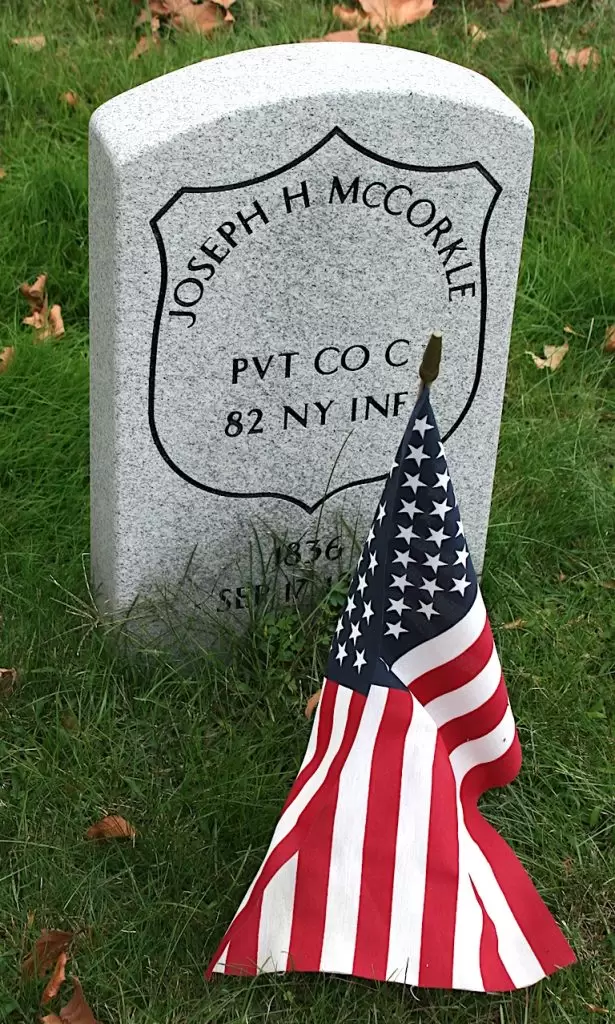
McCOUBREY (or McCOUBRY), WILLIAM (1832-1890). Sergeant, 79th New York Infantry. Of Irish birth, he enlisted as a private at New York City on May 13, 1861, and mustered into the 79th on May 28. At some point, he was promoted to sergeant. He was discharged for disability on February 6, 1862, at Falmouth, Virginia. The Brooklyn Directories of 1868 and 1872, the 1875 New York State census, and the Brooklyn Directories for 1881, 1888, 1889 and 1890 note that he was a carpenter. Although he applied for an invalid pension in 1889, application 728,576, it appears that he died before it was granted. As per his obituary in the Brooklyn Daily Eagle, he was a member of the Winchester Post #197 of the G.A.R. and a Freemason; members of both organizations were invited to attend his funeral. McCoubry last lived on Jay Street in Brooklyn. A minor was awarded a pension after his death, certificate 371,244. Section 187, lot 20062.
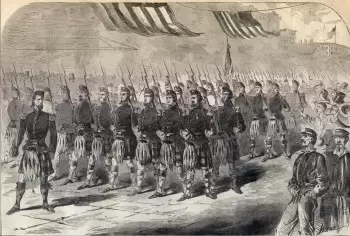
McCOURT, HENRY (1828-1884). Private, 83rd New York Infantry, Company H. Originally from Ireland, McCourt enlisted at as a private at New York City on October 4, 1861, the same date that he mustered into the 83rd New York. On December 13, 1862, he was wounded at the Battle of Fredericksburg, Virginia, and was discharged for disability on April 22, 1863, at New York City. On July 22, 1863, his application for an invalid pension was granted under certificate 128,555. The 1870 and 1880 censuses and the 1882 Jersey City Directory note that he was living in Jersey City, New Jersey, and working as a painter. His last residence was 65 Lincoln Place in Jersey City. His death was attributed to heart disease and albuminuria, a urinary infection. Section 14, lot 4969, grave 179.
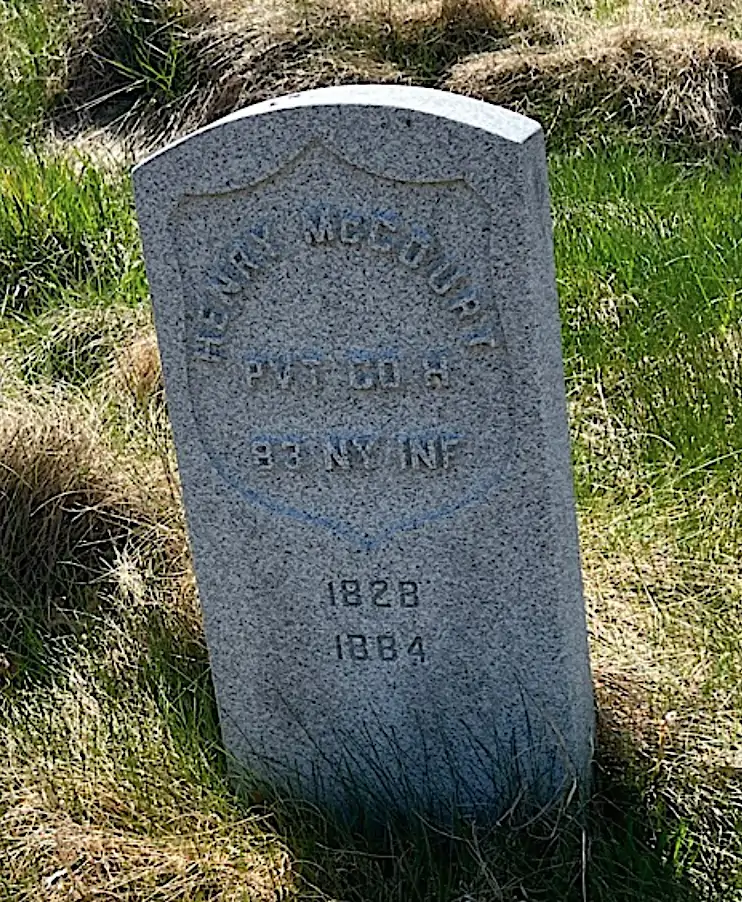
McCOY, CHARLES W. (1844-1883). Private, 79th New York Infantry, Company H. A native of Putnam County, New York, McCoy was a wire drawer, a worker who produces metal products such as wire, tubes and coils. After enlisting as a private at New York City on January 18, 1864, McCoy mustered into the 79th New York that same day. As per his muster roll, he was 5′ 6½” tall with gray eyes, brown hair and a fair complexion. He was discharged on May 31, 1864, at Fort Monroe, Virginia. In 1879, his application for an invalid pension was approved under certificate 277,269. According to the 1880 census, he was living in Chambersburg, New Jersey, where he was employed in a wire mill. The Veterans Schedule of 1890 confirms his Civil War service. He last lived in New Haven, Connecticut. After his death from heart disease, Josephine McCoy, who is interred with him, applied for and received a widow’s pension, certificate 284,987. Section 179, lot 11808.
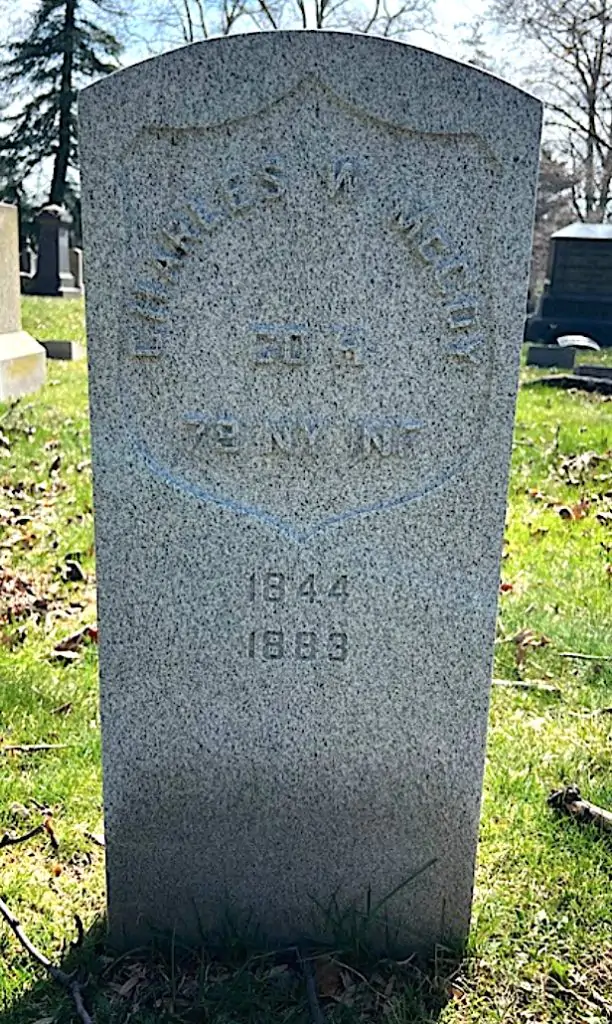
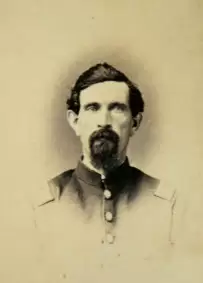
McCOY, WILLIAM (1833-1885). First lieutenant, 88th New York Infantry, Company G. Of Irish birth, he enlisted as a sergeant on October 16, 1861, at Jersey City, New Jersey, and mustered into the 88th New York. He rose through the ranks becoming a first sergeant, then second lieutenant on September 22, 1862, and a first lieutenant on December 13, 1862. He was wounded sometime during the War and mustered out on June 12, 1863. His death certificate indicates that he was a blacksmith. At the time of his death, caused by phthisis pulmonalis, he resided at 59 Bowers Street in Jersey City. Section 2, lot 5499, grave 746.
McCREARY, ABRAM (1831-1921). Second lieutenant, 12th Regiment, New York State National Guard, Company I. McCreary was born in Manhattan. After enlisting as a first sergeant at New York City to serve for 30 days on June 19, 1863, he was promoted to second lieutenant four days later. He mustered into the 12th on July 4, and mustered out on July 20 at New York City. The 1863 Draft Registration indicates that he was a machinist. According to the 1870 census, he was living in Brooklyn, worked in oil refining, and had a personal worth of $3,000. McCreary was a machinist in Brooklyn at the time of the 1880 census; he was living in Rockland County, New York, and employed as an oil dealer according to the 1900, 1910 1915, and 1920 censuses. A resident of Monsey, New York, he died from acute gastritis. Section 69, lot 3759.
McCRODDON, JOSEPH (1836-1874). Private, 61st New York Infantry, Company K. Originally from Ireland, McCroddon enlisted as a private on November 9, 1862, at New York City, and mustered into his company the same day. On July 2, 1863, he was wounded in action at the Battle of Gettysburg, Pennsylvania. After returning to his regiment, he was discharged for disabilities on May 12, 1865. His last residence was 435 East 18th Street, Manhattan. Section 127, lot 17931, grave 90.
McCULLEN (or McCULLIN), HENRY (1813-1893). Private, 79th New York Infantry, Companies B and H. Irish-born, he was a laborer as per the 1850 census. During the Civil War, McCullen enlisted at New York City as a private on September 29, 1862, mustered into Company B the 79th New York on that date, was transferred to Company H at some point, and mustered out on May 31, 1864, at New York City. The 1870 census indicates he was a rockman (worker in a quarry, usually placing charges) who owned real estate worth $3,000 and whose personal worth was $500. In 1884, his application for an invalid pension was granted, certificate 528,601. The 1890 Veterans Schedule confirms his service in the Civil War and notes that he suffered an injury to his right leg during that conflict. He last lived at the Soldiers’ Home in Bath, New York, where he was admitted with rheumatism and ultimately succumbed to senility. Section 24, lot 5666.
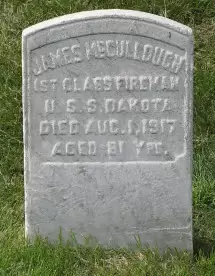
McCULLOUGH, JAMES (1836-1917). First class fireman, United States Navy. According to his government-issued gravestone, circa 1900, he served in the Navy aboard the USS Dakota. His age seems to indicate that he would have been in the Navy during the Civil War. He succumbed to endocarditis. Section A, lot 8100, grave 375.
McCULLOUGH, JAMES (1841-1917). United States Navy. Although his tombstone is inscribed that he served in the Navy, the dates of the service cannot be ascertained. He last lived at 323 Sandol Street in Brooklyn. Section 122, lot 17806, grave 370.
McCULLOUGH, WILLIAM (1825-1868). Private, 47th New York Infantry, Company B. After enlisting at Brooklyn as a private on July 15, 1861, McCullough, who was born in Scotland, mustered into the 47th Infantry on August 8. He was discharged on August 8, 1864, at Bermuda Hundred, Virginia. His death attributed to sunstroke, he last lived at 1193 East 47th Street in Manhattan. Section F, lot 17197.
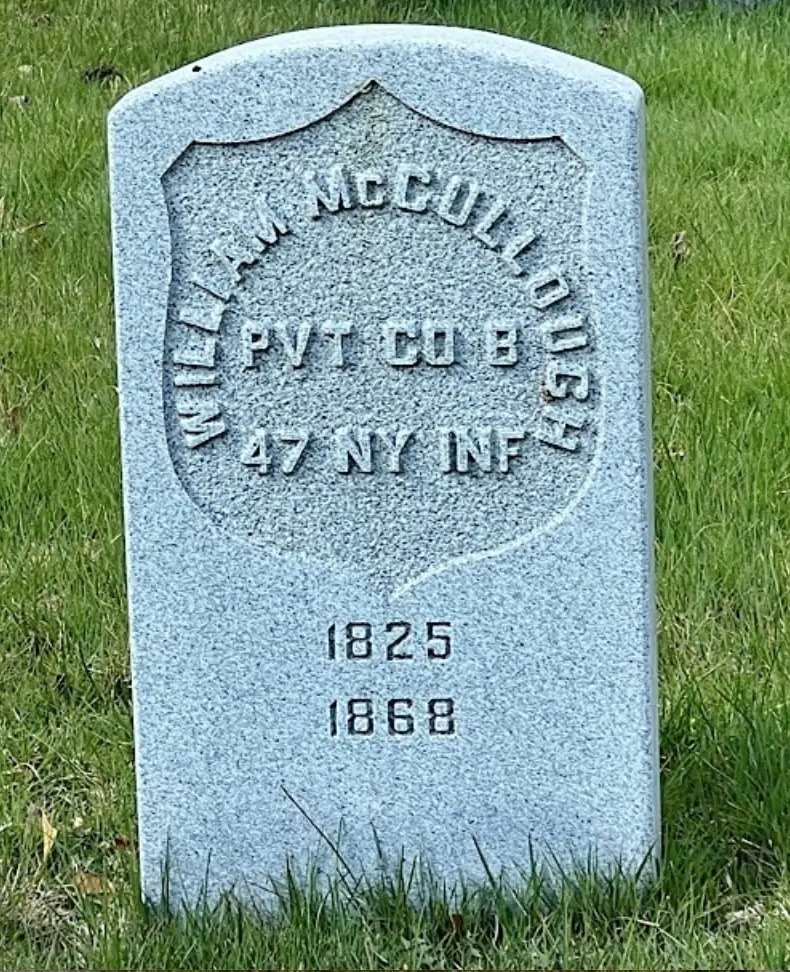
McCUNE, ALEXANDER M. (1832-1864). Captain, 74th New York Infantry, Companies K, F, and G; adjutant, 71st New York Infantry, Company F. Originally from Ohio, he was a clerk living in New York City as per the 1850 census. A resident of 173 West 28th Street in Manhattan, McCune enlisted as a second lieutenant at New York City on May 10, 1861, and was commissioned into Company F of the 71st New York on June 27. He was promoted to first lieutenant on May 10, 1862, and to adjutant on May 31, 1862, at which time he was transferred to the Field and Staff. McCune was discharged on August 5, 1862. He re-enlisted as a second lieutenant on September 15, 1862, at New York City, and was commissioned into Company K of the 74th New York on December 27, 1862. On February 7, 1863, he was promoted to first lieutenant effective upon his transfer to Company F on March 7, and then rose to captain on December 4, 1863, effective upon his transfer to Company G ten days later. On June 6, 1864, he was severely wounded by a gunshot in the Battle of Cold Harbor, Virginia, necessitating the amputation of his left leg. After being moved to the Armory Square Hospital in Washington, D.C., he died there of his wounds on June 19.
Francis A. Walker in History of the Second Army Corps in the Army of the Potomac, Volume 2, Part 4, notes that McCune was killed by a solid shot while standing at the door of General Winfield Scott Hancock’s tent and that the headquarters of the corps were riddled by bullets. Hancock, realizing his responsibility to the young soldiers, then moved his headquarters back to a safer locale. The Record of Deceased Soldiers notes that his left leg was “carried away by a shell.” On August 4, 1864, Catharine McCune, his mother, who is interred in the same lot, applied for and received a pension, certificate 42,042. He was interred at Green-Wood on March 2, 1865. Section 188, lot 15693.
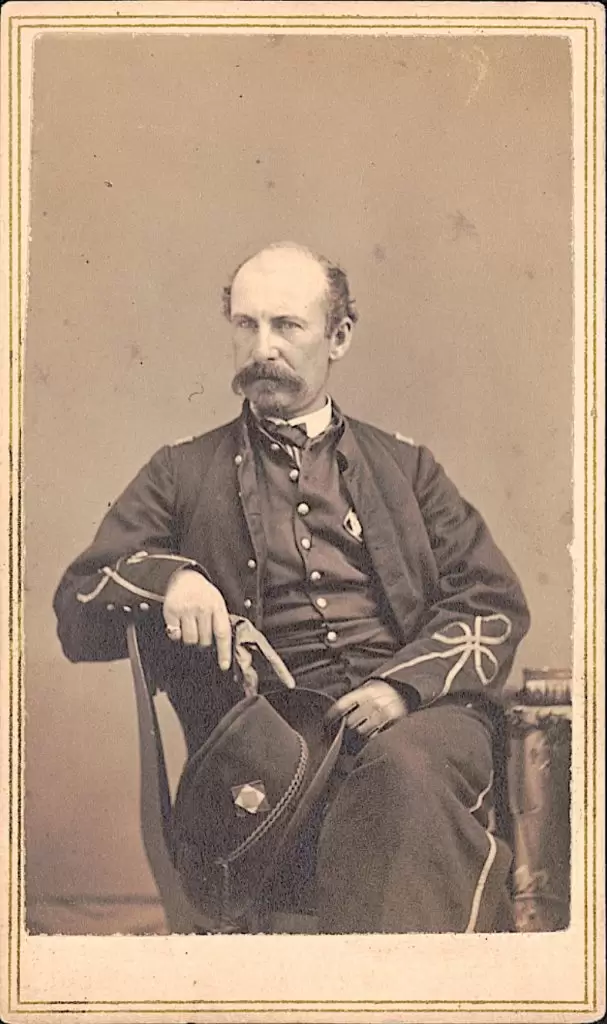
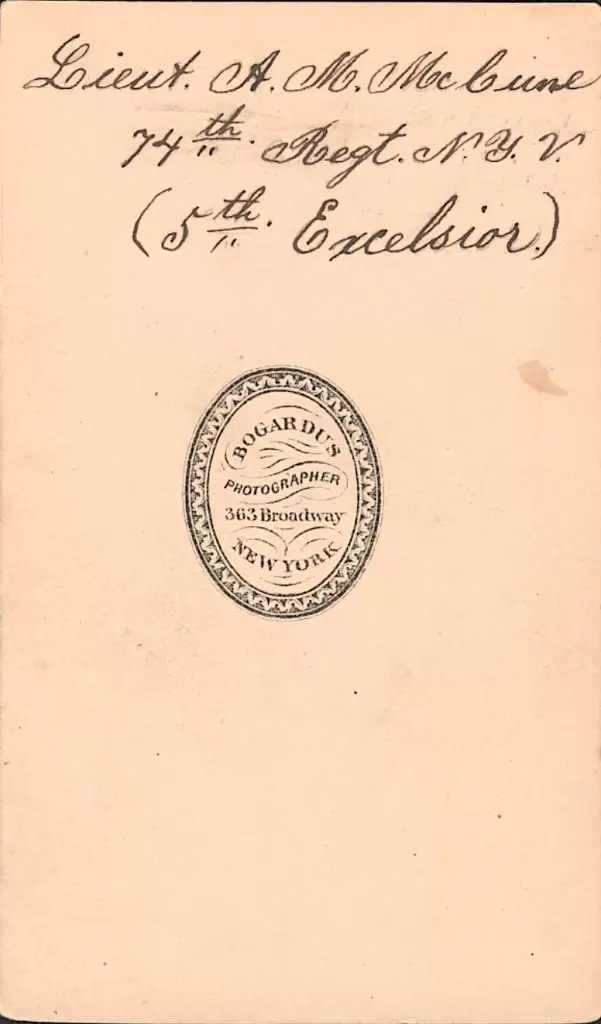
McCUSKER, ROBERT (1838-1876). Wagoner, 47th New York Infantry. An Irish native, McCusker was a wagoner in the 47th New York. His company and other details are not known. As per the census of 1870, he was a painter whose personal worth was listed as $300. His last residence was 65 East 32nd Street in Manhattan. He died of phthisis. Section 158, lot 16181.
McCUTCHEON (or McCUTCHON, MACCUTCHEON, McCUTCHIN), GEORGE W. (1843-1897). Private, 48th New York Infantry, Company C. As per the 1850 census, McCutcheon lived in Brooklyn with his parents and two younger siblings; that census notes that he attended school. The 1855 New York State census reports that he lived in Brooklyn with his parents and three younger siblings. By the time of the 1860 census, he had four siblings and still lived at home with his parents.
During the Civil War, McCutcheon enlisted at Brooklyn as a private on September 16, 1861, and mustered that same day into Company C of the 48th New York Infantry. He re-enlisted on March 31, 1864, was taken as a prisoner of war on August 16, 1864, at Strawberry Plains, Virginia, and was paroled on an unknown date. He mustered out at Raleigh, North Carolina, on September 1, 1865.
The 1865 New York State census shows that McCutcheon lived in Brooklyn with his parents and siblings. The 1883 Brooklyn Directory lists him as a salesman and the 1884 Brooklyn Directory identifies him as a news agent living at 690 Bedford Avenue. On April 12, 1890, he married Jessie Muir in Brooklyn; they had a daughter who was known as “Jessie Junior.”According to a descendant, he also had a son named Harry, likely from a previous marriage. The 1891 New York City Directory indicates that he was a merchant. His descendant notes on the ancestry.com website that McCutcheon worked for Prudential Life Insurance in 1895. That same entry indicates that he died from consumption and that the doctor’s bill for his 10-week illness was $40.00, negotiated down to $25.00 by his wife. Funeral expenses were $131.00. He left insurance in the amount of $440.00 and a pension of $10.00 per month.
Shortly after his death in 1897, his wife filed for a widow’s pension, application 666,549, but there is no evidence that it was certified. As per his will, filed in Kings County Probate Court in 1898, he last lived at 215 Ralph Avenue in Brooklyn. Section 74, lot 10506, grave 14.
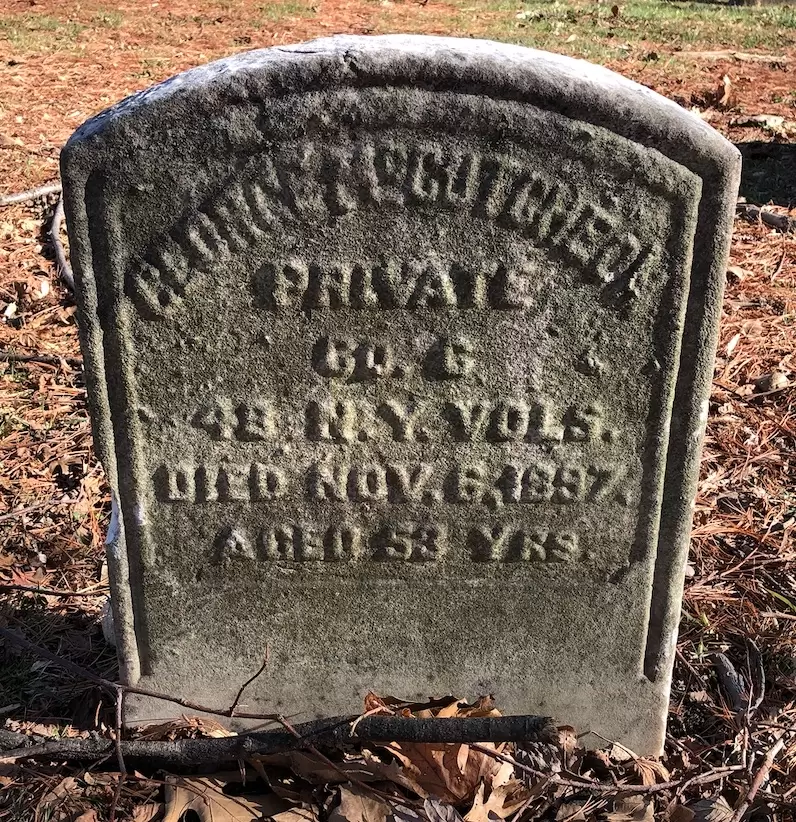
McDERMOTT, JAMES (1827-1871). Private, 174th New York Infantry, Company C. Of Irish origin, McDermott enlisted as a private at New York City on October 10, 1862, and mustered into the 174th on the same day. There are no further details about his service. As per his muster roll, he was a speculator who was 5′ 6″ tall with blue eyes, brown hair and a dark complexion. His muster roll notes that he was not borne on the roll of any company. He last lived in New York City. Section 67, lot 6170.
McDERMOTT, JOHN (1830-1866). Private, 173rd New York Infantry, Company K. After McDermott enlisted at Brooklyn as a private on October 23, 1862, he mustered into his company on November 10. As per his muster roll, he was a clerk who was 5′ 8″ tall with grey eyes, “mixed” hair and a light complexion. Further details about his service are not available. He last lived at 146 DeGraw Street in Brooklyn, New York. Section 116, lot 4073, grave 431.
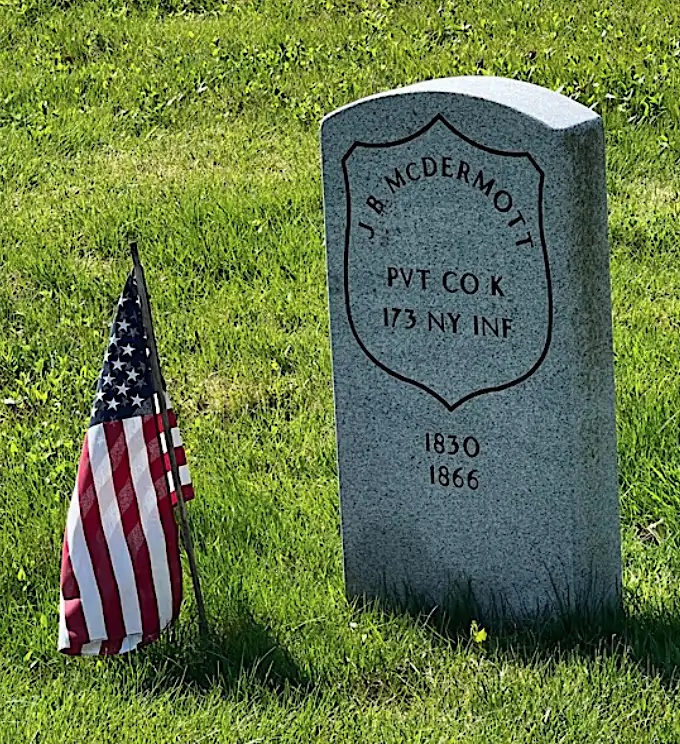
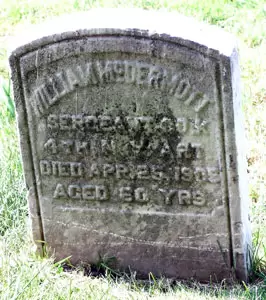
McDERMOTT, WILLIAM (1842-1905). Private, 4th New York Heavy Artillery, Battery K. McDermott enlisted at Rochester, New York, on May 26, 1863, and mustered into Battery K on June 21. He was promoted to corporal on December 30, 1864, to sergeant on August 2, 1865, and mustered out at Washington, D.C., on September 26, 1865. His pension record also indicates service in the United States Navy but there are no details about that service. As per his obituary in the Brooklyn Daily Eagle, he also served with the 14th Brooklyn during the Civil War but that service is not on any of his soldier records; it may be that he served with the 14th after the Civil War. That obituary notes that he was a member of the Fourteenth Regiment Veteran Association, having served as a color sergeant for many years and having a certificate denoting 25 years of service. He was also a member of the Moses F. O’Dell Post #443 of the G.A.R. and the Royal Arcanum.
After the Civil War, McDermott was appointed to the postal service. He died while sorting papers in the city delivery department of the General Post Office where he worked for about 30 years and reportedly was esteemed by his colleagues. The Brooklyn Standard Union, in an article about the puzzling cause of McDermott’s death on April 26, 1905, reports that he “reeled and fell backwards” while he was alone sorting mail at the paper table. This was considered a bit of a mystery; colleagues believed he fell backward after being stricken with a heart attack while the official cause of death was listed as an “accident.” He never regained consciousness after he fell, couldn’t be revived by the ambulance surgeon and died shortly after being taken to Brooklyn Hospital (although the Brooklyn Daily Eagle reported that he was taken to his nearby home). He applied for a pension in April 1905, application 1,334,612, but died before it was certified. His last residence was at 74 Johnson Street in Brooklyn. Section 6, lot 20118, grave 639.
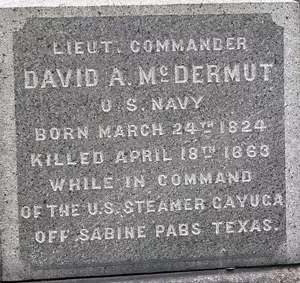
McDERMUT (or McDERMOTT), DAVID A. (1824-1863). Lieutenant commander, United States Navy. A New York native, McDermut began his career in the Navy as a midshipman on November 8, 1841, upon his admission to the United States Naval Academy. He was promoted to passed midshipman on August 10, 1847. He rose to master on March 1, 1855, and to lieutenant on September 14. On July 16, 1862, he was promoted to lieutenant commander.
During the Civil War, McDermut was commander of the USS Cayuga, a gunboat that was part of the West Gulf Blockading Squadron. As of March 26, 1862, the vessel served along the Gulf Coast of Texas and participated in the engagement at Forts Jackson and St. Philip below New Orleans, Louisiana, in April 1862. The Cayuga was intent upon neutralizing the Confederate steamers in Sabine Bay. On April 4, 1863, together with Lieutenant Commander Abner Read of the USS New London, they captured the captain, pilot, second mate and another man of the Josiah Bell without firing a shot.
On April 18, 1863, Read and McDermut, each with a five men and Read with his pilot, ventured again toward the lighthouse at Sabine Bay. Unbeknownst to them, two Confederate officers and at least thirty men were awaiting their arrival. (Read wrote in his report that there were 60-70 men awaiting them.) Three men were captured immediately as Read and McDermut ran back to their boats. McDermut, wounded, could not get his boat off the ground and waved his white handkerchief as a flag of surrender. Read managed to get his boat off the mud but in the fire that followed, lost an eye; all but one of his men were wounded. Read wrote that the enemy directed its rifle fire and buckshot at the New London and that under the circumstances, the boat’s survival was “miraculous.” McDermut, although not believed to have been seriously wounded, died later that day. His crew and boat were taken by the Confederates. Read in his letter to Gideon Welles, Secretary of the Navy, wrote that upon accepting the remains of McDermut he fully believes that “he was mortally wounded while sitting in his boat after surrender.” McDermut’s involvement in the Civil War is recorded on his tombstone. It notes that he died on April 18, 1863, “while in command of the USS Cayuga off Sabine Pass, Texas.” His funeral took place at Christ Church in New Orleans on April 25, 1863. Interment at Green-Wood was on March 19, 1864. Elizabeth McDermut, who is interred with him, applied for and received a widow’s pension, certificate 1,279.
Two ships have been named for McDermut, the first on August 6, 1918, and christened at Bethlehem Shipyards in Squantum, Massachusetts; the vessel was scrapped in 1931. The second ship was christened by Mrs. Woodrow Wilson on October 17, 1943, at Federal Shipbuilding and Drydock Company in Kearny, New Jersey. The second vessel reported for duty at Pearl Harbor as part of the Pacific Fleet in February 1944, where she won many citations and service medals. Section 60, lot 529.
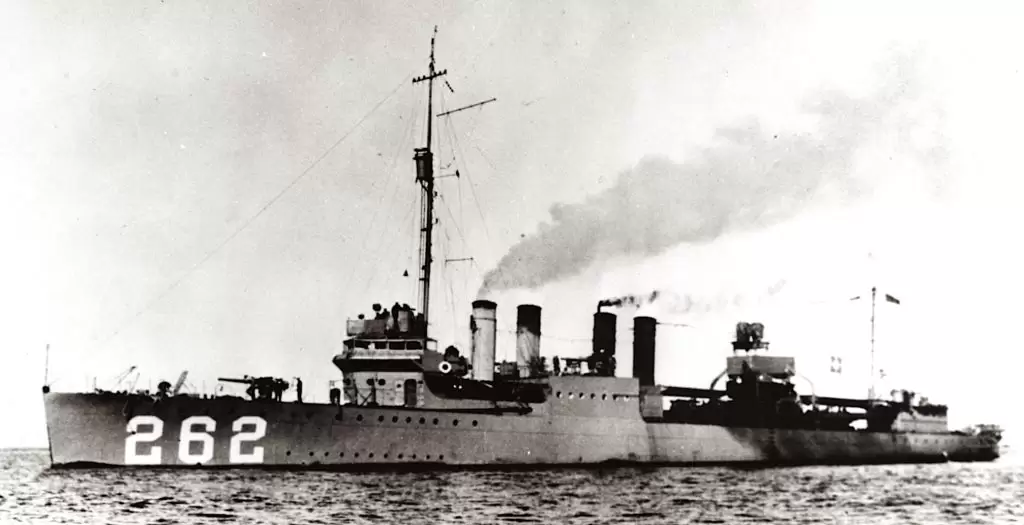
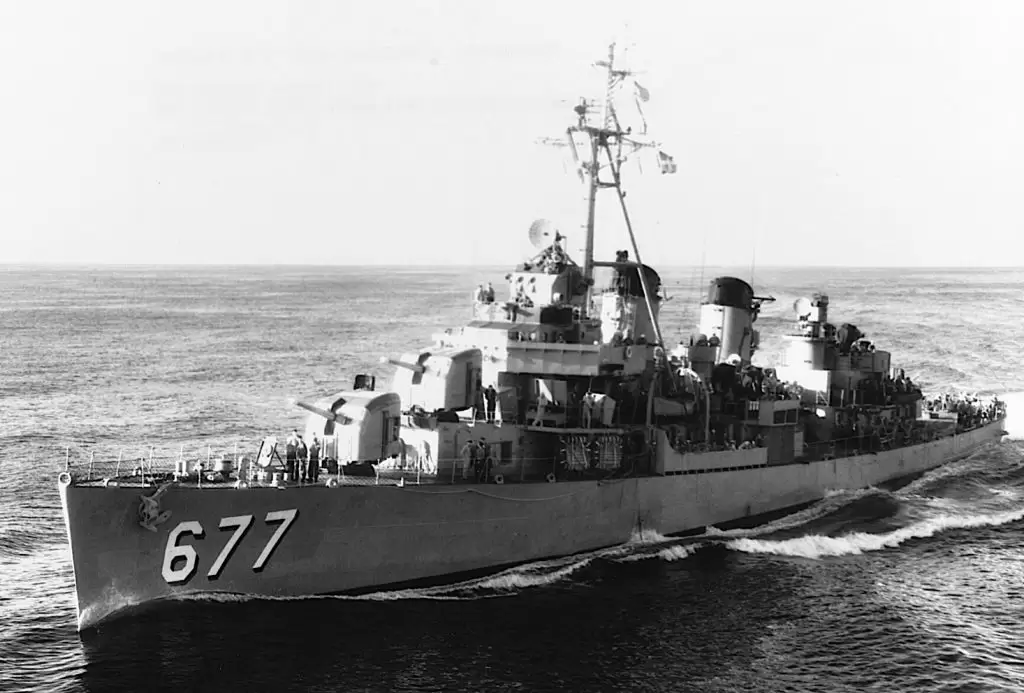
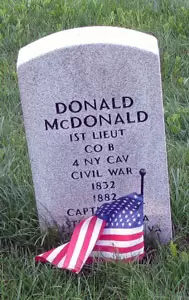
McDONALD, DONALD (1832-1882). First lieutenant and regimental adjutant, 4th New York Cavalry, Company B. A native of Scotland, he enlisted at New York City as a private on August 29, 1861, and mustered into the 4th New York Cavalry that day. McDonald was captured in action on June 2, 1862, at Strasburg, Virginia, and paroled on September 7 at Richmond, Virginia. He rejoined his regiment on January 5, 1863, was promoted to corporal on February 25, and to commissary sergeant on July 26. Upon re-enlistment on December 25, 1863, he was reduced to the rank of private. On February 15, 1864, he was promoted to first lieutenant and regimental adjutant. Taken as a prisoner of war a second time after being captured in action on September 1, 1864, at Winchester, Virginia, he was paroled on February 22, 1865, at James River, Virginia, and mustered out on March 14. He was a member of the Rankin Post #10 of the G.A.R. and served as its quartermaster sergeant and member of the board of trustees. His last residence was 29 Manhasset Place in Brooklyn. Section 2, lot 5499, grave 1644.
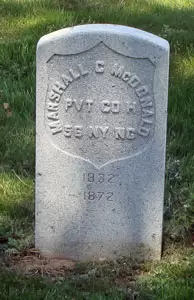
McDONALD, MARSHALL C. (1832-1872). Private, 56th Regiment, New York State National Guard, Company H. McDonald served for 30 days when the 56th Regiment was activated in 1863. His last address was 1035 Pacific Street in Brooklyn. He succumbed to consumption. Section 117, lot 10975, grave 885.
McDONALD, OLIVER L. (1844-1874). Private, 1st New York Light Artillery, Battery L. McDonald, who was born in Schenectady, New York, was employed as a clerk at the time he enlisted as a private at Palmyra, New York, on December 1, 1861. Twelve days later, he mustered into Battery L of the 1st New York Light Artillery and served with his unit until he mustered out on December 13, 1864. His regiment, known as the Rochester Union Greys, was part of the Army of the Potomac. He died from phthisis in Chicago, Illinois, where his funeral was held at the home of his brother-in-law. Section 100, lot 9039.
McDONALD, PETER (1817-1896). Private, 174th New York Infantry, Company B; 162nd New York Infantry, Company B. Originally from Ireland, he enlisted at New York City on October 2, 1862, and mustered into the 174th New York on October 17. About August 15, 1863, he was wounded in Baton Rouge, Louisiana. On February 17, 1864, he was transferred into the 162nd New York. He last lived at 410 West 24th Street in Manhattan. He succumbed to nephritis. Section 62, lot 4449, grave 8.
McDONALD, ROBERT (1844-1882). Corporal, 139th New York Infantry, Company E. Of Scottish origin, he enlisted as a private at Brooklyn on August 23, 1862. After mustering into the 139th New York on September 9, 1862, he received a promotion to corporal on August 27, 1864, and was discharged at Richmond, Virginia, on June 19, 1865. The 1871 Brooklyn Directory and the 1875 New York and 1880 censuses report that he was a painter. In 1879, his application for an invalid pension was approved, certificate 271,251. His last residence was 557 Union Street in Brooklyn. Josephine McDonald applied for and received a widow’s pension in 1890, certificate 315,805. Section D, lot 19604.
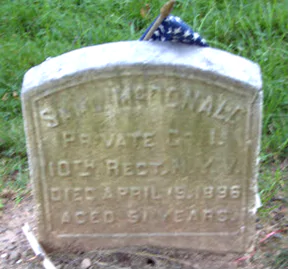
McDONALD (or MACDONALD), SAMUEL I. (1842-1896). Private, 10th New York Infantry, Company I. A New York City native, he enlisted and mustered into Company I of the 10th New York on October 8, 1861. He was severely wounded in his left arm at the Battle of Second Bull Run, Virginia, on August 30, 1862, and was taken as a prisoner of war on the same day. He was moved to a general field hospital where his left arm was amputated and from which he was paroled three days later. McDonald was discharged from service because of his disabilities on December 16, 1862, at Washington, D.C. On April 18, 1863, his application for an invalid pension was approved, certificate 15,612.
The 1880 census and the 1897 Brooklyn Directory indicate that McDonald was a clerk in a store. The 1890 Veterans Schedule and his government-issued gravestone, issued in the early 1900s, confirm his service in the 10th. His last residence was 929 Gates Avenue in Brooklyn. Elizabeth McDonald, who is interred with him, applied for and received a widow’s pension shortly after his death, certificate 430,244. Section 154, lot 22128, grave 3.
McDONALD, WILLIS (1842-1918). Sergeant, 17th Connecticut Infantry, Company F. McDonald was born in Brooklyn. A resident of Norwalk, Connecticut, McDonald enlisted as a private on August 28, 1862, immediately mustered into the 17th Connecticut, and was promoted to sergeant on November 25, 1863. As per his obituary in the Brooklyn Daily Eagle, which confirms his Civil War service, he fought at the Battles of Fredericksburg and Chancellorsville in Virginia; at Gettysburg, Pennsylvania; and at the siege of Fort Wagner and Fort Sumter in South Carolina. He mustered out on July 19, 1865, at Hilton Head, South Carolina. Retaining his interest in military affairs, he served for many years with the 7th New York Regiment.
In civilian life, McDonald was a master printer whose printing and stationery business was at 39-41 Gold Street in Manhattan; the 1880 census lists him as a stationer. He was one of the first members of the New York Typothetae, an organization of master printers. Active at the Hanson Place M. E. Church in Brooklyn, he was a member for forty years, held a leadership position on its board, and taught Bible classes there. McDonald also was a member of the American Board of Foreign Missions. He was a charter member of the Ulysses S. Grant Post #327 of the G.A.R. as of 1883 and served as post commander in 1891. His application for a pension was approved in 1907, certificate 1,130,567. McDonald last lived at 139A Oxford Street in Brooklyn but died at the residence of his son-in-law in Amityville, Long Island. His obituary notes that he was interred at Pine Lawn Cemetery; he was re-interred at Green-Wood on October 9, 1929. His widow, Mary McDonald, who was re-interred with him, applied for a pension in 1918, application 1,130,494, but there is no certification number. Section 94, lot 297.
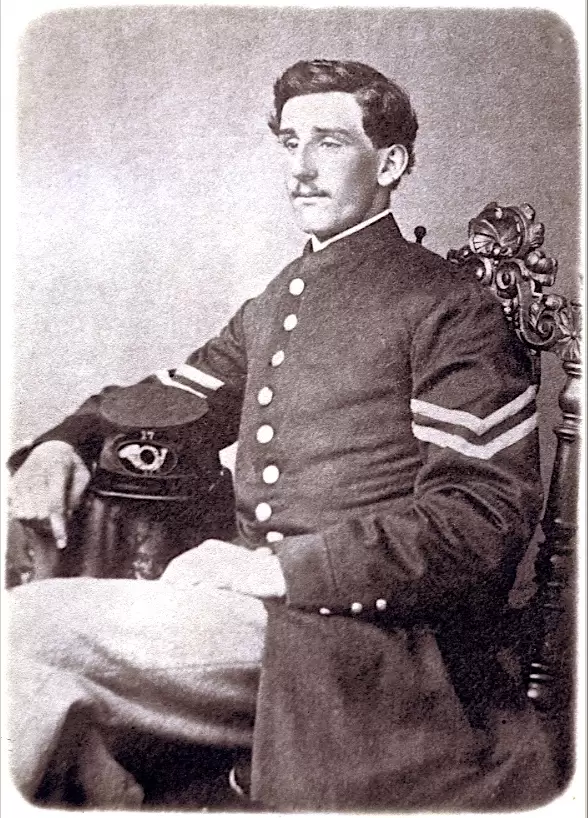
McDONOUGH, JAMES (1821-1885). Private, 11th New York Cavalry, Company H. By one account, McDonough was a native of England, although his muster roll indicates that he was born in Ireland. During the Civil War, he enlisted as a private at Brooklyn on February 28, 1862, and mustered into the 11th New York Cavalry on the same date. According to his muster roll, he was a wagoner who was 5′ 5″ tall with blue eyes, dark hair and a ruddy complexion. He was discharged for disability on January 14, 1863. His last residence was in New York City. Section 165, lot 18083.
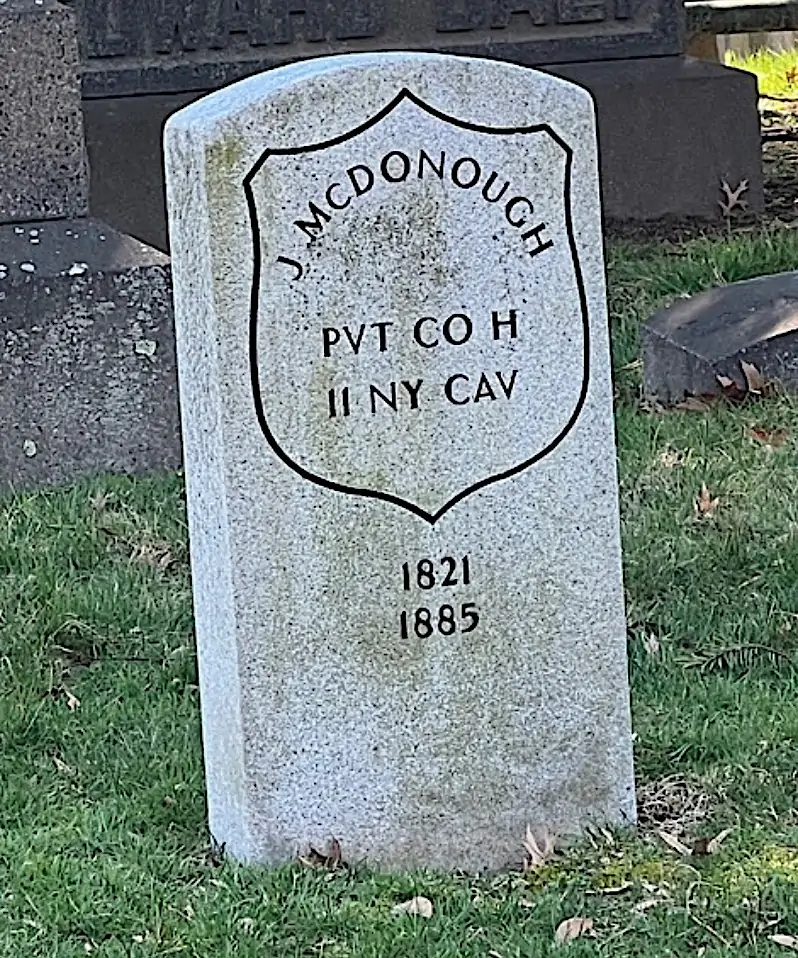
McDOUGALL, CHARLES H. (1842-1874). Private, 22nd Regiment, New York State National Guard, Company I. McDougall, who was born in New York City, enlisted there as a private on May 31, 1862, mustered into the 22nd Regiment on June 18, and mustered out after three months on September 5 at New York City. His last residence was 429 West 50th Street in Manhattan. Section 126, lot 5047, grave 673.
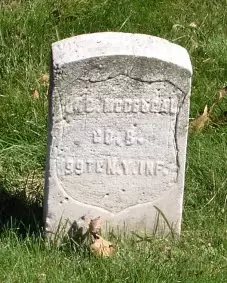
McDOUGALL, JOHN (1827-1896). Private, 99th New York Infantry, Companies B and C. Originally from Scotland, he enlisted at New York City on November 4, 1861, and mustered in the next day. On March 14, 1862, he was wounded at the Battle of New Berne, North Carolina. He transferred to Company C on June 14, 1864, and was discharged from service on November 5, 1864, at New Berne. McDougall last lived at 850 Columbus Avenue, New York City. Section 135, lot 14964, grave 668.
McDOWELL, JAMES (1841-1892). Sergeant, 62nd New York Infantry, Company D. Born in Ireland, McDowell enlisted as a sergeant at New York City on April 25, 1861, mustered into the 62nd New York on June 30, and was reduced to private on August 1, 1861. As per his muster roll, he was a stevedore who was 6′ 2″ tall with blue eyes, light brown hair and a light complexion. He re-enlisted on March 1, 1864, and mustered out at Fort Schuyler, New York Harbor, on August 30, 1865. The 1880 census lists McDowell’s occupation as longshoreman. In 1890, his application for an invalid pension was approved, certificate 629,153. The 1892 New York City Directory reports that he was an engineer. His brother, William (see), served in the 5th. He last lived at 333 Avenue A in Manhattan. His death was caused by nephritis. Isabella McDowell, who is interred with him, applied for and received a widow’s pension shortly after his death in 1892, certificate 384,189. Section 135, lot 27263, grave 499.
McDOWELL, MICHAEL (1814-1863). Corporal, 69th New York Infantry, Companies G and A. A native of Ireland, McDowell enlisted at New York City as a private on August 28, 1861, and mustered into the 69th New York on September 7. This regiment was part of the Irish Brigade known for its bravery on the battlefield. Although his death certificate indicates his birth year as about 1814, his muster roll indicates that he was born circa 1825. During his service, McDowell was promoted to corporal upon his transfer to Company A, and wounded at Fredericksburg, Virginia, on December 13, 1862. He was discharged for wounds on May 1, 1863, at Harewood Hospital in Washington, D.C., and died shortly thereafter on May 25. Although he applied for an invalid pension on May 15, 1863, application 2,549, he died before it was certified. He last lived at 48 Raymond Street in Brooklyn. On October 6, 1863, Mary McDowell applied for a widow’s pension which was granted under certificate 25,634. A marble Veterans Administration stone was placed at his grave early in the 20th century. Section 115, lot 13536 (Soldiers’ Lot), grave 60.
McDOWELL, JR., WILLIAM M. (1834-1862). Sergeant, 5th New York Infantry, Company G. Born in Ireland and employed as a bartender, McDowell was 6’2½” and a member of the Washington Hook & Ladder Company No. 9 of the New York Fire Department. He enlisted as a private on April 25, 1861, and was promoted to sergeant on March 11, 1862. On August 30, 1862, he was mortally wounded in battle at Second Bull Run, Virginia, when he was shot in the head and torso. Buried on the field, his remains were recovered in 1863 and supposedly buried at Green-Wood. The date and location are not known. Alfred Davenport, who wrote a 19th century history of the Civil War described McDowell as “[a] man who knew no fear.” His younger brother, James McDowell (see), served in the 62nd New York. His interment at Green-Wood is stilled questioned.

McELRATH, THOMAS L. (1832-1896). First lieutenant, United States Marine Corps. A native of New York City, his father, Thomas L. McElrath, was with the firm of Greeley & McElrath, publishers of the New York Tribune. The 1860 census notes that he was a reporter. During the Civil War, McElrath entered the Marine Corps as a second lieutenant on August 5, 1861, and reported to the Marine Barracks at Washington, D.C. On October 15, 1861, he was ordered to the Marine Battalion at Port Royal, South Carolina, and was commissioned as a first lieutenant on November 25, 1861. He joined the Marine Barracks at Washington, D.C., on March 31, 1862, and then was ordered to Brooklyn for March and April of 1862.
According to his obituary in the New York Tribune, he was ordered to Mare Island, San Francisco, in 1862, where his ship, the Ariel, was captured by the Confederate privateer Alabama. McElrath was paroled on an unknown date and returned to service. He had several injuries during his service beginning with his admission to Marine Barracks in Brooklyn on October 24, 1862, with a sprain of the right foot which was treated with iodine. He returned to duty on November 1. McElrath served on the USS St. Marys as of November 18, 1862, and then was detached to the USS Cyane on January 1, 1863. His second injury occurred on the Cyane on April 24, 1863, when he suffered a contusion of the right knee. He was discharged on May 10. He then returned to the Mare Island California Barracks as of July 1, 1863 until May 21, 1865, when he was granted a leave of absence until August 1, after which he returned to the Brooklyn Barracks. On November 17, 1865, he was detached to the USS Monongahela. He was admitted to the Marine Barracks on March 4, 1865, with adenitis (inflammation) of the inguinal glands, having difficulty walking without pain, and was discharged on March 15. While aboard the Monongahela, he was admitted to the ship’s hospital with herpes covering the greater part of his body on March 11, 1866, and was discharged to duty on March 23, but the herpes returned to his arms and legs on April 6, 1866, and he was hospitalized for six days. He resigned on June 19, 1866.
McElrath worked in the counting room of the Tribune for several years and was listed as a clerk in its office on the 1870 census. At the time of that census, his real estate was worth $10,000 and his personal estate was valued at $1,000. He then worked at the New York Post Office and the Brooklyn Tax Office. Remaining active in military affairs, he was a member of the Winchester Post #197 of the G.A.R. His last residence was 393 Degraw Street in Brooklyn. His death was caused by an abscess of the kidney. Sarah McElrath, who is interred with him, applied for and received a widow’s pension shortly after his death in 1896, certificate 14,071. Section 31, lot 4396.
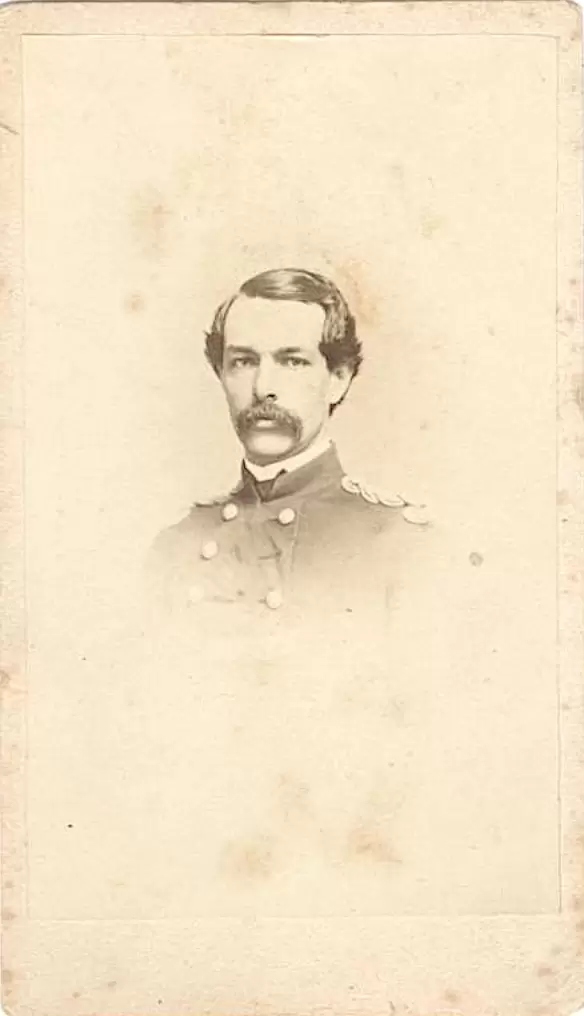
McELROY, HUGH K. (1834-1908). Private, 62nd New York Infantry, Companies D, C, and A. Born in Ireland, McElroy enlisted at New York City as a private on August 1, 1861, mustered into Company D of the 62nd New York on August 30, and was transferred into Company C the next day. On February 29, 1864, he transferred into Company A. McElroy re-enlisted on March 1, 1864, and mustered out on August 30, 1865, at Fort Schuyler, New York Harbor. He last lived at 154 Freeman Street in Brooklyn. His death was attributed to diabetes. Section 3, lot 18372.
McELROY, PATRICK (1840-1885). Private, 53rd New York Infantry, Company H. After enlisting as a private on October 10, 1861, at New York City, McElroy, a native of Ireland, immediately mustered into the 53rd New York, and deserted on October 30 at Staten Island. He last lived at 154 Freeman Street in Brooklyn. He succumbed to phthisis (tuberculosis). Section 3, lot 18372, grave 21.
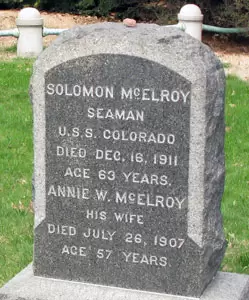
McELROY, SOLOMON (or SULLIVAN) (1847-1911). Seaman, United States Navy. Born in New York City according to multiple censuses, (although his obituary incorrectly reports that he was born in Ireland), McElroy enlisted at New York City and joined the United States Navy on September 18, 1862. He was 5′ 9″tall, weighed 190 pounds, with blue eyes, brown hair, a light complexion, and India ink tattoos of anchors on his left forearm. He served aboard the USS Colorado and was discharged on February 10, 1864, at Portsmouth, New Hampshire. His pension index records that he also served on the USS North Carolina. In 1877, he was a recipient of an invalid pension citing rheumatism, diabetes and other ailments that prevented him from working, certificate 27,711.
The 1880 census indicates that McElroy was a laborer; the 1885 Brooklyn Directory notes that he was a driver. The 1890 Veterans Schedule confirms his Civil War service aboard the Colorado. He is listed in the 1900 census as a day laborer; the 1910 census reports that he was a driver. As per his obituary in the Brooklyn Daily Eagle, he had been employed in the Department of Water Supply, Gas and Electricity for thirty years and was a member of the First Presbyterian Church. In addition, he was a member of the W. W. Stevenson Post #669 of the G.A.R. His last address was 94 Windsor Place, Brooklyn. He died of heart disease. Section 168, lot 17629.
McENROE (or Mc EUROE), WILLIAM (1840-1881). Private, 1st New York Engineers, Company M. McEnroe’s birthplace is unclear; his online family tree states that he was born in England although his muster roll records his place of birth as New York City and the 1880 census specifies Ireland. As per his muster roll, he enlisted as a private at New York City and mustered into the 1st New York Engineers that same day. A coachman, he was 5′ 4″ tall with gray eyes, brown hair and a light complexion. He mustered out with his company at Richmond, Virginia, on June 30, 1865.
As per the 1875 New York State census, he lived in the Highlands in Orange, New York, with his wife and two children. The 1880 census, which spells his surname as Mc Euroe, reports that he was married with two children and living in New York City on East 115th Street; he was then employed as a laborer. He died in Fort Hamilton, Brooklyn. His widow, Maria McEnroe, applied for and received a widow’s pension in 1888, certificate, 422,541. She confirmed his Civil war service in the 1890 Veterans Census. In 1897, Maria was listed as William’s widow and living at 541 East 150th Street in New York City. Section 2, lot 5499, grave 722.
McFALL, JOHN (1843-1906). Corporal, 4th New York Cavalry, Companies D, E, and F; 9th New York Cavalry, Company E. McFall enlisted as a private at his birthplace, New York City, on October 29, 1861, and mustered into Company D of the 4th New York Cavalry that day. As per his muster roll, he was a painter who was 5′ 7″ tall with hazel eyes, black hair and a light complexion. After his promotion to corporal on January 1, 1862, he was transferred intra-regimentally to Company E. Taken as a prisoner of war on June 2, 1862, at Strasbourg, Virginia, he was paroled on September 7 at Richmond, Virginia. He was present for roll call at Fort Delaware on September 17, 1862, transferred to Camp Parole in Annapolis, Maryland, on December 22, and returned to his company on January 5, 1863. McFall was transferred to Company F on November 30, 1864, and then transferred into Company E of the 9th New York Cavalry on February 27, 1865.
The censuses of 1870 and 1880 report that Mcfall was a sign painter. In 1895, his application for an invalid pension was approved under certificate 954,676. Suffering from heart disease, he spent time at the Soldiers’ Homes in Togus, Maine, and Bath, New York. He last resided on 6th Avenue in Manhattan. Shortly after his death, attributed to alcohlolism, in 1906, Ella McFall applied for and received a widow’s pension, certificate 623,595. Section 179, lot 13202, grave 2.
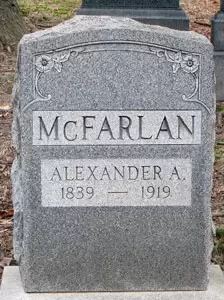
McFARLAN, ALEXANDER A. (1839-1919). Second lieutenant, 13th Regiment, New York State Militia, Company C. McFarlan, who was born in New York City, enlisted at Brooklyn on April 23, 1861, as a second lieutenant, was commissioned into his company on May 17, and mustered out on August 6 at Brooklyn. When the 13th was reactivated on May 28, 1862, he was commissioned into the same company at Brooklyn and mustered out there after three months on September 12.
The 1867 Brooklyn Directory identifies McFarlan as a clerk; the 1879 New York City Directory lists him as a merchant. According to the 1880 census, he was a commission agent living in Bayonne, New Jersey. In 1905, he applied for and received an invalid pension, certificate 1,122,130. An article in the Evening Journal (Jersey City) on December 16, 1902, noted that McFarlan, the commander of the Mansfield Post #100 of the G.A.R. in Bayonne, was scheduled to speak at the dinner celebrating the 13th anniversary of the organization. McFarlan’s speech and welcoming address would focus on the organization of the post and its special highlights over those thirteen years. The 1910 census indicates that he was retired from his job. McFarlan last lived at 435 Avenue C in Bayonne, New Jersey. After his death from arteriosclerosis His second wife, Jemima McFarlan, received a widow’s pension in 1919, certificate 882,701. Section 67, lot 4598.
McFARLAND, JOSEPH (1831-1903). Private, 12th Regiment, New York State Militia, Company F. A native of Ireland, McFarland served for three months in the 12th New York State Militia in 1861. The 1876 New York City Directory lists him in the coat business; the 1880 census reports that he was a tailor. In 1880, his application for an invalid pension was granted, certificate 248,115. McFarland’s Civil War service is confirmed by the 1890 Veterans Schedule. As per the 1892 New York City Directory and the 1900 census, he was a clothier. He last lived at 341 West 29th Street in New York City. After his death from apoplexy, Mary McFarland, who is interred with him, applied for a widow’s pension in 1903, application 786,904, but there is no certificate number. Section 161, lot 15477.
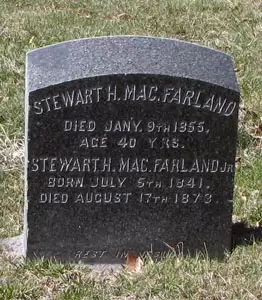
McFARLAND, STEWART H. (1841-1873). Private, 12th Regiment, New York State Militia, Company K; 71st Regiment, New York State National Guard, Company K; 84th Regiment, New York State National Guard, Company B. Born in New York State, McFarland first served with the 12th Regiment for three months in 1861. He re-enlisted on June 27, 1862, at New York City, and served as a private with the 71st National Guard until his discharge on September 2, 1862, at New York City. After he re-enlisted in 1863, he joined the 84th Regiment’s National Guard as a private for three months. His last address was in Washington, D.C., where the cause of death was attributed to insanity. In 1877, his mother, Rebecca McFarland, applied for and received a pension, certificate 255,782. Section 127, lot 8259, grave 144.
McGAHY, ALEXANDER (1844-1924). Private, 165th New York Infantry, Company A. A native of New York City, he enlisted there on November 14, 1862, as a private. He mustered into the 165th New York on November 28 and mustered out on September 21, 1863, at New York City. The 1870 and 1880 censuses report that he was an engineer. McGahy’s Civil War service is confirmed by the Veterans Schedule of 1890. In 1892, he applied for an invalid pension that was granted, certificate 1,184,476. The 1894 New York City Directory indicates that he was an engineer; the 1900 census identifies him as an electrician.
From 1910 through 1918, McGahy lived at the Soldiers’ Home in Bath, New York, suffering from rheumatism. At the time of his first admission, he was 5′ 9″ tall with grey eyes, grey hair and a light complexion who noted that he was a widower who could read and write. His obituary in The New York Times confirms his Civil War service with the 165th, also known as the Second Duryée Zouaves. His last residence was 584 Academy Street in Manhattan. Section 127, lot 16311, grave 8.
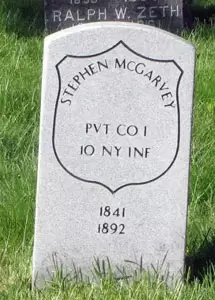
McGARVEY, STEPHEN (1842-1892). Private, 10th New York Infantry, Company I. Of Irish birth, McGarvey was a painter’s apprentice as per the 1860 census. During the Civil War, he enlisted at New York City on October 17, 1861, and mustered into the 10th New York on the same date. He was wounded at the Battle of Second Bull Run, Virginia, on August 30, 1862, and mustered out on May 7, 1863. A letter from the War Department on October 11, 1864, officially removed the charge of desertion on December 1, 1862, from McGarvey’s record and noted the official discharge date of May 7, 1863.
The 1880 census and the 1888 New York City Directory report that McGarvey was a painter. In 1888, his application for an invalid pension was granted, certificate 355,804. He last lived in Manhattan. An article in the New York Tribune on May 30, 1892, “How The Memories Of Heroes Will Be Honored,” notes the death of McGarvey, due to Bright’s disease, and his membership in the James C. Cameron Post #70 of the G.A.R. Elizabeth McGarvey, who is interred with him, applied for and received a widow’s pension in 1892, certificate 380,000. The federal government provided a headstone for McGarvey early in the 20th century. Section 15, lot 17263, grave 724.
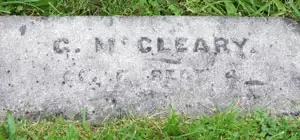
McGLEAR (or McGLEARY, McGLARE, McGLARY), GEORGE (1839-1863). Sergeant, 73rd New York Infantry, Company F. McGlear is not buried at Green-Wood; the cenotaph in his family’s lot honors his memory. After enlisting as a private on March 20, 1862, McGlear mustered immediately into the 73rd New York and was promoted to sergeant on June 1, 1863. He was killed at the Battle of Gettysburg, Pennsylvania, on July 2, 1863, and was buried at Gettysburg National Cemetery, Section F- lot 103, New York State Plot. The stone at Gettysburg, inscribed G. McGleary, indicates his regiment. The cenotaph honoring him at Green-Wood has the following dedication, “To the Memory of George McGlear, Killed at the Battle of Gettysburg, July 2, 1863, in the 24th Year of his Age.” Eliza McGlear, his mother, received a survivor’s pension, certificate 118,015, on July 30, 1868. Section 64, lot 4713, grave 64.
McGOWAN, GEORGE N. (?-1863). Acting third assistant engineer, United States Navy. McGowan was appointed acting third assistant engineer on September 1, 1863. He drowned on December 6, 1863, when the USS Weehawken was lost at sea. The vessel, an iron-clad monitor, was commissioned at Jersey City, New Jersey, in mid-January 1863. Originally at Fort Sumter, South Carolina, on April 7, 1863, the Weehawken was struck by over 50 enemy cannon balls. After repairs, she was in the waters off Georgia and on June 17, 1863, captured the CSS Atlanta as well as two Confederate officers who would one day be interred at Green-Wood: Major Reid Sanders (see) and Second Assistant Engineer Leslie King (see). Returning to Charleston, South Carolina, the Weehawken assisted in the bombardments of Forts Wagner and Sumter. After being grounded on September 7, she was repaired and became part of the blockade off Charleston that October. The Weehawken, whose officers and crew were mostly from Brooklyn, suddenly sunk in a gale while at anchor off Charleston on December 6. Four engineers who couldn’t escape the flood and 27 other crewmen perished. The Brooklyn Daily Eagle reported on this tragedy on December 12:
…That poor Monitor fleet, which went forth with colors flying, carrying the hopes of the nation with it, has met disaster at every turn, encountered obstacles and sustained repulse, been battered and bruised, and finally settled down at anchorage not far from Morris Island. Even here it has been pursued, and the winds of Heaven with the waves of the ocean have destroyed and pushed down from sight, one of its best and strongest, and most vaunted components.
There was much speculation as to the cause of the Weehawken’s sinking. One admiral attributed it to damage suffered while aground under fire of the Sullivan Island batteries that strained the rivets on its bottom plates. John Ericcson, who pioneered ironclad construction, attributed the sinking to water entering the anchor hoister hatch after it had been accidentally left open by a crew member. Ultimately, the inquiry concluded that a heavy load of ammunition, open hatches and a failure to level the ship after it had taken on water caused the sinking. Although crews attempted to bring up the Weehawken as early as December 1863, it took eight years before the ship and her crew members who perished there were brought back up.
The remains of the men were then recovered and given proper burial. The funeral ceremony was detailed in an article in The New York Times on September 27, 1871. As per that account, the pageant began at the Brooklyn Navy Yard when a small box, containing the bones of the four deceased men, was deposited into a beautiful rosewood casket decorated with silver. A large silver plate which was placed upon the casket read, “This coffin contains the remains of four officers of the United States Navy, attached to the Weehawken, which foundered off Charleston, S.C., Dec. 6, 1863: H. W. MERIDEN (sic), Third Assistant Engineer; AUGUSTUS MITCHELL, Third Assistant Engineer; GEORGE W. MCGOWAN, Acting Third Assistant Engineer; and CHARLES SPONBERG, Acting Third Assistant Engineer.” The funeral procession began at noon with a detachment from the Vermont playing Auld Lang Syne. The cortege was led by the Band, followed by a detachment of Marines, sailors from the Man-of-War, the casket flanked by pall-bearers, a delegation from the Freemasons, and friends and relatives. The detachment of marines fired the customary funeral volleys at the gravesite. The Times noted that rain fell during the cortege and graveside ceremony adding a note of solemnity to the occasion.
Henry Merian (see), Augustus Mitchell (see), George N. McGowan and Charles Sponberg (see) are remembered in a monument at Green-Wood erected in 1871 and dedicated to their valiant efforts. The monument has a carving on its front that states it was erected by Frances Mitchell, who purchased the lot and is likely the mother of Augustus Mitchell and J. J. Merian, likely the father of Henry Merian. On one side the inscription reads: “SACRED TO THE MEMORY OF FOUR OFFICERS OF THE U.S. NAVY WHO LOST THEIR LIVES BY BEING DROWNED ON THE U.S. MONITOR WEEHAWKEN TO WHICH THEY WERE ATTACHED WHEN SHE FOUNDERED OFF CHARLESTON, S. C. DECEMBER 6, 1863.” The opposite side of the monument is inscribed: , “THE REMAINS WERE EXHUMED FROM THE ENGINE ROOM OF THE WRECKED MONITOR WHERE THEY NOBLY FELL AT THEIR POST OF DUTY. SEPTEMBER 26, 1871. Section 82, lot 20207.
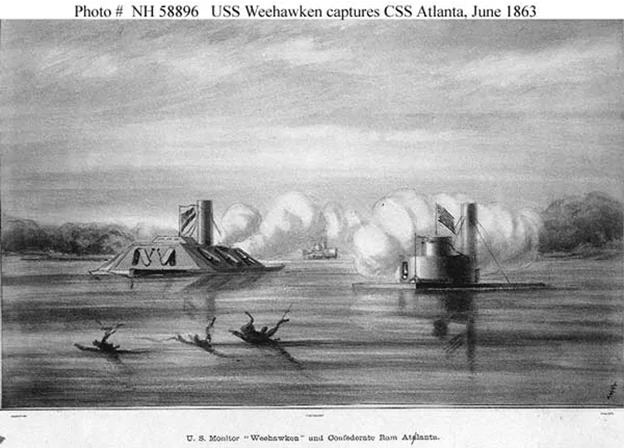
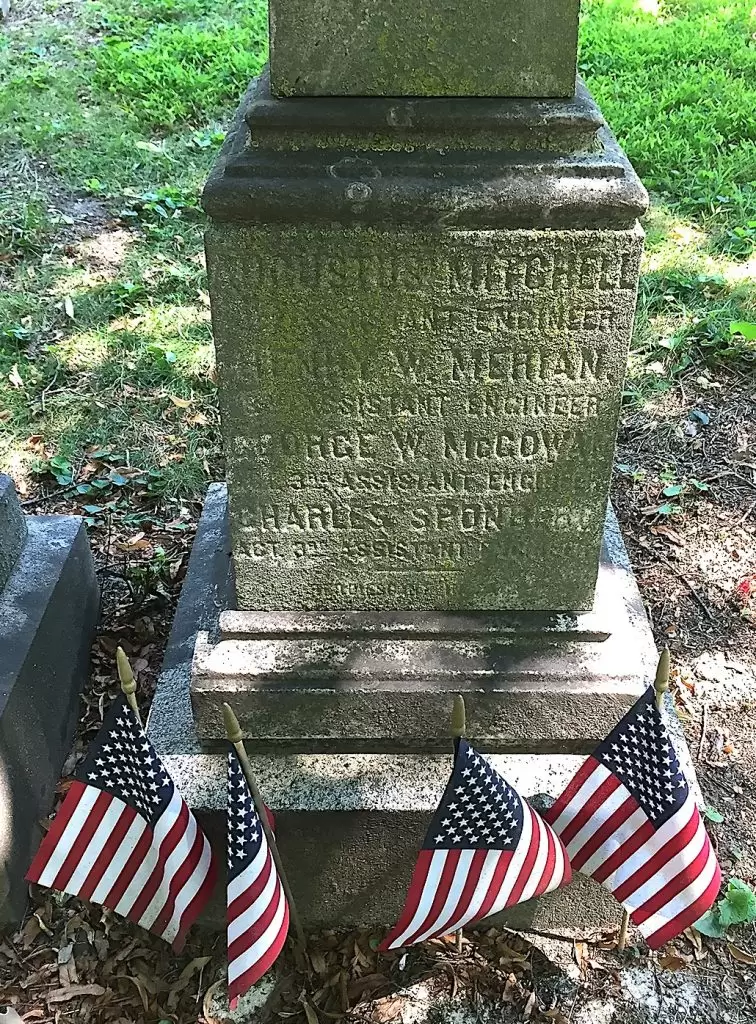

Monitor carved into the memorial.
McGRATH, THOMAS H. (1840-1922). Corporal, 13th Regiment, New York State National Guard, Company E. McGrath was born in New York City. After enlisting as a corporal at Brooklyn, McGrath mustered immediately into the 13th Regiment (Heavy Artillery) on May 28, 1862, and mustered out after three months on September 12 at Brooklyn. The 1880 census identifies him as a general manager of a railroad. The Veterans Schedule of 1890 confirms his Civil War service. According to the Brooklyn Directory of 1890, he was an assistant inspector; the 1895 Brooklyn City Directory states that he was an inspector.
McGrath remained active in military affairs and rose to the highest ranks in the New York State National Guard. The Monticello NY Republican Watchman (1893-1895) stated that he was the first major general to have passed through every grade from private to major general. The Cortland Evening Standard reported on April 4, 1893, that McGrath inspected the 45th Separate Company that day checking for equipment, uniform efficiency in drill, military appearance and condition of the company and their armory. That article goes on to say that McGrath was headed to Elmira, New York, to inspect the 30th and 26th Separate Companies and would then travel to Binghamton to inspect the 20th Separate Company and the 6th Battery.
The 1900 and 1910 censuses and the 1904 Brooklyn Directory report that McGrath was a stock broker. An article in the Sun on April 22, 1903, states that McGrath, the chairman of the Consolidated Exchange Committee of Arrangements, sent a floral tribute consisting of 300 American Beauty roses in an eight foot high basket to the Produce Exchange when they opened their new headquarters in honor of being invited to the opening ceremonies. In 1908, he applied for and received a pension, certificate 1,145,093. As per his obituary in the Brooklyn Daily Eagle, he was a general with the 13th Regiment Veteran Association; members were invited to attend his funeral. McGrath’s obituary in the Troy (New York) Times, which confirms his Civil War service, reports that had been an adjutant general and former major general of the New York National Guard. He last lived at 226 Jefferson Avenue in Brooklyn. His death was attributed to heart disease. In 1922, Maria McGrath, who is interred with him, applied for and received a widow’s pension, certificate 924,164. Section 43, lot 267.
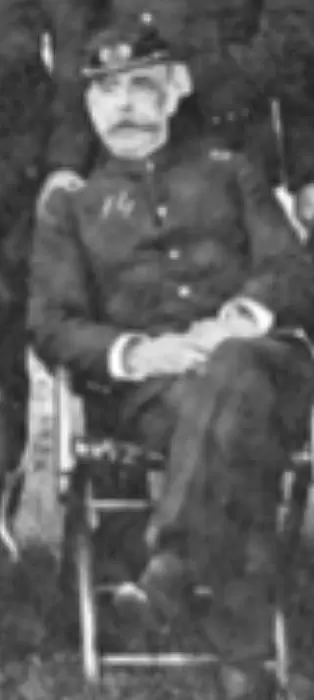
McGRATH, WILLIAM J. A. (1836-1886). Adjutant, 22nd Regiment, New York State National Guard, Company C. After enlisting at New York City as a second lieutenant on May 28, 1862, he was commissioned into Company C of the 22nd Regiment that same day. The carte de visite image (below) from the magazine, Military Images, shows McGrath on Bolivar Heights at Harpers Ferry, Virginia, in mid-1862. McGrath was promoted to adjutant on July 17, and mustered out at New York City on September 5. When his unit was reactivated on June 18, 1863, McGrath was commissioned into the 22nd Regiment’s Field and Staff, served in Pennsylvania, and mustered out after 30 days on July 24 at New York City. McGrath’s pension index record notes that he was a lieutenant colonel in the 22nd Regiment and his obituary refers to him as Major McGrath; it is unknown when he achieved those ranks.
The 1868 and 1872 New York City Directories identify McGrath as a clerk; he is listed as a court clerk in the 1870 census. As per the 1880 census and the 1883 New York City Directory, he was a lawyer. In 1886, he applied for an invalid pension, application 590,713, but he died before it was certified. An article about his funeral in the New York Herald on December 19, 1886, noted that he was a member of the Veteran Association of the 22nd Regiment. The Herald also stated that his services were largely attended by veterans of his and other regiments and that he was a well-known and popular officer. His last address was 20 East 126th Street in Manhattan. His death was caused by Bright’s disease. In 1891, Henrietta McGrath, who is interred with him, applied for and received a widow’s pension, certificate 380,020. Section 105, lot 5871.

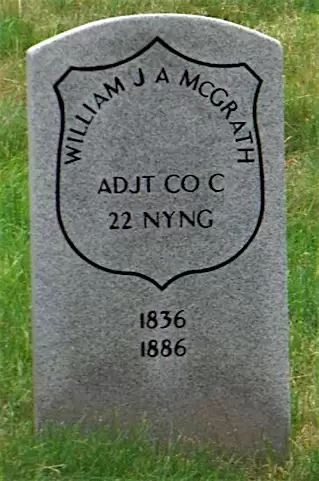
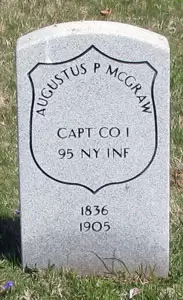
McGRAW, AUGUSTUS P. (1836-1905). Captain, 95th New York Infantry, Company I. Of Irish birth, he was a bookkeeper living in Westchester, New York, as per the 1860 census. During the Civil War, McGraw enlisted at New York City on December 19, 1861, mustered into the 95th New York as a first lieutenant and quartermaster on December 26, and was promoted to captain of his company on March 8, 1862. As per his muster roll, he was 5′ 8″ tall with brown eyes, brown hair and a light complexion. On November 24, 1862, he was listed as “dismissed for being absent without leave.” However, this was an error; he had been honorably discharged on August 31, 1862.
On November 26, 1862, McGraw wrote a letter to the editor that was published in the New York Evening Express and headlined as “Another Case of Wrongdoing.” In his letter, McGraw states that he noticed his name among those dismissed without leave but that in fact, he “was honorably discharged upon surgeon’s certificate, after having been sick in Washington for upwards of two months” and that he was at a loss to understand how it had been reported he was “dismissed.” Further, McGraw stated that he has four medical certificates showing that he is unfit for duty and that the official discharge was two and a half months prior to the dismissal notice. One soldier record states that he mustered out on July 16, 1865, at Washington, D.C., but his pension record only lists his service until August 1862.
The 1870 census reports that McGraw was a manufacturer living in Norwich, Connecticut, whose real estate was valued at $25,000 and whose personal estate was $5,000. The 1889 and 1894 New York City Directories state that he resided in East Orange, New Jersey, and was working as an agent. In 1904, his application for an invalid pension was approved, certificate 1,101,410. The 1904 Orange City Directory identifies him as an “elect.” McGraw was a Freemason. His last residence was the Masonic Home in Burlington, New Jersey, where he died from accidental poisoning by hydrochloric acid. Section 162, lot 15346, grave 20.
McINDOE, PETER W. (1844-1909). Private, 40th New York Infantry, Company E; yeoman, United States Navy. A native of New York City, he enlisted and mustered into the 40th at Yonkers, New York, on June 14, 1861, and deserted the next month on July 27. However, the notation of desertion is an error; McIndoe, using the alias Peter Campbell, was a yeoman in the United States Navy. The dates of his service are unknown. Among the ships that he served aboard were the USS Wabash, USS Princeton, USS North Carolina, USS Powhatan, USS Constellation, USS New Ironsides, USS Vermont, USS Clyde, and USS New Hampshire.
According to the 1870 census, McIndoe was a bookbinder. He was a director of the Caxton Press, a company that dissolved in November 1899, according to an announcement in the Morning Telegraph. McIndoe’s passport application of 1900 notes that he was 5′ 10″ tall with blue eyes, short small nose, double chin, light gray hair, fair complexion, and full face. The 1900 census indicates that he was a bookbinder. McIndoe applied for and received a pension from the Navy under certificate 38,897. His obituary in The New York Times reports that he was a member of the General Society of Mechanics and Tradesmen of the City of New York for twenty-two years. In addition, he was the vice president of the Provident Penny Club. He last resided at 21 West 76th Street in Manhattan. His wife, Elizabeth McIndoe, applied for and received a widow’s pension, certificate 20,735. Section 186, lot 19825, grave 12.
McINTIRE, WILLIAM H. (1836-1915). Second lieutenant, 8th Regiment, New York State National Guard, Company F. Of Irish origin, he immigrated to the United States in 1849. During the Civil War, McIntire enlisted as a private in 1862 and served with Company F of the 8th Regiment for three months. In 1863, he returned to the same regiment and company for 30 days as a second lieutenant. An article in the New York Herald on April 29, 1896, reports that he was chairman of the Tammany Hall General Committee of the Eleventh Assembly District. The 1910 census reports that he was a court clerk. In 1911, his pension application was granted, certificate 1,166,031. His last address was 201 West 95th Street, Manhattan. His death was attributed to arteriosclerosis. Section 20, lot 27952, grave 1.
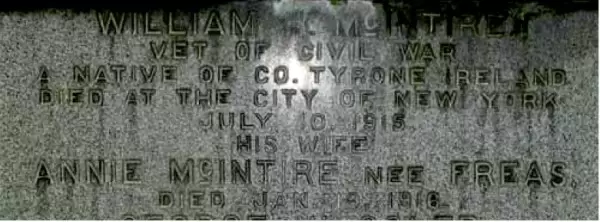
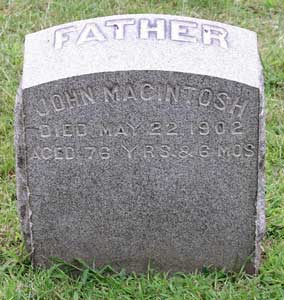
McINTOSH (or MACINTOSH), JOHN (1831-1902). Private, 47th New York Infantry, Company A. Born in Scotland, McIntosh enlisted on October 12, 1863, at New York City, mustered into the 47th New York Infantry the same day, and was discharged on May 16, 1865, at Wilmington, North Carolina. His muster roll notes that he was a substitute for a drafted man. The 1880 and 1900 censuses report that he was a boiler maker. His last residence was on Manhattan Avenue in Brooklyn. He succumbed to heart disease. Section 117, lot 10975, grave 1249.
McINTYRE, EDWARD (1849-1912). Drummer boy, 13th Regiment, New York State Militia, Company G; 87th New York Infantry, Company H. Born in Manhattan, McIntyre was only eleven years old when he enlisted as a drummer boy in the 13th Regiment’s Company G—the same regiment in which Clarence McKenzie (see) served as a drummer boy. He participated with the 13th in the parade that greeted the Prince of Wales when the prince visited New York City and marched with the 13th Regiment when they went off to the Civil War in 1861; McIntyre was but twelve at that time.
As per his obituary in the Brooklyn Daily Eagle, which confirms his Civil War service, McIntyre then re-enlisted as a drummer at Brooklyn on October 5, 1861, mustered immediately into the 87th New York Infantry with his father, who was a captain, and was assigned to the Third Army Corps. Upon his discharge from the 87th New York on September 6, 1862, he returned to the 13th Regiment and once more, served on the front lines for its tour of duty. Subsequently, he joined his father, now in the Treasury service, and was charged with the collection of all property abandoned by the Confederates, and returning the money to the Federal government.
McIntyre remained a member of the New York State National Guard for nearly fifty years and reached the rank of major. An employee of the Brooklyn Post Office for 34 years, he was the head of the Money Order Department there from 1905 through 1911 when ill health forced him to retire. His obituary notes that he belonged to many civic, military and social organizations. McIntyre last lived at 190 Argyle Road in Brooklyn. He died from heart disease that confined him to his house for the last nine weeks of his life. Section 107, lot 685.
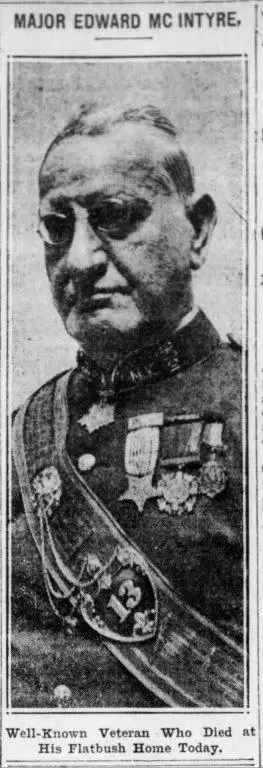
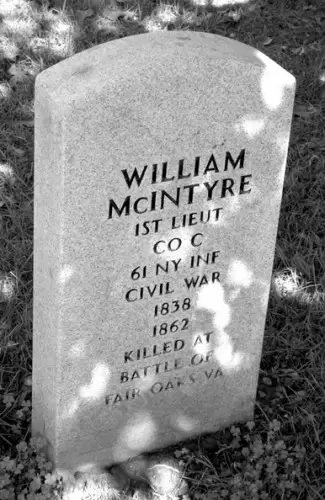
McINTYRE, WILLIAM (1838-1862). First lieutenant, 61st New York Infantry, Company C. McIntyre was born in Ireland. After enlisting as a first lieutenant at Hamilton, New York, on August 15, 1861, he was commissioned into the 61st on September 19. His muster roll notes that he was a student who was 5′ 10″ tall with blue eyes, brown hair and a light complexion. On June 1, 1862, he was killed in battle at Fair Oaks, Virginia, the actions there described by Colonel Frances Barlow of the 61st in his report of June 2. While noting that McIntire and other officers were “…shot dead while doing their duty firmly, calmly, and nobly,” he stated that while most of the troops obeyed commands under heavy fire, there were a few men who “at times would crouch down during firing and shirk to the rear, but were brought up again by their officers, and were few in number.” As per his obituary in The New York Times, a large number of his friends escorted his body to Green-Wood Cemetery where he was interred on June 24, 1862. Section 69, lot 3637.
McKAIN, ALEXANDER (1828-1870). Corporal, 88th New York Infantry, Companies K and B. Born in New York City, McKain enlisted there as a private on October 21, 1861, and mustered into Company K of the 88th New York the next day. On March 1, 1862, he was promoted to corporal of his company and transferred into Company B on June 12, 1863. McKain re-enlisted on February 24, 1864. On June 24, 1864, he was taken prisoner of war at an unknown place (most likely Petersburg, Virginia) and was paroled on December 16, 1864. He mustered out on June 30, 1865, at Alexandria, Virginia. His death on Blackwell’s Island, New York, was attributed to delirium. Section 127, lot 17931, grave 230.
McKANE (or McKEANE), WILLIAM (1815-1865). Private, 90th New York Infantry, Company G. Of Irish birth, he enlisted and mustered into the 90th New York on September 24, 1862, at New York City, and was discharged for disability on June 16, 1864, at New Orleans, Louisiana. He succumbed to phthisis (tuberculosis) at Long Island College Hospital in Brooklyn on April 26, 1865. Section 115, lot 13536 (Soldiers’ Lot), grave 103.
McKAY (or MACKEY), CORNELIUS WITWORTH (1834-1899). Private, 173rd New York Infantry, Company E. A native of New York, he enlisted as a private on September 18, 1862, at Brooklyn, and on October 10, 1862, mustered into the 173rd New York Infantry. He was discharged for disability at Baton Rouge, Louisiana, on March 9, 1863. His last residence was on East 126th Street in Manhattan. His death was attributed to nephritis. Section 162, lot 14941, grave 1.
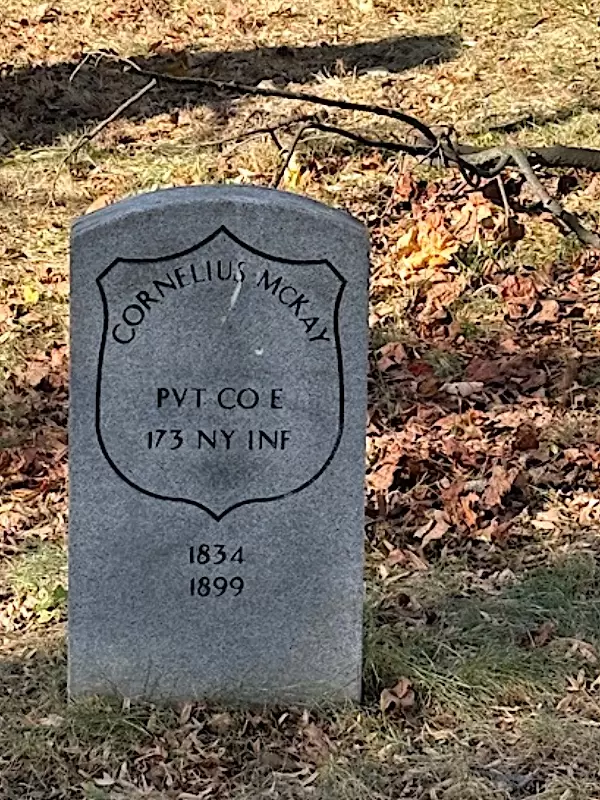
McKEE, THOMAS (1833-1870). Private, 5th New York Heavy Artillery, Company A. Of Irish origin, McKee enlisted on August 30, 1862, at Brooklyn, as a private. On that date, he mustered into Company A of the 5th New York Heavy Artillery. His muster roll indicates that he was borne on the rolls as Thomas G. McKee. A moulder by trade, he was 5′ 5¾” tall with gray eyes, light hair and a fair complexion. After he was taken as a prisoner of war at Harpers Ferry, Virginia, on September 15, 1862, he was paroled there the same day, and deserted at Baltimore, Maryland, nine days later. His last residence was at 650 East 9th Street in Manhattan. He died of consumption. Section 3, lot 7777.
McKEE, THOMAS J. (1840-1899). Private, 48th New York Infantry, Company G. McKee enlisted as a private at Brooklyn on August 24, 1861, and mustered into the 48th New York two days later. His muster roll indicates that he was wounded in action at the Battle of Cold Harbor, Virginia, on June 1, 1864; the 1890 Veterans Census confirms his Civil War service and indicates that he was wounded in the left thigh. He was discharged at the expiration of his service (no date given).
The 1870 census and the 1878, 1880, and 1889 New York City Directories report that McKee was a lawyer. In addition, he was a bibliophile who amassed a large collection of rare books, many of which focused on drama and English and American poetry. He owned rare works of Percy Bysshe Shelley and Edgar Allan Poe, early American Bibles, and first editions of such famous Americana as Washington Irving’s “Knickerbocker’s New York.” English plays from Shakespeare, Marlowe, and Dryden were among the 520 works in his collection in addition to rare English literature including Spenser’s “Faerie Queen,” Shakespeare’s “Folios,” and Chaucer’s “Works.” Charles Dickens’s personal copy of “David Copperfield” was also in his collection. A member of the G.A.R., he last lived at 237 West 34th Street in New York City. His death was caused by epilepsy.
On June 23, 1900, an article in The New York Times reported on the sale of his library by John Anderson, Jr., a noted auctioneer, and reveled in the extent of his book collection. The New York Herald reported in 1905 that McKee’s daguerreotype of Poe, presumably taken in about 1842 before Poe sported a moustache, was sold at auction to an unnamed buyer for $21. McKee’s copy of Poe’s rare manuscript of “Ulalume,” which was purchased at the 1905 auction, is now at the J. P. Morgan Library in New York City. Section 31, lot 4397, grave 31.
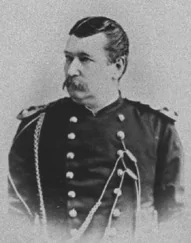
McKEEVER, CHAUNCEY (1828-1901). Brigadier general by brevet; lieutenant colonel, Union Army. Born in Baltimore, Maryland, his father was a commodore in the United States Navy. McKeever graduated from the United States Military Academy in 1849, and was assigned to the artillery. He served in the Seminole War, was an assistant professor of mathematics at West Point from 1851-1855, fought western Indians, and went on the Utah Expedition.
McKeever was appointed captain at the outset of the Civil War, and was instructor of artillery at Washington, D.C., under Major W. T. Sherman’s command from May 28, 1861, through June 12, 1861. He then served on the staffs of Generals Heintzelman, McDowell, and Fremont as captain and assistant adjutant general. During the Peninsula campaign he was Chief of Staff for the III Corps, and fought in Virginia at Yorktown, Williamsburg, Malvern Hill, and Second Bull Run. He was promoted to lieutenant colonel in 1862, served on special duty in the War Department from November 24, 1862, through March 18, 1863, then served in the Provost Marshal’s General Bureau in Washington, D.C., in charge of disbursing for recruiting and organizing volunteers until August 1, 1866. On March 13, 1865, McKeever was brevetted brigadier general for “diligent, faithful, and meritorious services in the adjutant-general’s department.”
After the Civil War, McKeever worked as an adjutant general in many parts of the United States including the Department of the Missouri, the Department of Texas, the Department of the East, and the Department of the South. He retired in 1893 with the rank of colonel after a career spanning forty-four years with the Army. McKeever died in Bad Reichenhall, Bavaria from peritonitis. Section 119, lot 10274, grave 6.
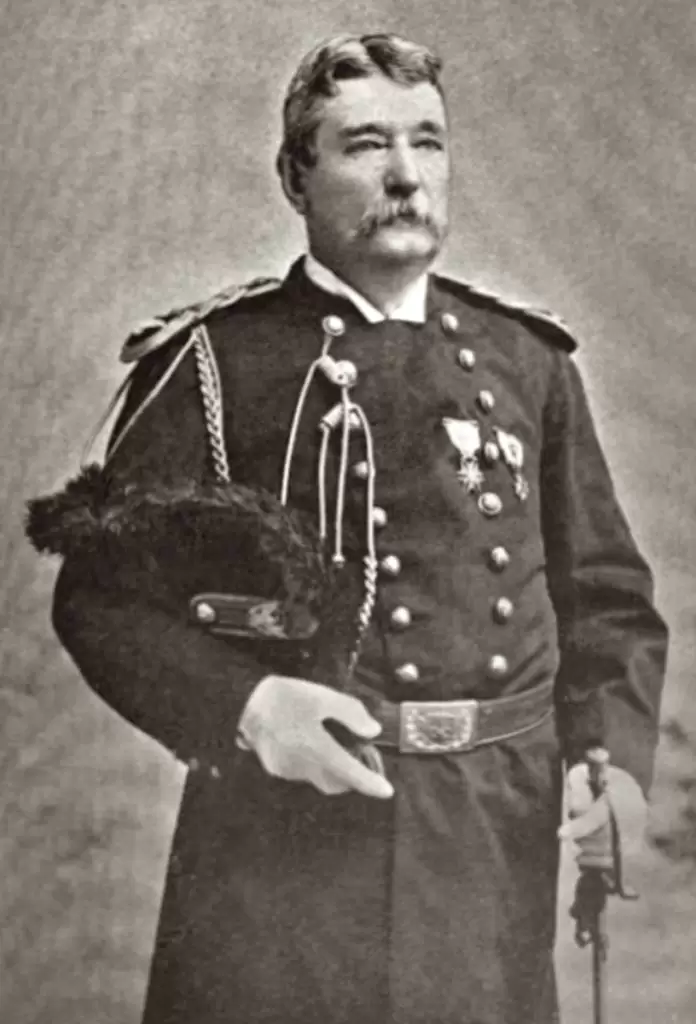
McKEEVER (or McKEIVER), WASHINGTON (1843-1866). Principal musician, 146th New York Infantry, Company K; private, 5th New York Infantry, Company D. A New Yorker by birth, McKeever was a ship joiner, an artisan who constructs the woodwork of a ship, according to the 1860 census. During the Civil War, he enlisted as a private on October 24, 1861, at Baltimore, Maryland, mustered into the 5th New York four days later, and transferred into Company K of the 146th New York as a musician on May 4, 1863. Upon his promotion to principal musician on October 9, 1863, he was transferred into the Field and Staff of the regiment but returned to Company K on April 21, 1864, six months prior to his discharge on October 18, 1864, at Weldon Railroad, Virginia.
McKeever last lived in Hudson City, New Jersey, where his death was listed as a casualty. According to an article in The New York Times and his obituary in the New York Herald on December 28, 1866, he died from an accident on the Erie Railroad where he worked as a brakeman. McKeever was fatally injured when he lost his footing while arranging the signal ropes atop the cars and fell between two cars onto the track. One of his legs was broken below the knee and his body was badly lacerated; he died soon after his body was carried to the train. His obituary in the Herald notes that he was a Freemason and that members of the Fifth Regiment were invited to attend his funeral. Section B, lot 9895, grave 121.
McKEEVER, WILLIAM H. (1832-1869). Private, 51st New York Infantry, Company G. Born in New York State according to Green-Wood records, although his muster roll says Ireland, McKeever enlisted as a private on August 21, 1862, at New York City, and mustered into the 51st New York eight days later. The muster roll notes that he was a machinist who was 5′ 5″ tall with blue eyes, brown hair and a florid complexion. He was detached as a provost guard at Nicholasville, Kentucky, from September through December 1863. On May 6, 1864, he was wounded in the head, neck and arm at the Battle of the Wilderness, Virginia. He mustered out of service on June 6, 1865, at Alexandria, Virginia. The 1868 New York City Directory identifies him as an engineer. As per his obituary in the New York Herald, he was a Freemason and member of the Independent Order of Odd Fellows; comrades from both organizations were invited to attend his funeral. His last address was 325 East 35th Street in Manhattan. He died of pneumonia. Section 86, lot 1596, grave 330.
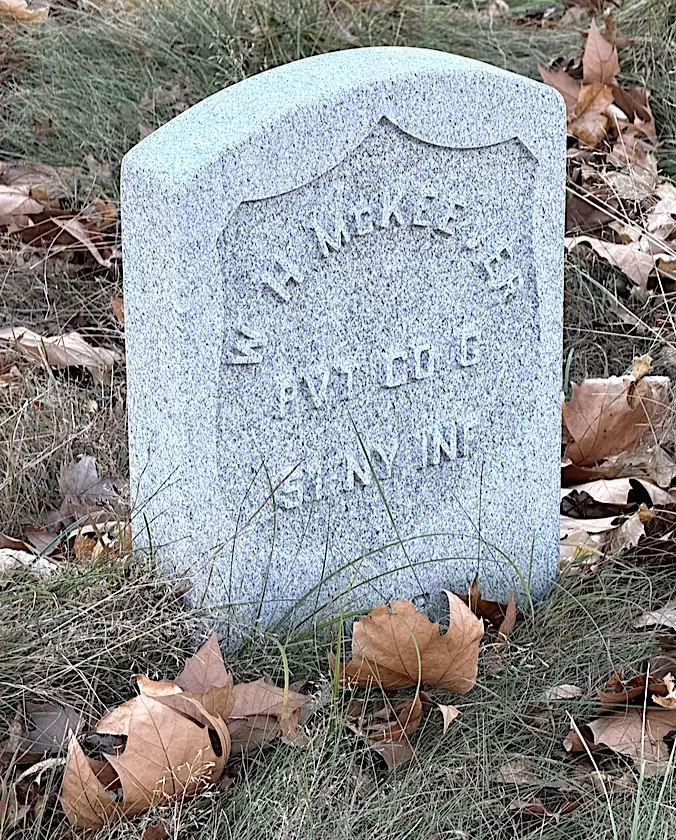
McKELVEY (or McKILVEY, McELVEY), WILLIAM J. (1842-1900). Private, 10th New York Infantry, Company E. McKelvey was born in Providence, Rhode Island; cemetery records incorrectly note that he was born in Connecticut. During the Civil War, he enlisted as a private on May 2, 1861, and mustered into Company E of the 10th New York, also known as McChesney’s Zouaves, on June 26. His soldier records show his last name spelled as McKilvey and McElvey. As per his biography in the G.A.R. Grant Post #327 book of members, he fought in many major battles of the Civil War in Virginia including Big Bethel, the Seven Days Fight, Gaines’ Mills, Savage Station, Charles City, Malvern Hill (where he was taken prisoner but escaped the same night) and Chancellorsville. He also fought at Antietam, Maryland. That same biography reports that he was promoted to sergeant after Chancellorsville but he took sick with typhoid fever, was removed to an Army hospital and discharged after his recovery, never serving in that rank. However, his soldier records do not confirm that promotion. He was discharged on April 30, 1863, at Philadelphia, Pennsylvania. After recovering, he began recruiting a company in New York City but then turned his attention to the Police Department in July 1863.
McKelvey joined the New York City Police Department and took an active role when the police were called upon to suppress the Draft Riots in July 1863. He was appointed captain of Brooklyn Police, Fourth Precinct, on January 10, 1885, and became captain of drill of the Brooklyn Police in 1887. He enlisted in the National Guard of New York State, Company K, as a first lieutenant, served for eight years, and in 1885 served as part of President Grant’s Honor Guard at Riverside, New York, as a member of the his G.A.R. Post.
He was a member of the Ulysses S. Grant Post #327 of the G.A.R. and served as its officer of the day. In addition, his death notices in the Brooklyn Daily Eagle note his membership in numerous organizations of the Freemasons, Brooklyn Masonic Veterans’ Association, Knights Templar, Police Veterans of which he was vice president, Invincible Club, New York Police Veterans and the Royal Arcanum. He last lived at 431 Monroe Street in Brooklyn. McKelvey died from a hemorrhage on September 11, 1900, in Sharon Springs, New York.
His funeral took place at the Masonic Cathedral at the corner of Bedford Avenue and Madison Street in Brooklyn. As per death notices in the Brooklyn Daily Eagle, the members of the Masonic Lodge, Clinton Commandery of the Knights Templar and Brooklyn Masonic Veterans were requested to assemble to attend the funeral of their “venerable brother.” Members of U. S. Grant Post #327 were requested to assemble at headquarters in uniform with white gloves; officers were asked to carry side arms. Previous post commanders were assigned as pallbearers. His remains were first interred in lot 3891 (for a burial fee of $35.00) before they were placed in their current location on May 28, 1903. Section 205, lot 31296, graves 1 and 2.
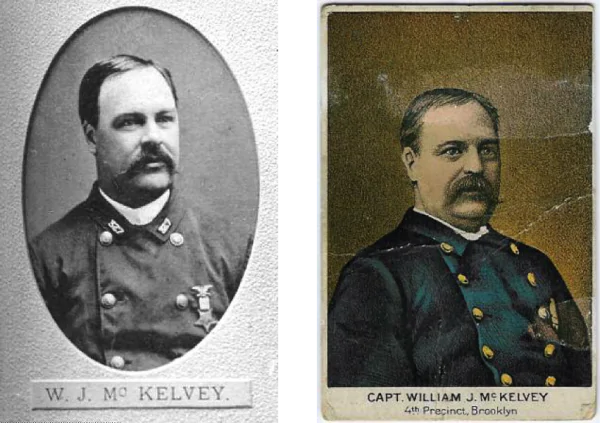
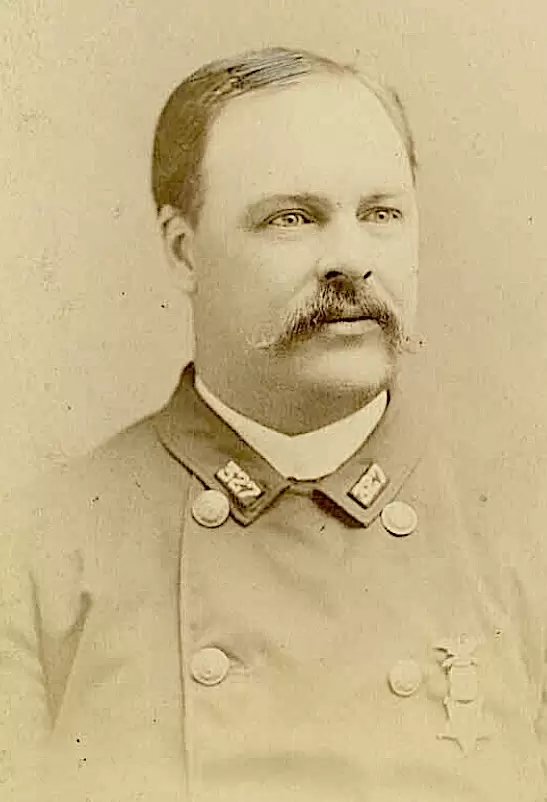
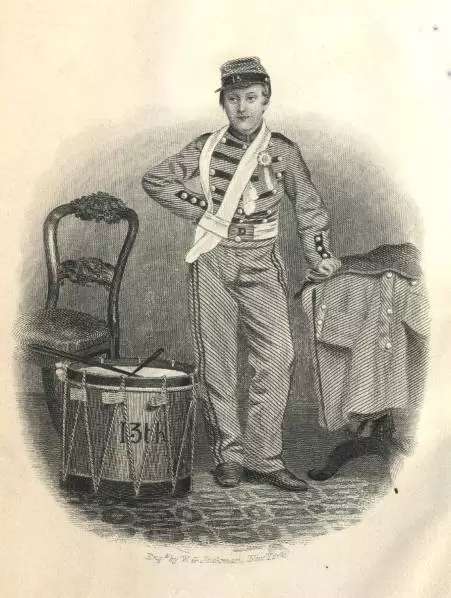
McKENZIE (or MACKENZIE), CLARENCE (1848-1861). Drummer boy, 13th Regiment, New York State Militia. Born in Brooklyn, he enlisted in the drum corps of the 13th Regiment in July 1860, and took part in his first parade in October 1860 when New York City hosted the Prince of Wales. On April 22, 1861, he marched off with the 13th, one of the first Brooklyn units. His mother objected to his decision and was convinced that if he went to the front, she would never see him again. He wrote this letter to his parents from Annapolis, Maryland, on May 10, 1861:
My Dear Father and Mother,
I was very glad to find on the morning of the 9th a letter from you, which you know is so welcome, and will be always so received from you, telling me all the folks are well. You say brother William is coming, but you do not say when. I am expecting him every day. The minister of the chapel gave me a little book and told me to learn what it teaches….We have the Eighth Regiment Band, which makes it very pleasant, just as I am writing they are playing outside of Colonel Smith’s quarters. I have plenty of fun all the time, sauntering around or reading my little book which I like very much. Last night I went to a prayer meeting, and I prayed for all of you. I say my prayers every night and morning as you told me. Did you get the dollar I sent you? Give my love to Elisha Hendshaw and to Major Baltson, and to all the friends that ask for me. Please write me again. I will write – when Willie gets here. Please to send me my book and pencil. Receive my love, and believe me to be your dear son. Good-bye.
In another letter sent on May 28, 1861, (after his brother Willie’s visit) Clarence wrote to his parents:
Dear Mother and father,
Dear mother, do not cry for me, for I am well off, and I hope to return to you in three months or sooner. There has not been much here. I do not think we will have to go to Washington, but we will be in the Navy Yard until further orders.
The men and the boys are kind to me, and I sleep with Captain Balsdon. So you see I am well provided for. It is very hot out here. I go around in my shirt sleeves almost all the time. It is a very nice place out here, and I like it first rate, but it is not like being at home with you. But it will not be before long before I shall come. I hope to find that you have not worried for me. If you write me a letter tell me how you all are, and direct to me.
He was fatally wounded on June 11, 1861, in Annapolis, Maryland, by a bullet fired by a drilling comrade, becoming at age 12, the first casualty of the War from Brooklyn. In a letter written on June 12, describing when Clarence’s coffin was sent back to Brooklyn, it was noted:
…As the coffin was taken from the drummer’s quarters, preceded by the balance of the drum corps and a fifer playing the slow and solemn tune of the dead march, the other companies of the regiment fell into line and followed it to the cars. The music was beautiful, yet sad, and many a man, who would not flinch on the field of battle, shed tears over the remains of poor Clarence. He was the smallest in the corps and liked by every one who knew him, being well-behaved, always in good spirits and ready and willing to do whatever was asked of him; his comrade drummers and the drum-major were very much affected; they could not have felt worse had he been their own brother….
Originally interred on June 14, 1861, in lot 9895, grave 521, Mckenzie’s remains were moved to their present location on August 2, 1862. After the Civil War, G.A.R. Post #399 was named in his honor. His zinc monument, by the Monumental Bronze Company of Bridgeport, Connecticut, was unveiled in November 1886 by John B. Woodward (see) and Brooklyn Postmaster Joseph Clifford Hendrix. It cost almost $600, money raised by the 13th Drum and Bugle Corps. On its front it reads, “Our Drummer Boy” and on the back, “His was the first offering from Kings County in the War of the Rebellion.” Section 115, lot 13536 (Soldiers’ Lot), grave 46.
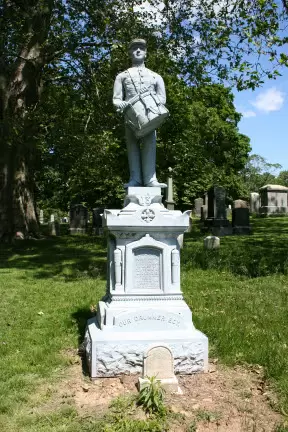
McKENZIE, JAMES (1833-1915). First lieutenant, 11th New York Cavalry, Companies C, M, and D. Of Scottish birth, McKenzie enlisted at Staten Island on January 22, 1862, as a sergeant, and mustered into Company C of the 11th New York Cavalry on that date. He was promoted to first sergeant on July 6, 1862, to second lieutenant effective upon his transfer to Company M on March 1, 1863, and was subsequently transferred to Company D on February 25, 1864. On June 17, 1864, he was promoted to first lieutenant effective upon his transfer to Company C on June 30, and transferred back to Company M on August 18 of that year. On April 6, 1865, McKenzie mustered out at Memphis, Tennessee. He last resided in New Rochelle, New York. His death was attributed to apoplexy. Section 15, lot 17263, grave 1921.
McKENZIE, JOHN D. (1822-1898). Draft Riot Fund and Sanitary Fair Benefactor. McKenzie was born in Nova Scotia, Canada. A prominent businessman and tea merchant in New York City, he was chairman of a committee of citizens that helped African-Americans during the New York City Draft Riots in 1863. When the Sanitary Fair for Brooklyn, an exposition to support the soldiers and their emotional, medical and personal needs, was first contemplated in 1863, McKenzie contributed $1,ooo, a large sum that inspired others to donate generously for the event that took place in 1864.
A Democrat who was active in politics, McKenzie was a member of the Chamber of Commerce. According to his obituary in The New York Times, he was a member of the Committee of Seventy of New York City, an organization promoting good governance, and was the foreman of the grand jury that indicted Boss William Tweed. At the time of his death, he resided at the Madison Avenue Hotel in New York City but had previously lived in Brooklyn for many years. He died from diabetes. Section 81, lot 2924, graves 7 and 8.
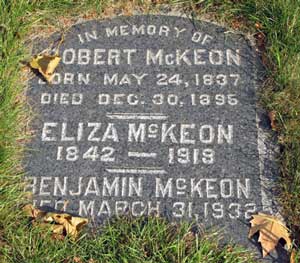
McKEON (or McCOWAN), ROBERT (1837-1896). Private, 40th New York Infantry, Company D; 87th New York Infantry, Company D. Of Irish origin, McKeon enlisted as a private at New York City on October 15, 1861, mustered into the 87th New York the next day, and was transferred into the 40th New York on September 6, 1862. He was wounded in action by Confederate fire at the Battle of Fredericksburg, Virginia, on December 13, 1862, and subsequently moved to Augur Hospital in Alexandria, Virginia, where he was discharged for disability on March 18, 1864. His last residence was 66 East 105th Street in Manhattan. Section 135, lot 27263, grave 2201.
McKEON, THOMAS KELLY (or KELLEY) (1839-1918). First lieutenant, 59th New York Infantry, Companies I and E; musician, 82nd New York Infantry, Company E. Born in Ireland, he enlisted under the name Thomas Kelly. He enlisted as a private on February 5, 1862, at New York City, and mustered into Company E of the 82nd New York Infantry the same day. He was transferred into the band as a musician on an unknown date and returned to Company E with the rank of private on August 8, 1862. He re-enlisted as a private on March 28, 1864. On July 10, 1864, he was transferred into the 59th New York Infantry, Company I, and promoted to corporal. He was promoted to sergeant and then first sergeant on December 22, 1864. On December 23, he was transferred into Company E with the rank of second lieutenant. At the time he mustered out on July 30, 1865, at Munson’s Hill, Virginia, with the rank of first lieutenant (but not mustered in at that rank), he was listed as absent/wounded at Central Park Hospital, New York City.
The 1877, 1889 and 1894 New York City Directories indicate that Mckeon was employed in the shoe business. The Veterans Census of 1890, which confirms his Civil War service, notes that he gradually lost his hearing after his service. He applied for and was granted an invalid pension in 1890, certificate 1,020,221. According to his obituary in the Daily Star, which headlines him as a Civil War veteran, he was a captain in the 59th Regiment, but his soldier records do not verify that status. A past commander of the James C. Rice Post #29 of the G.A.R., he also belonged to the Freemasons and the Royal Arcanum. He last resided at 116 Maurice Avenue in Elmhurst, Queens. McKeon died from pneumonia. Shortly after his death, Rebecca P. McKeon, who is interred with him, applied for a widow’s pension in 1918, application 1,132,520, but she died before it was certified. Section 168, lot 17431, grave 3.